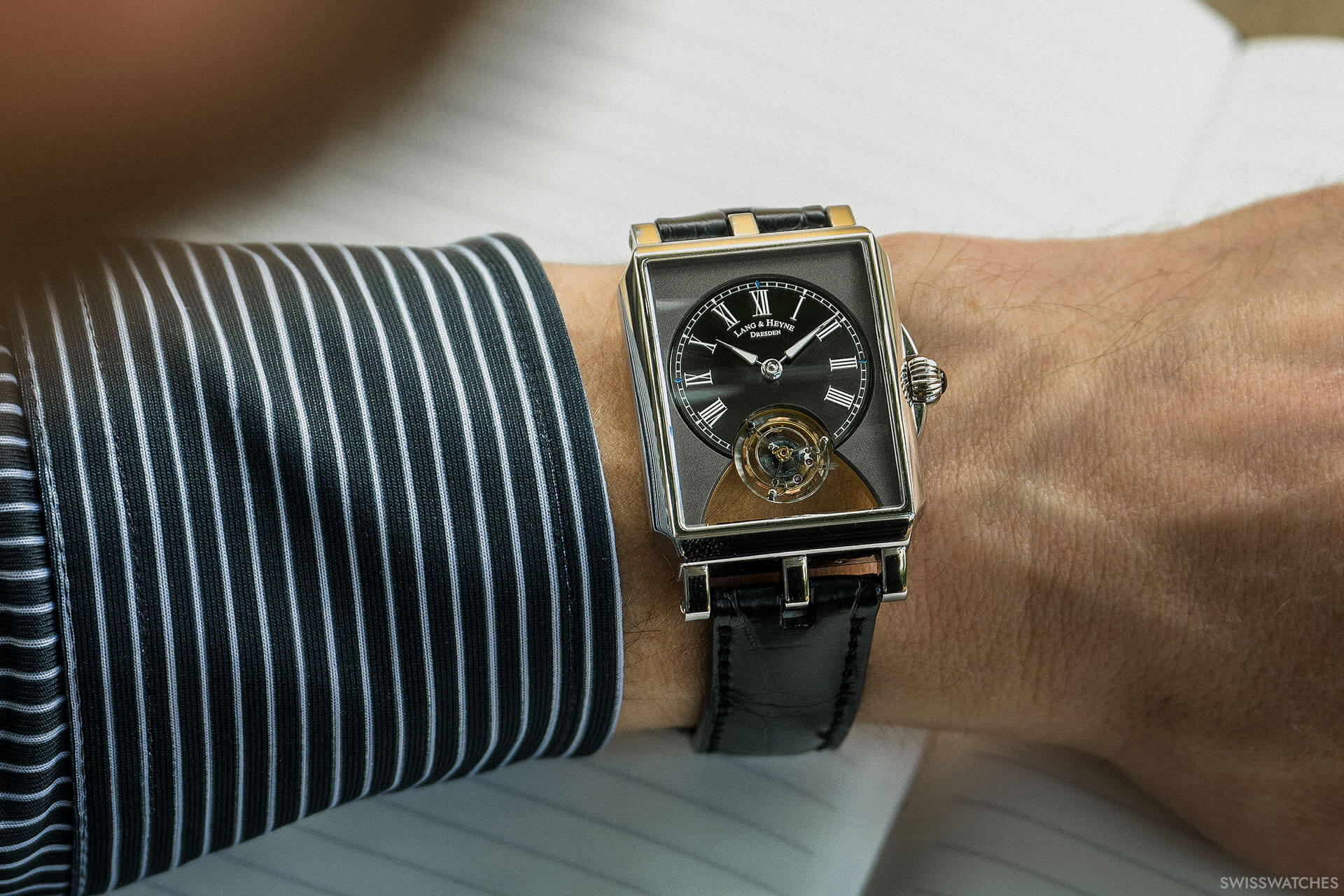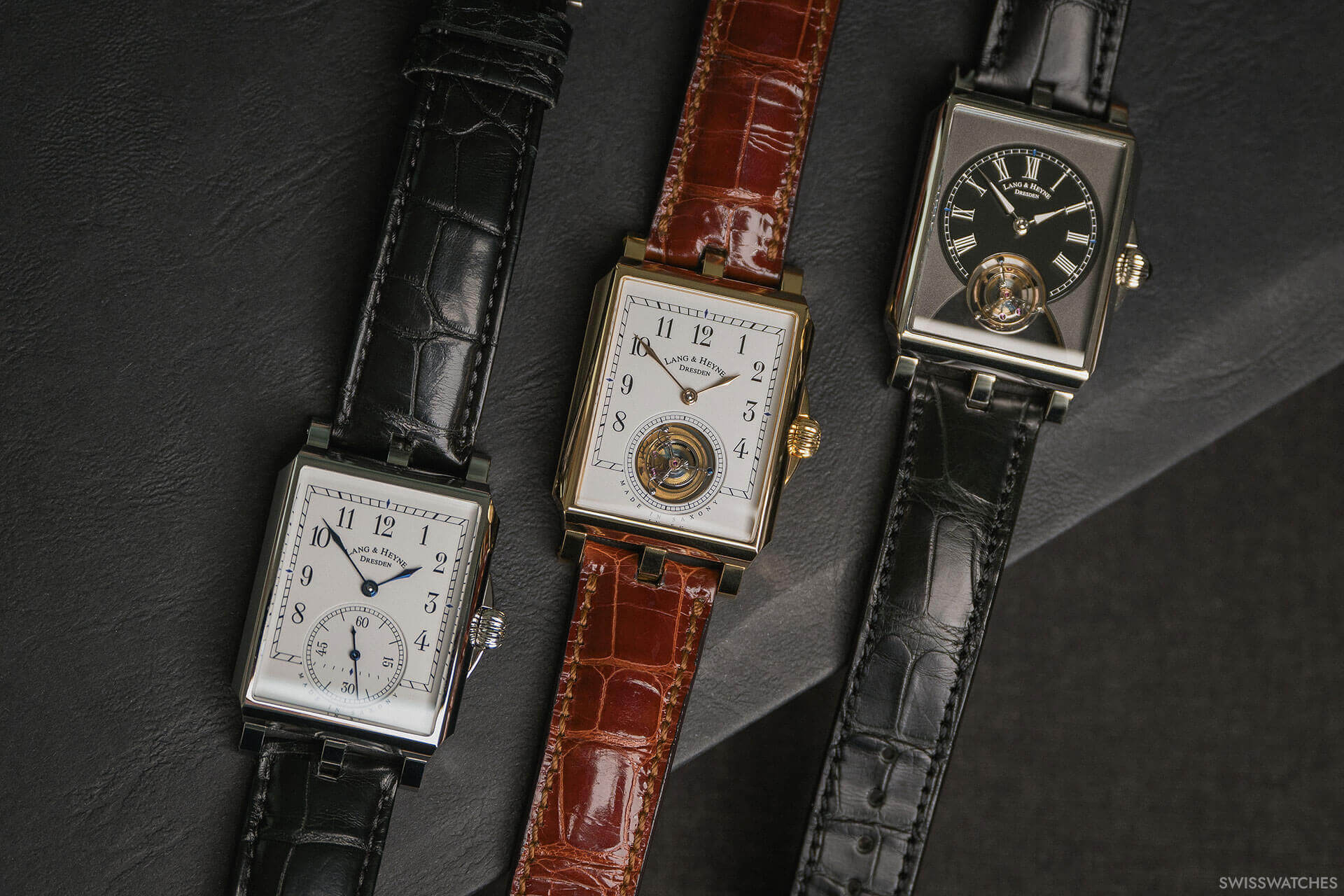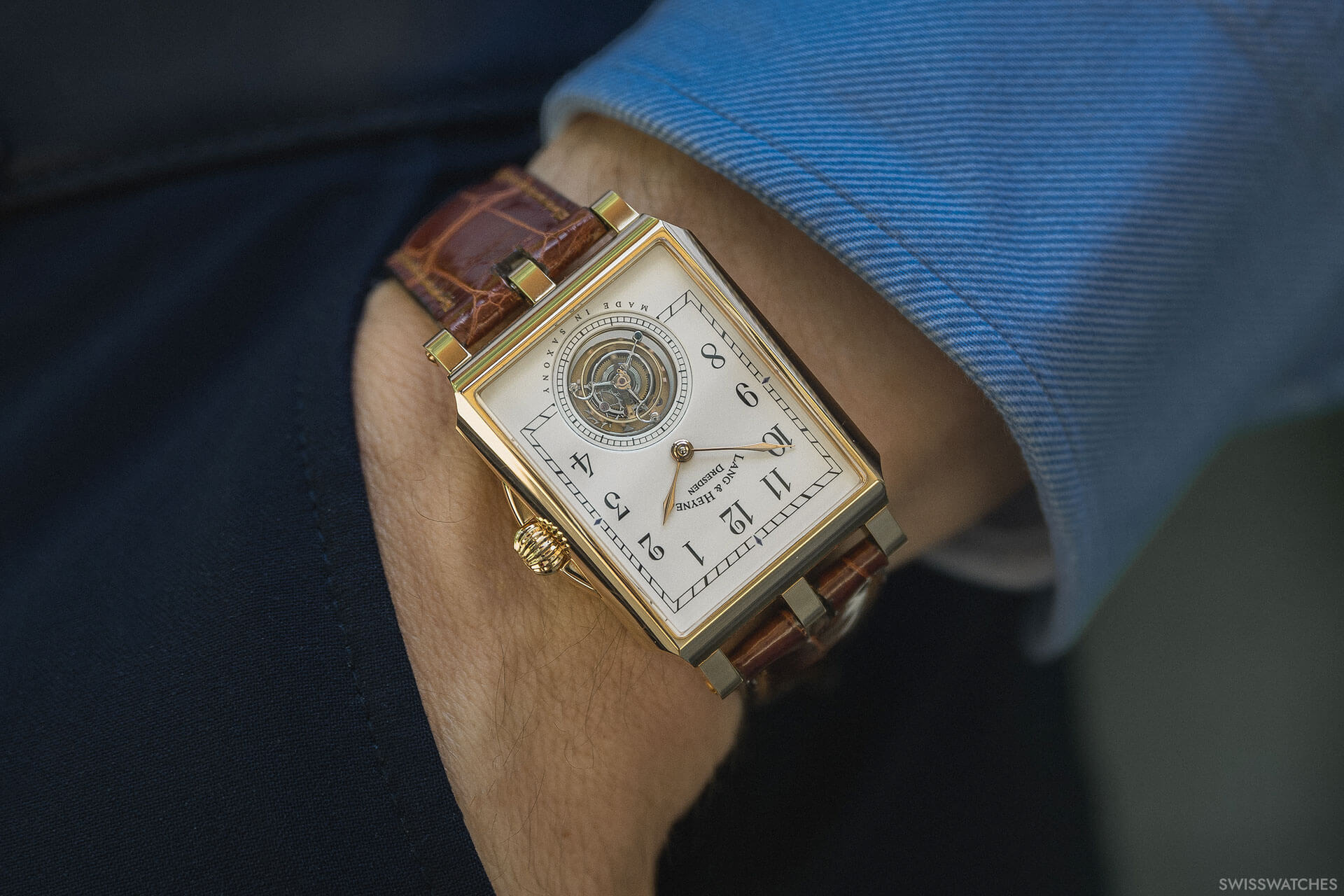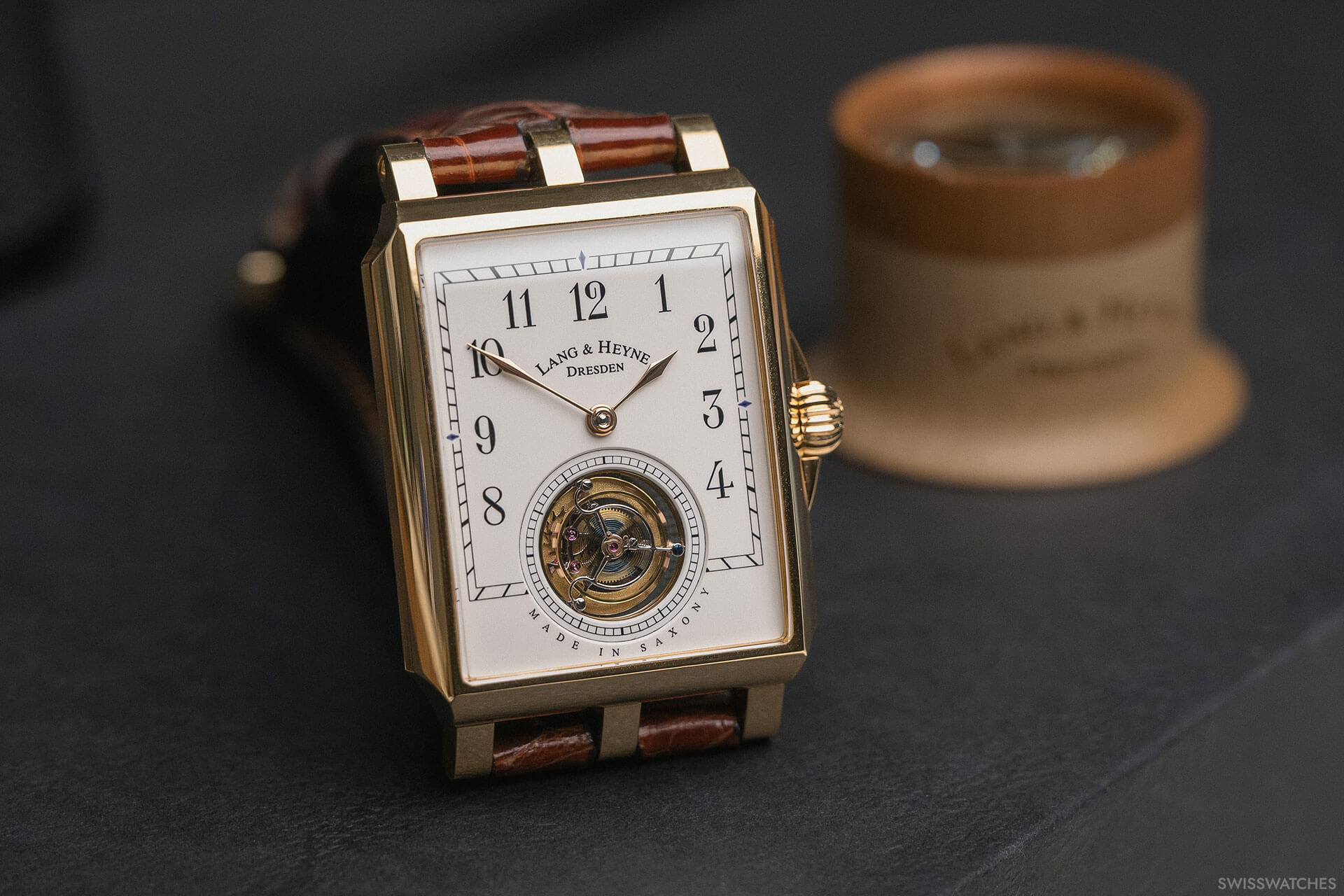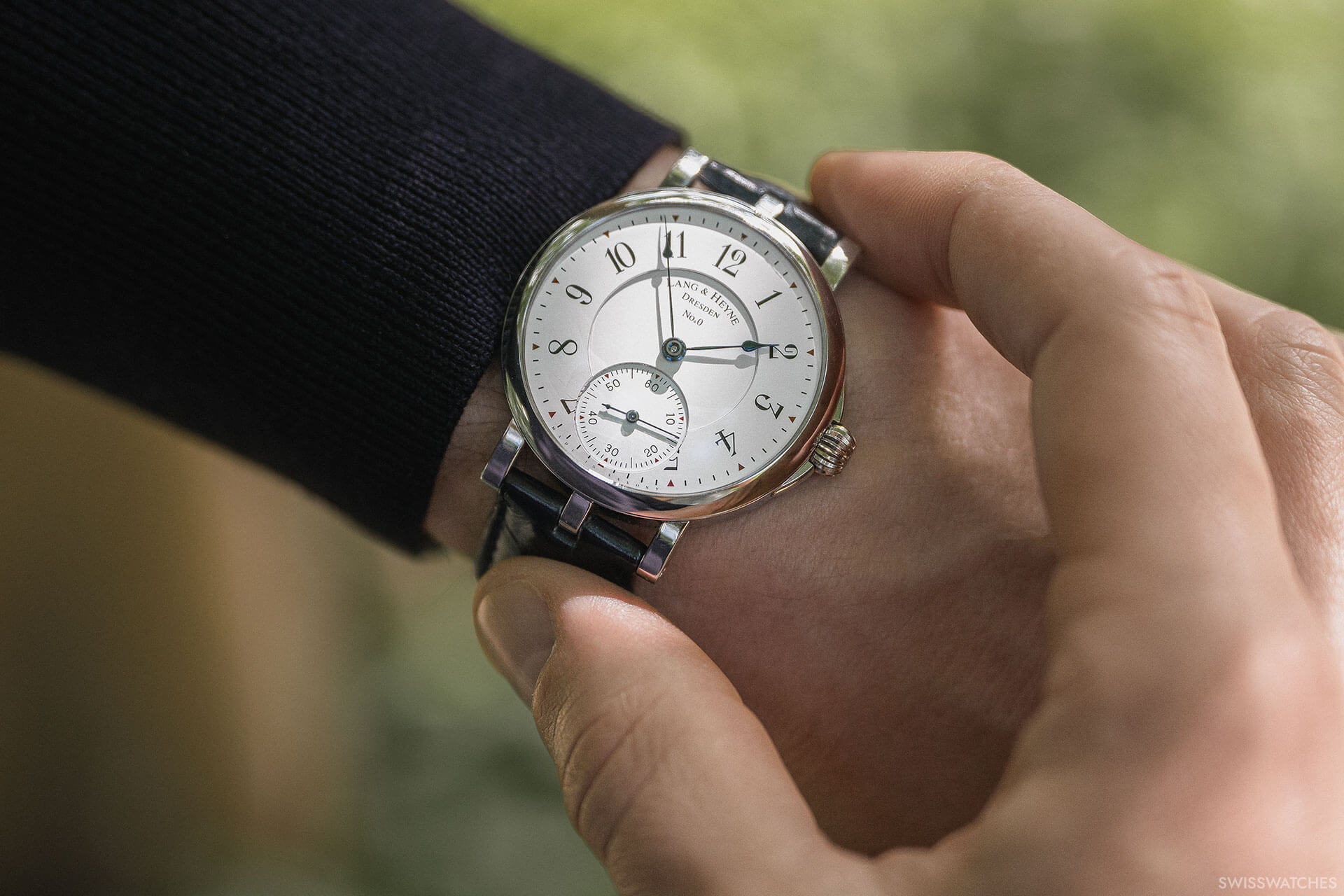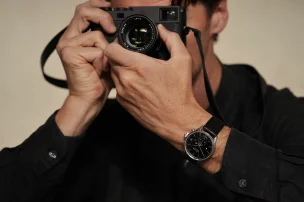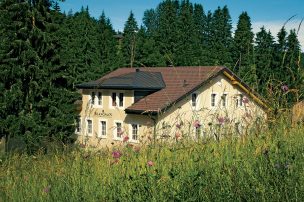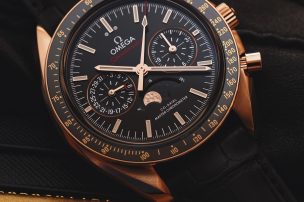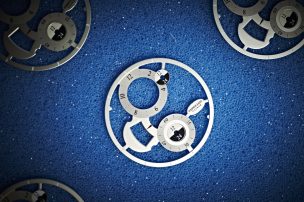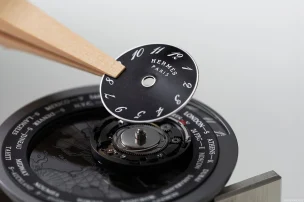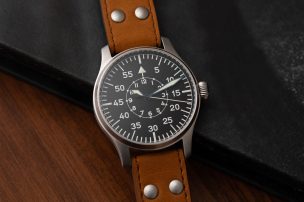
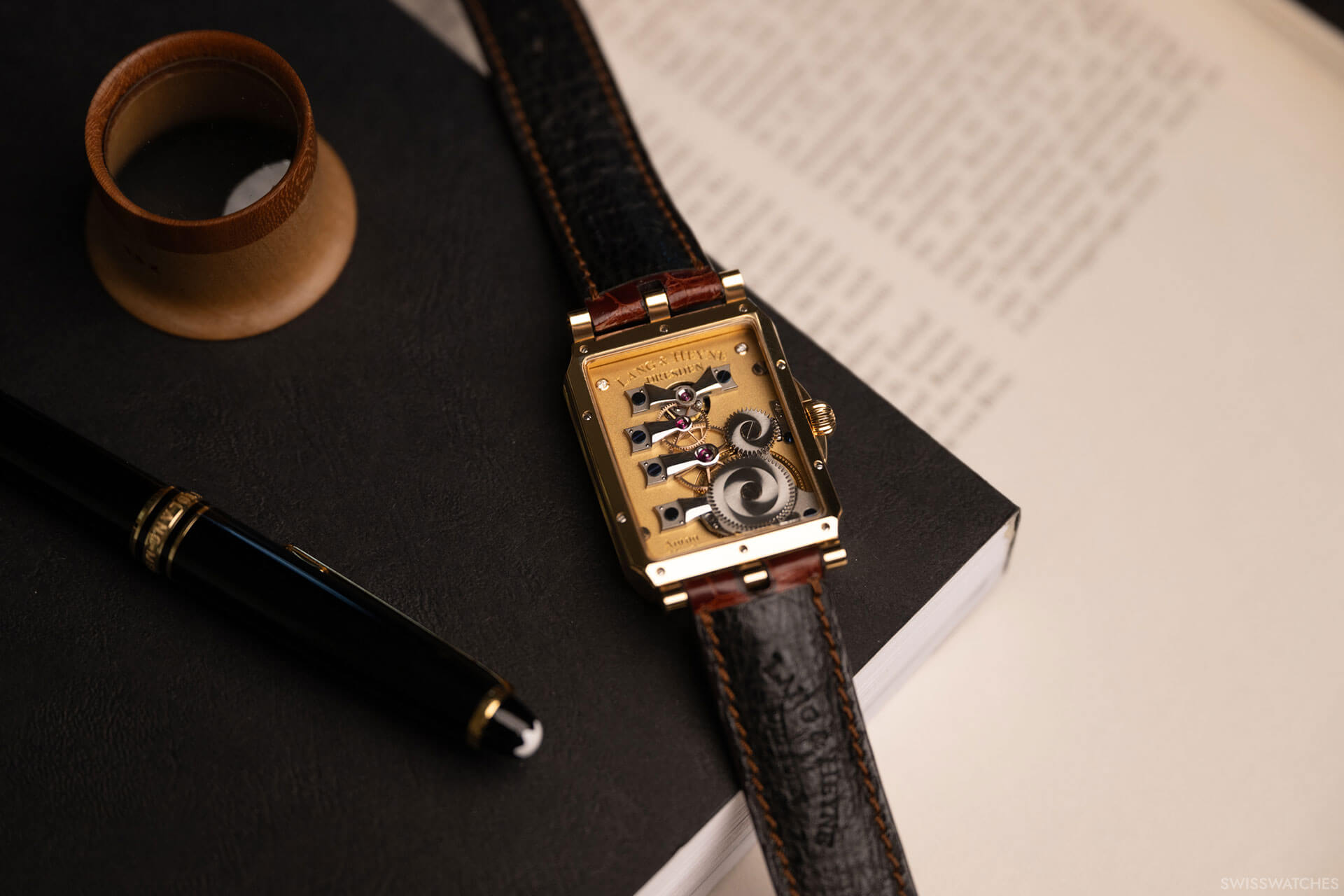
Watches Without an Expiration Date – A Visit to The Lang & Heyne Manufacture in Dresden
‘Born in Saxony’ – so goes the slogan of Lang & Heyne, a watch manufacture from the small German town of Radeberg near Dresden. It’s a name known only to true connoisseurs and watch aficionados; only around 150 watches are crafted here every year, with the utmost attention to detail. ‘Born in Saxony’ is not just a cliché marketing ploy, but a promise. With over 90 percent of the watch movement components made in-house, nearly all parts are produced in the small manufacture located in the Todenmühle, a historic building on the outskirts of Dresden, before being brought to life with intricate refinements. A trip to the manufacture transforms its guests’ perceptions of the passion and dedication that is poured into fine watchmaking. Allow us to take you into a world where appreciation for traditional watchmaking gains new meaning, and perfection is not just a requirement, but a matter of course.
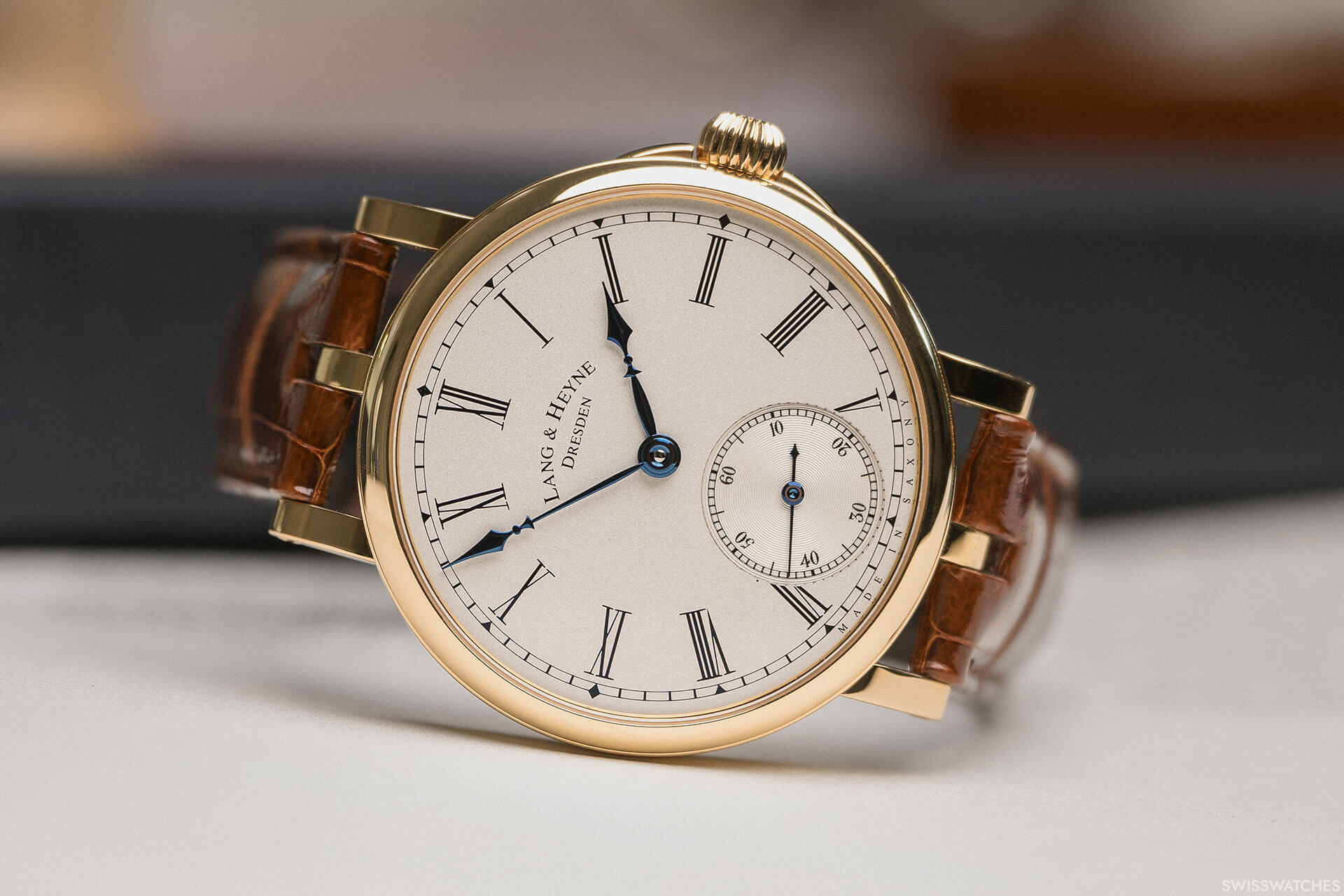
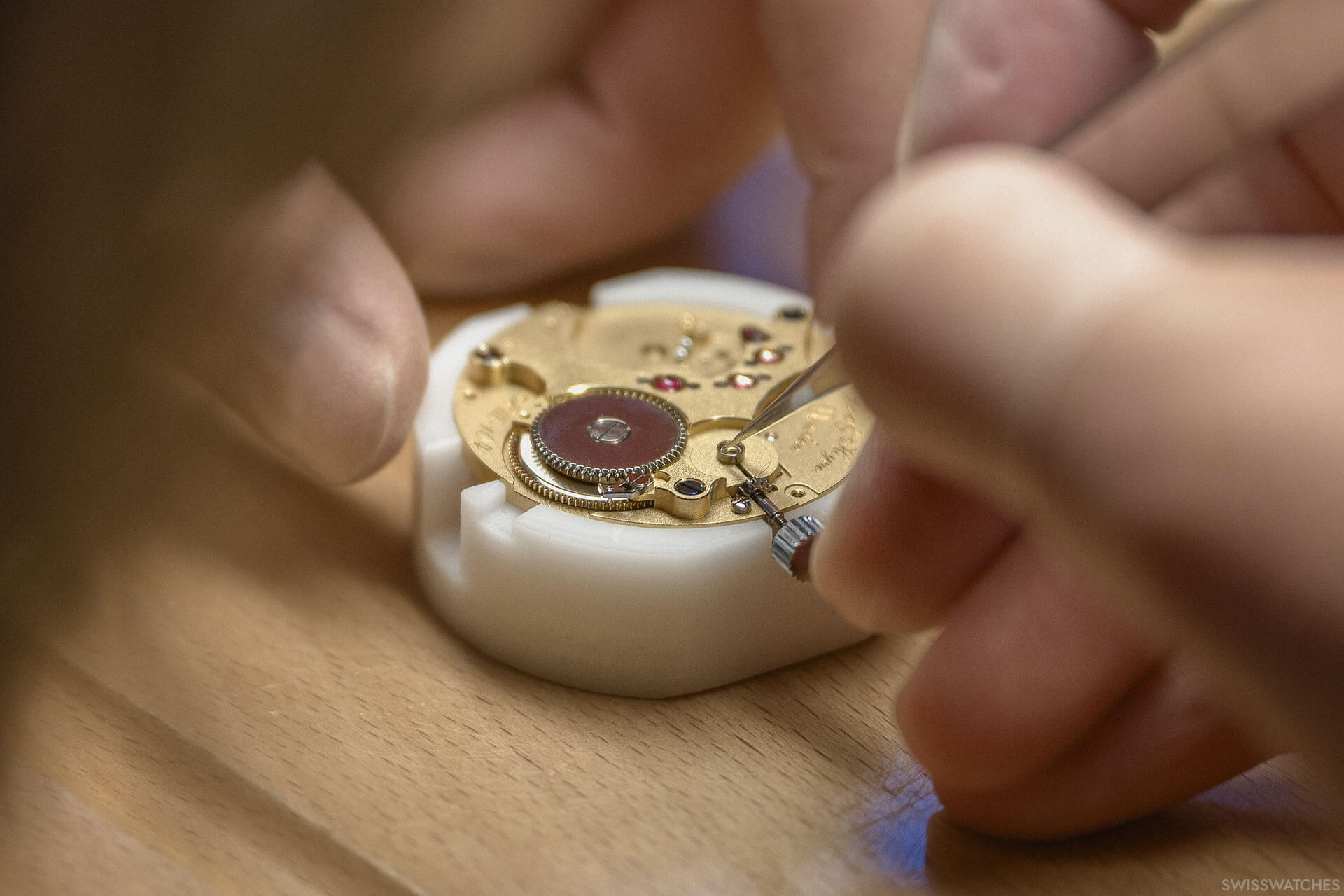
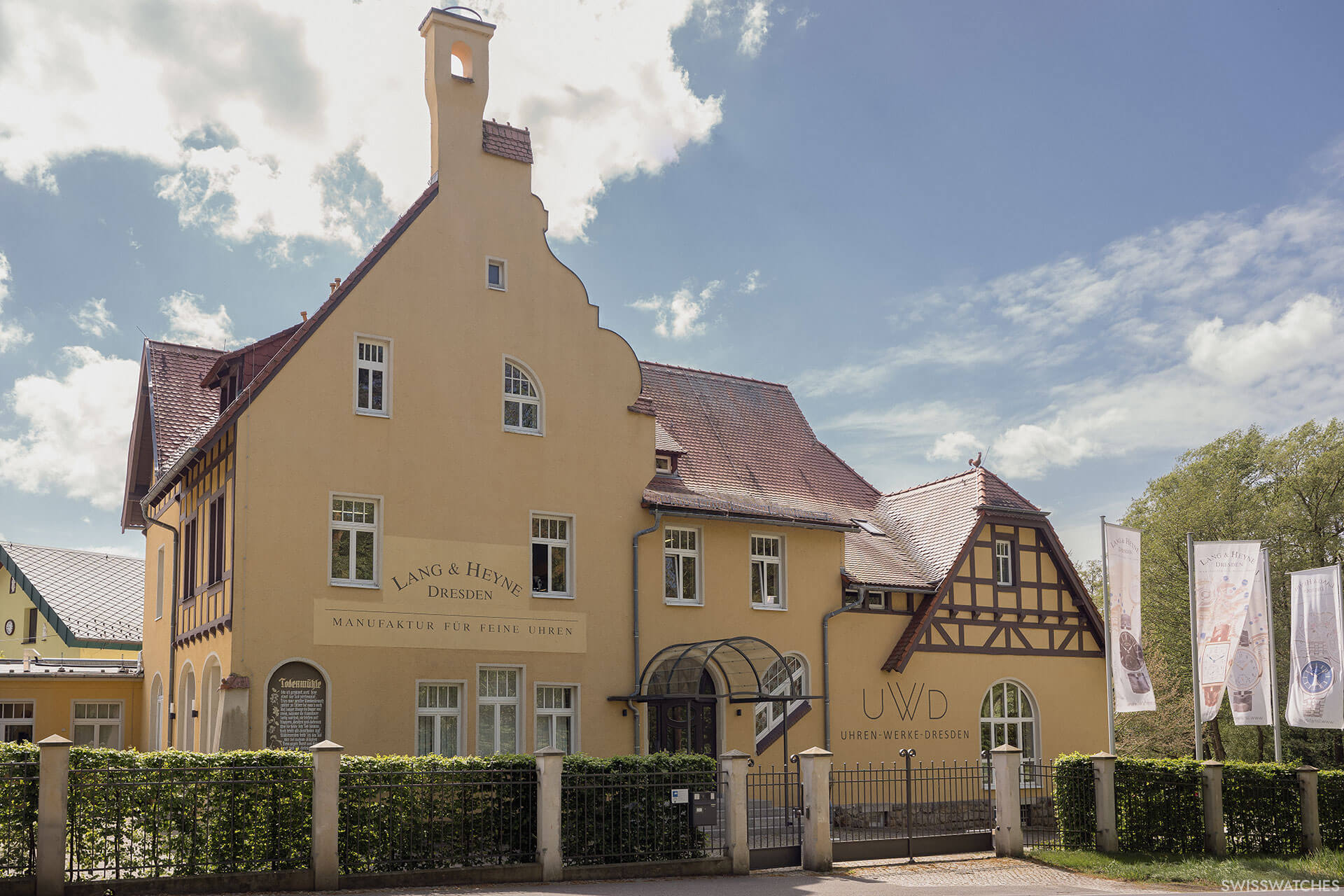
The foundation of the brand
Lang & Heyne was founded in 2001 by friends Marco Lang and Mirko Heyne with the vision of creating contemporary interpretations of the watchmaking principles and craftsmanship of 18th-century Saxon court watchmakers. Watchmakers such as Johann Gottfried Köhler, Johann Heinrich Seyffert, Johann Friedrich Schumann, and Johann Christian Friedrich Gutkaes set the standards that Lang & Heyne still follow today. However, the goal was not to copy the historical models, but to creatively rethink them.
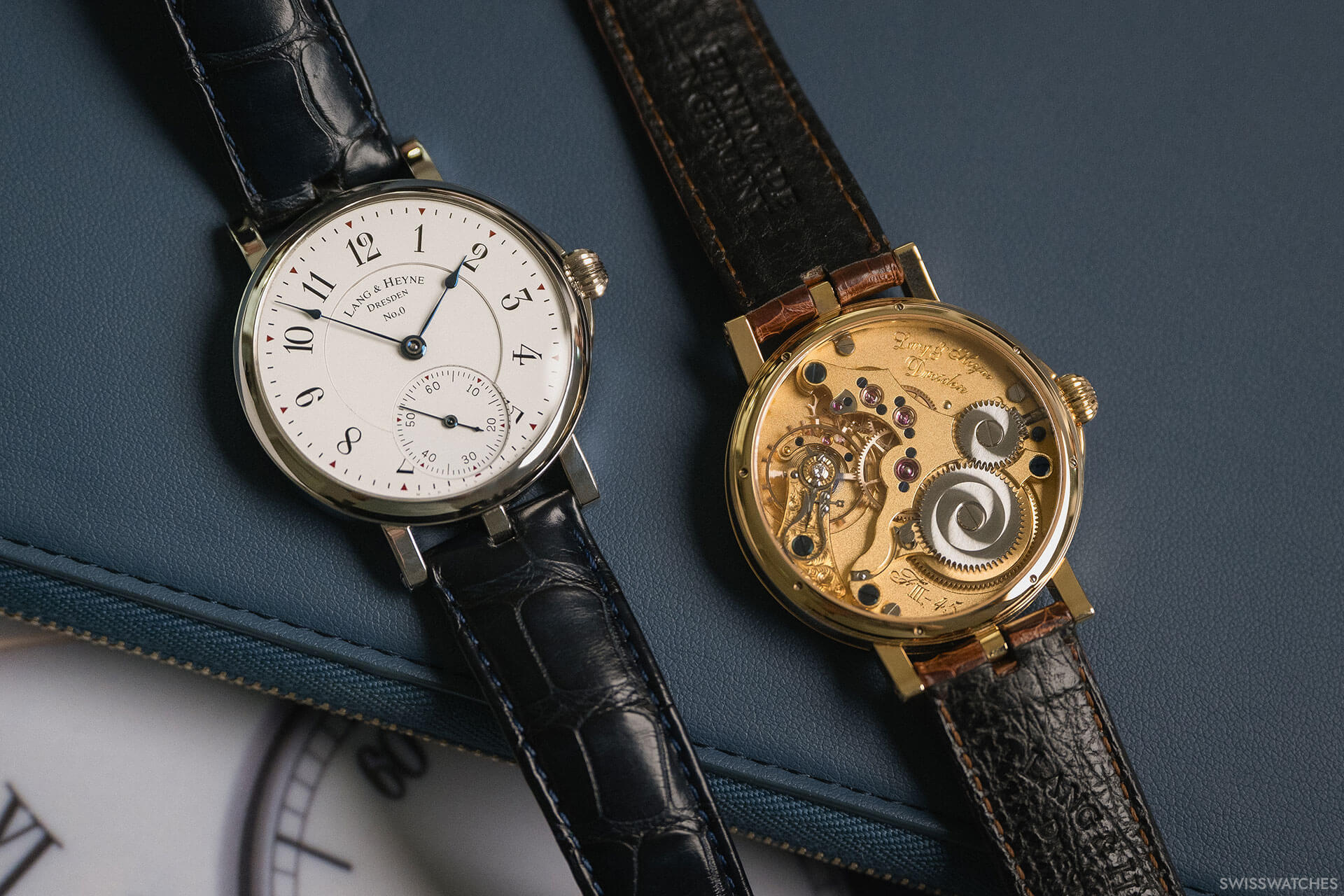
Mirko Heyne left the company a year later, but Marco Lang, a watchmaker from a family of watchmakers, continued to run the manufacture. In 2013, Lang sold the company to entrepreneur and watch enthusiast Ulrich L. Rhode and his Tempus Arte Group but continued as a watchmaker until 2019, developing nine different calibres. Today, the experienced watch manager Alexander Gutierrez Diaz heads the operational business of Lang & Heyne as Managing Director.
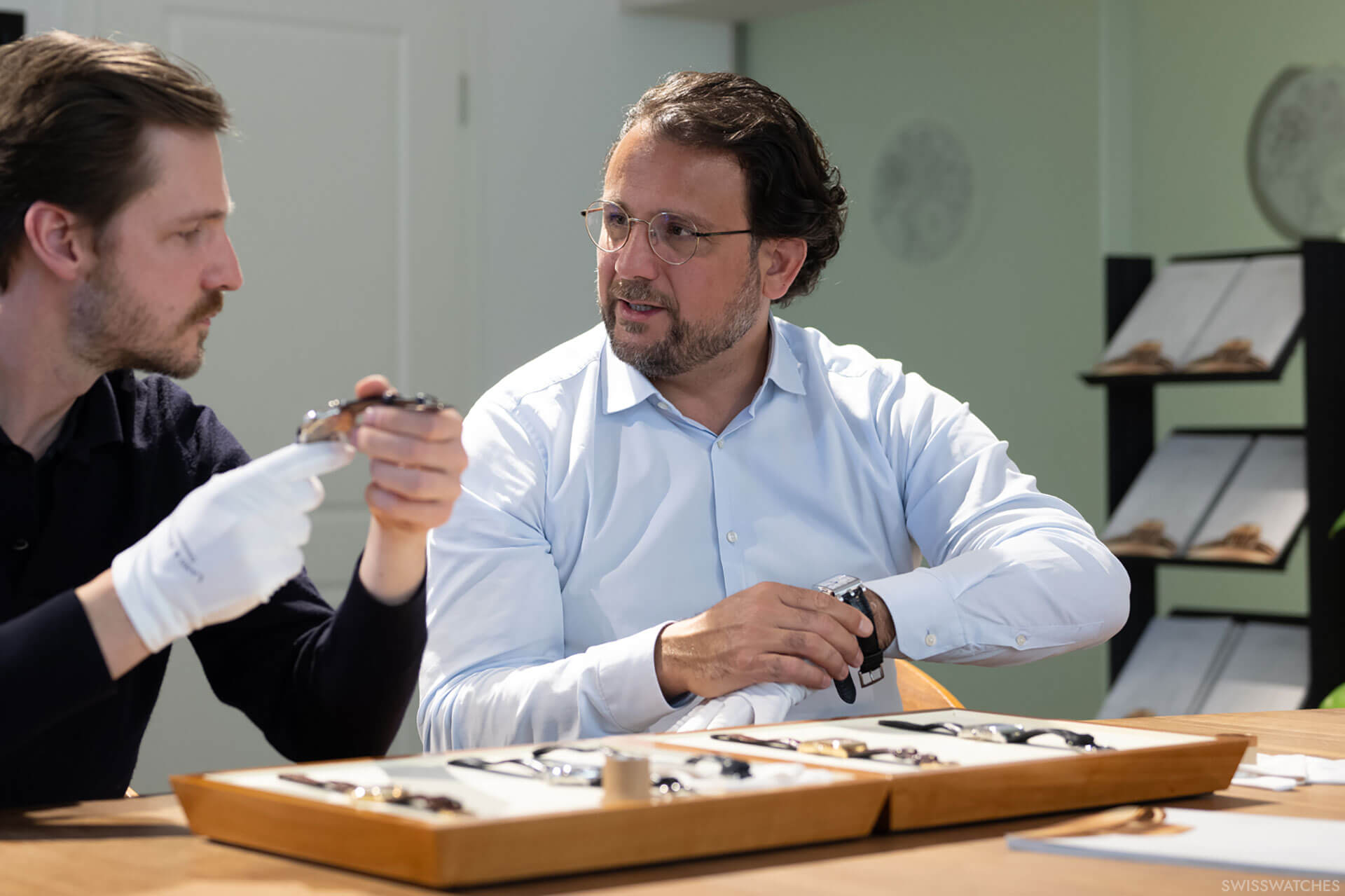
Nico Bandl (left) and Alexander Gutierrez Diaz (right)
Lang & Heyne slowly but steadily increased production from about 30 watches in 2013 to around 150 in 2024, prompting a move in 2018 from Dresden to the historic Todenmühle in Radeberg. Four million euros were invested in the expansion of the manufacture and new machines. The old Todenmühle was revitalised with a light-flooded extension, housing a state-of-the-art milling machine.
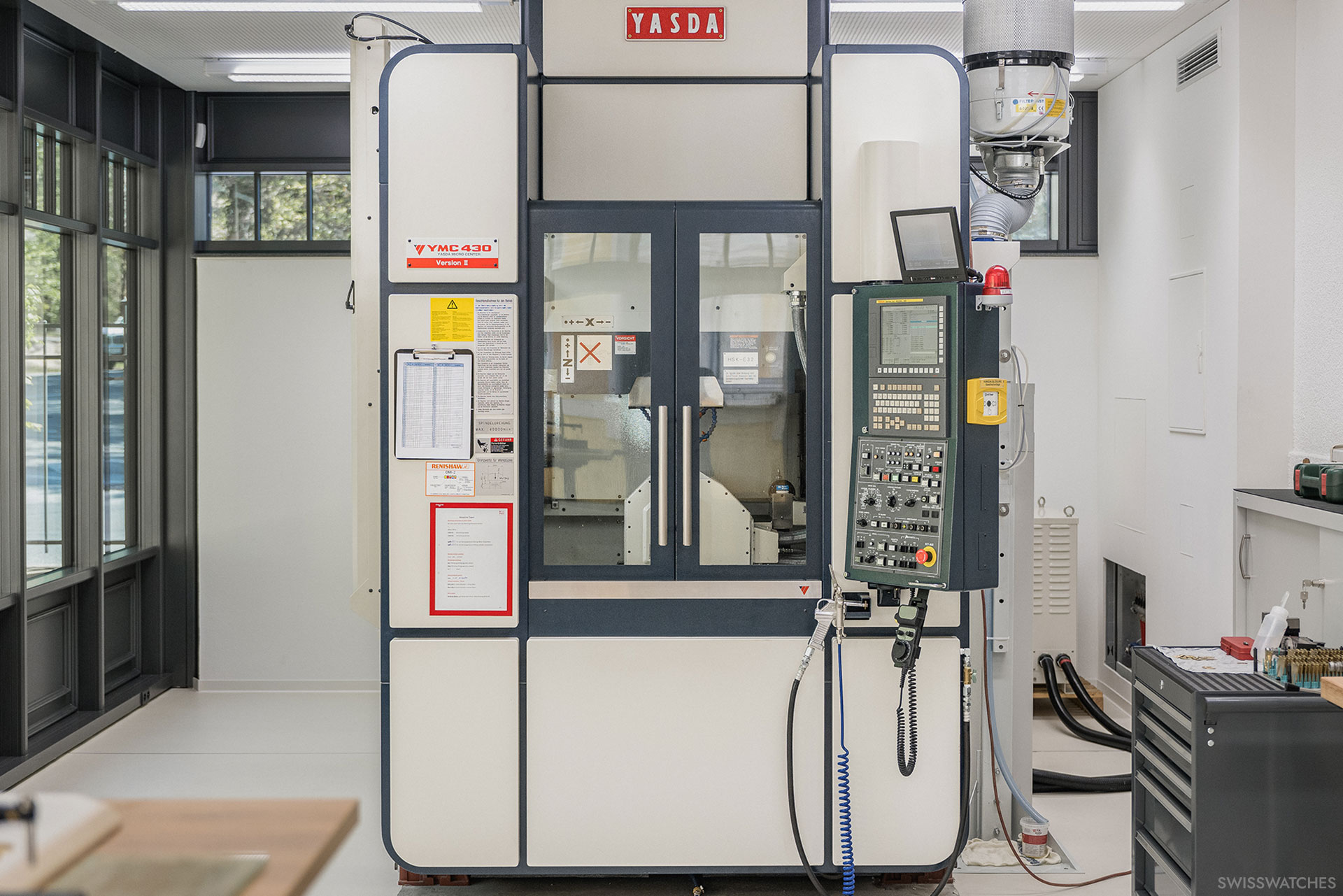
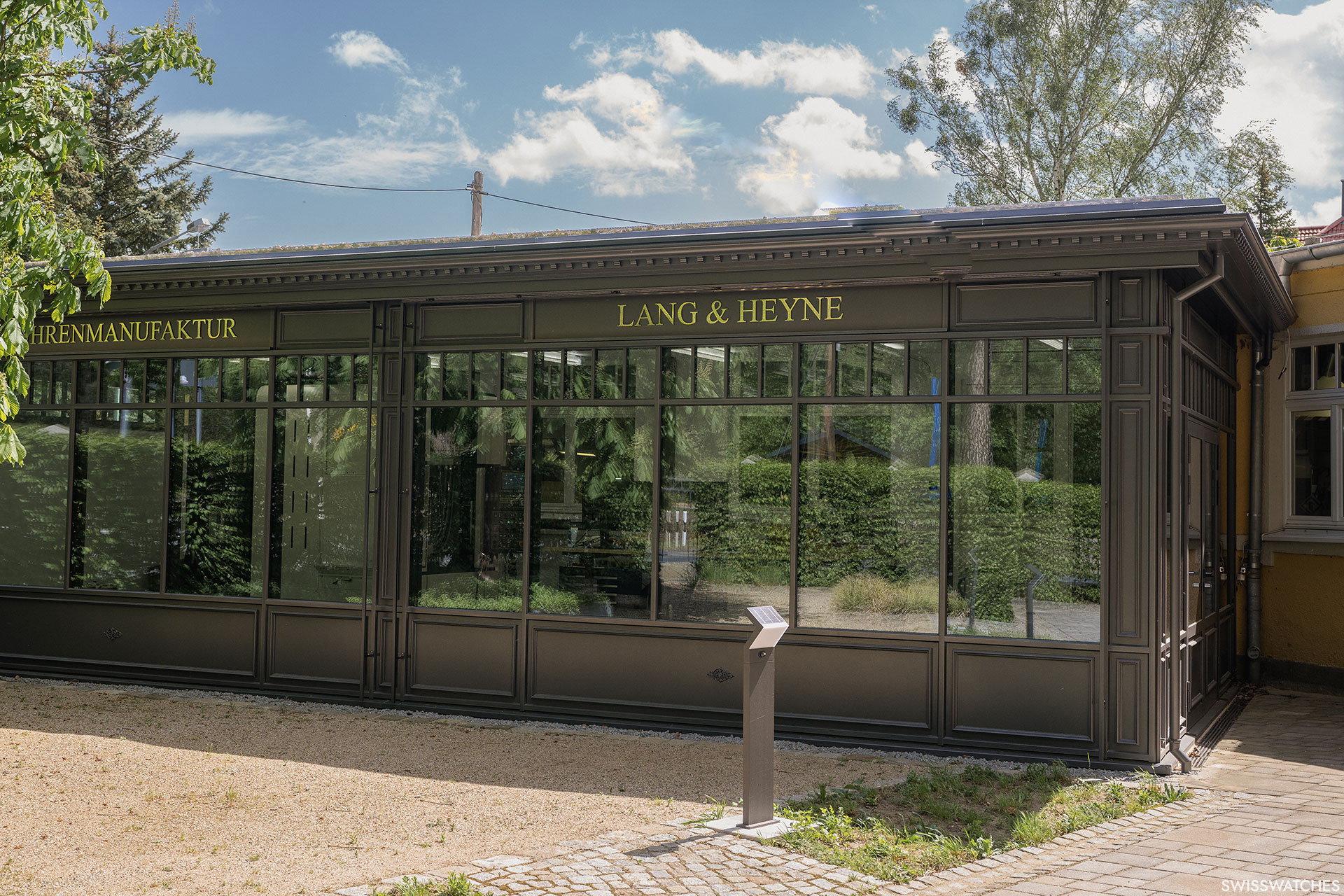
Jens Schneider – A Stalwart of Saxon Fine Watchmaking
The name Jens Schneider is probably as unknown in the watchmaking world as Lang & Heyne, fitting well to his modest personality. However, you should take heed of his name. After Marco Lang left the company in 2019, Jens Schneider took over as Head Watchmaker and Head of Development. Schneider had worked at VEB Glashütter Uhrenbetrieb, A. Lange & Söhne, and Moritz Grossmann. During his time at A. Lange & Söhne, he worked closely with Walter Lange and Günter Blümlein, contributing significantly to the development and production of the Zeitwerk. Schneider loved tinkering with steam engines and locomotives as a child. His grandfather was a locksmith and mechanic, and Schneider himself is an engineer through and through.
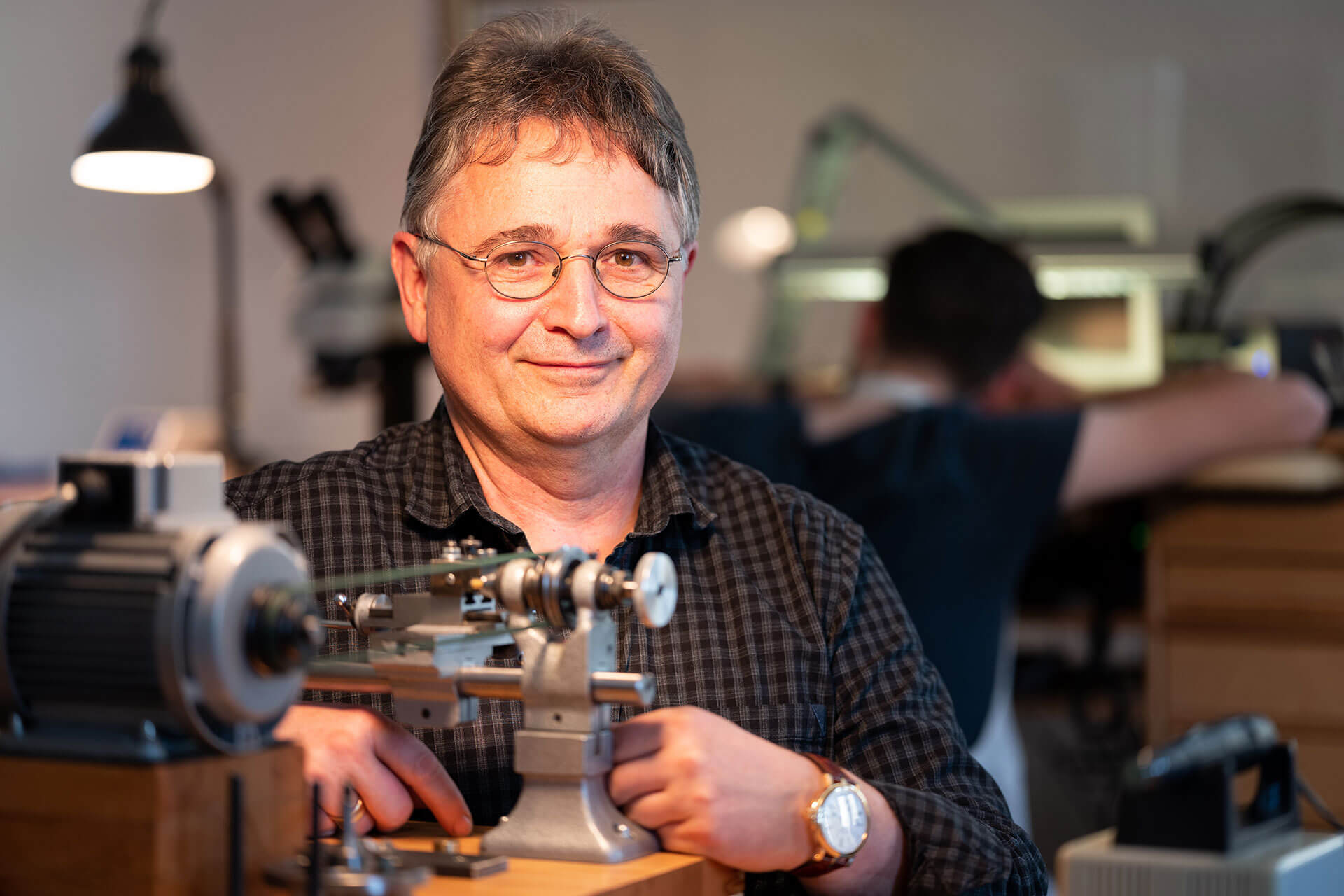
Schneider, now a champion of Saxon fine watchmaking, is calm and grounded. He dedicated half a day to guiding me through the manufacture, meticulously explaining every step and machine as if I were about to start working there. It’s a nice thought, but one that I’ll leave to the experts. In an interview about Lang & Heyne watches, he once said, “Our watches should have no expiration date.” This aptly summarises Schneider’s approach to watchmaking.
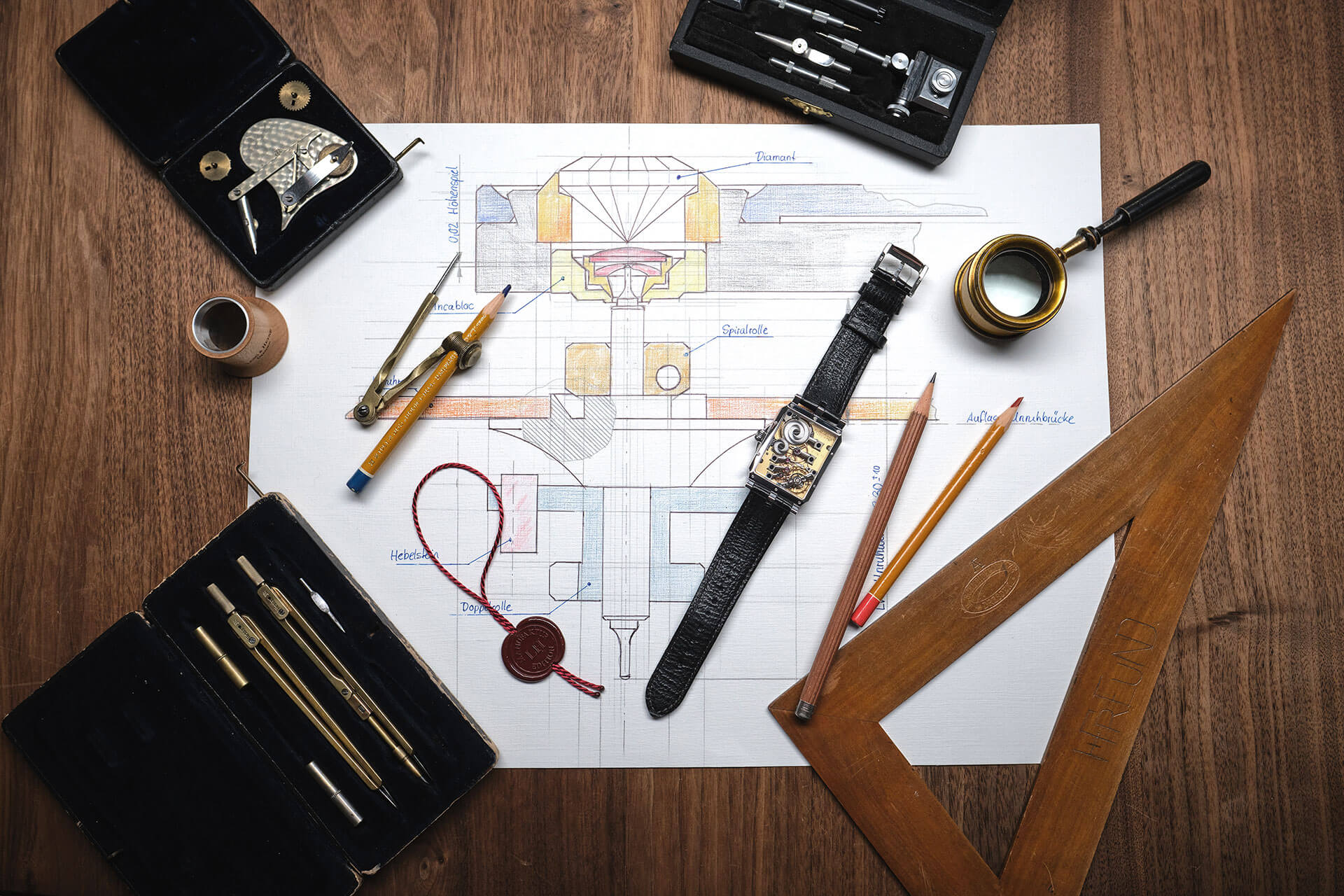
The movement: Over 90 percent produced in-house
The Lang & Heyne manufacture resembles a workshop, with many old machines from Ruland and Schaublin, often over 70 years old and no longer produced. Few watch companies work so traditionally today that it’s worthwhile them manufacturing with such machines. Yet here they are. Besides these watchmaking machines, there are more mechanical rotating machines, with which mechanics regularly make new tools such as holders and press stamps specifically for new movement components.
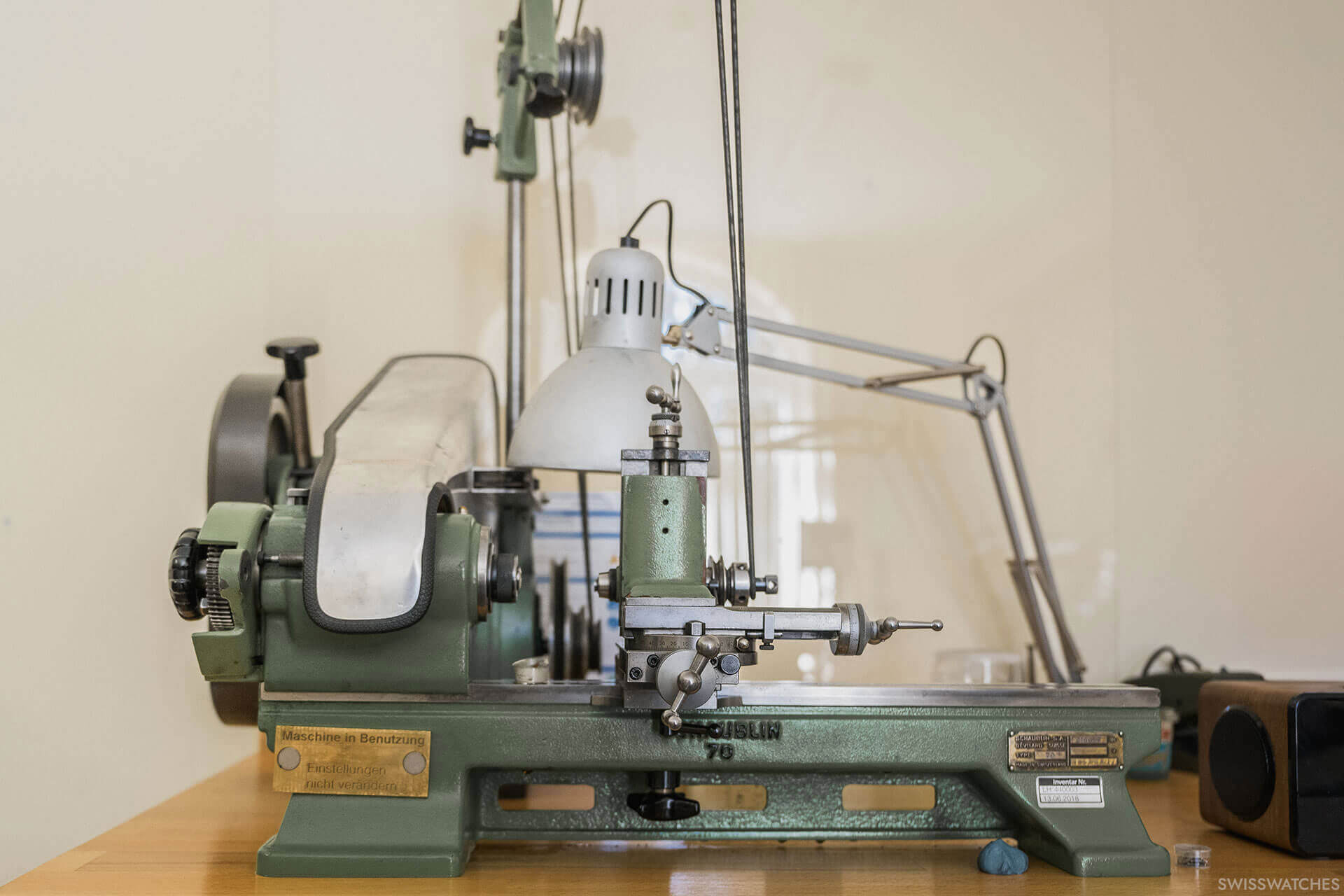
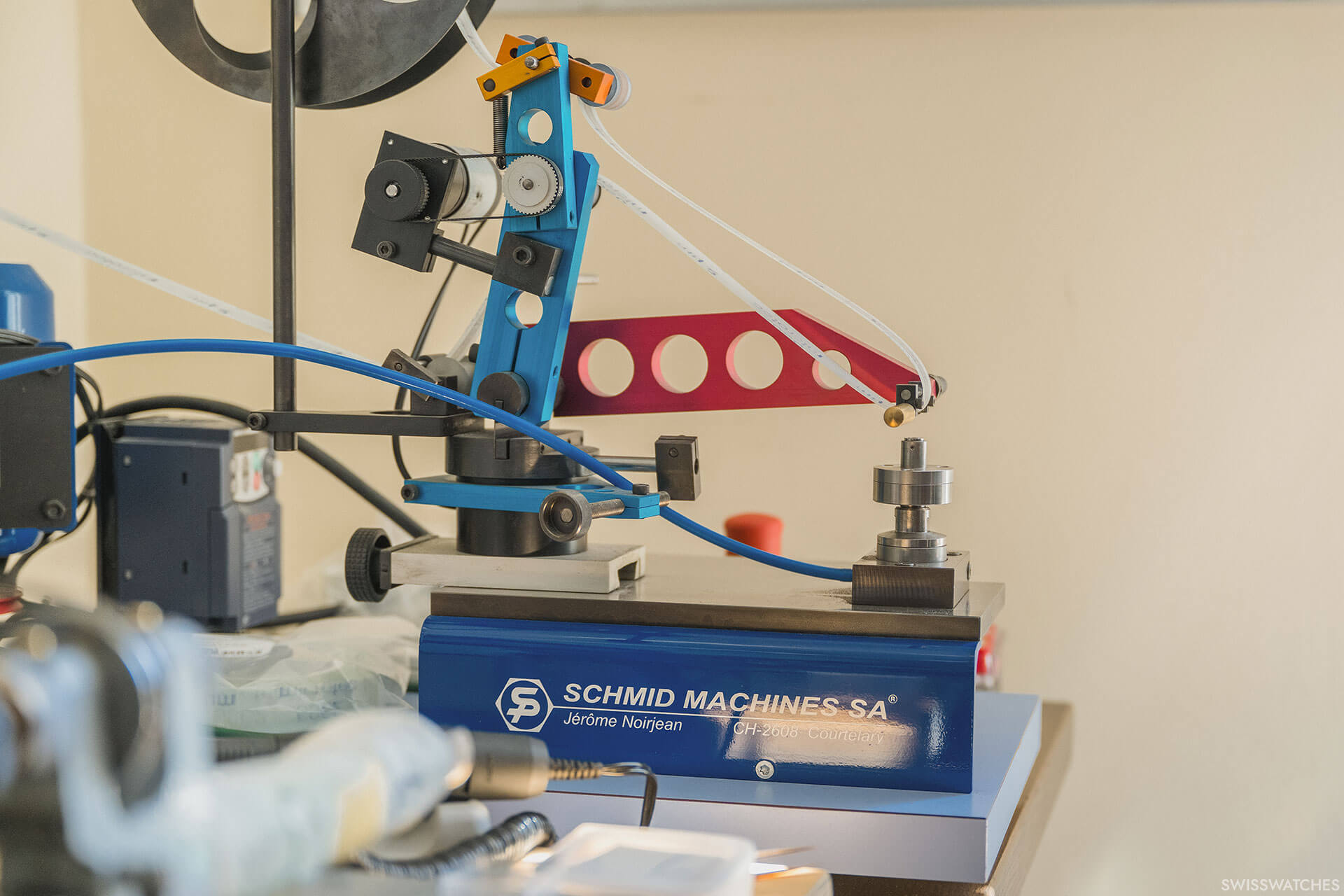
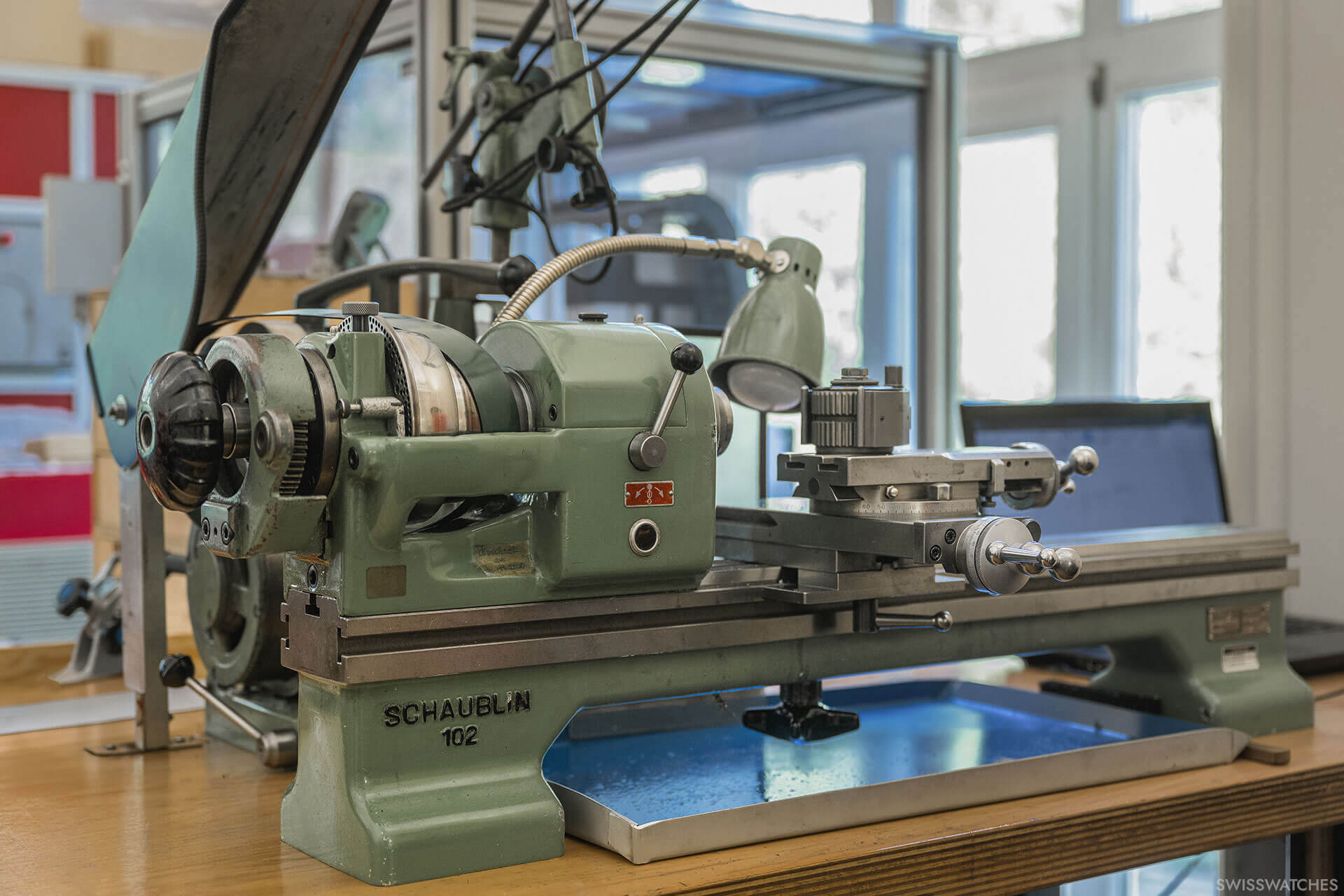
With such a high-quality level of production, plates, bridges, cocks, gears, wheel trains, as well as escape wheels and pallets are made in-house. Every movement part is laboriously hand-finished, even the invisible ones, requiring many tools and machines for polishing, circular graining, sunray finishing, or the extremely intricate black polishing.
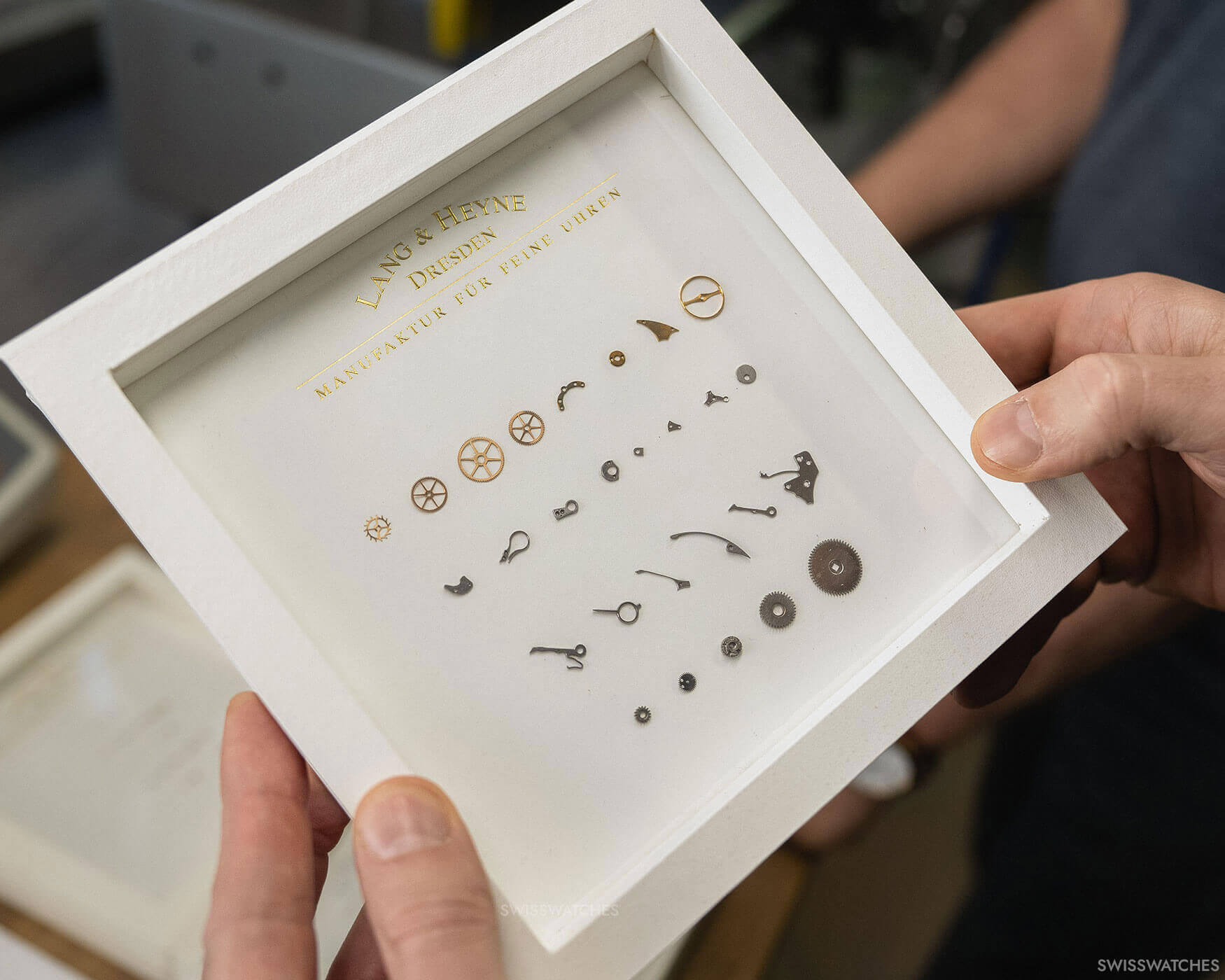
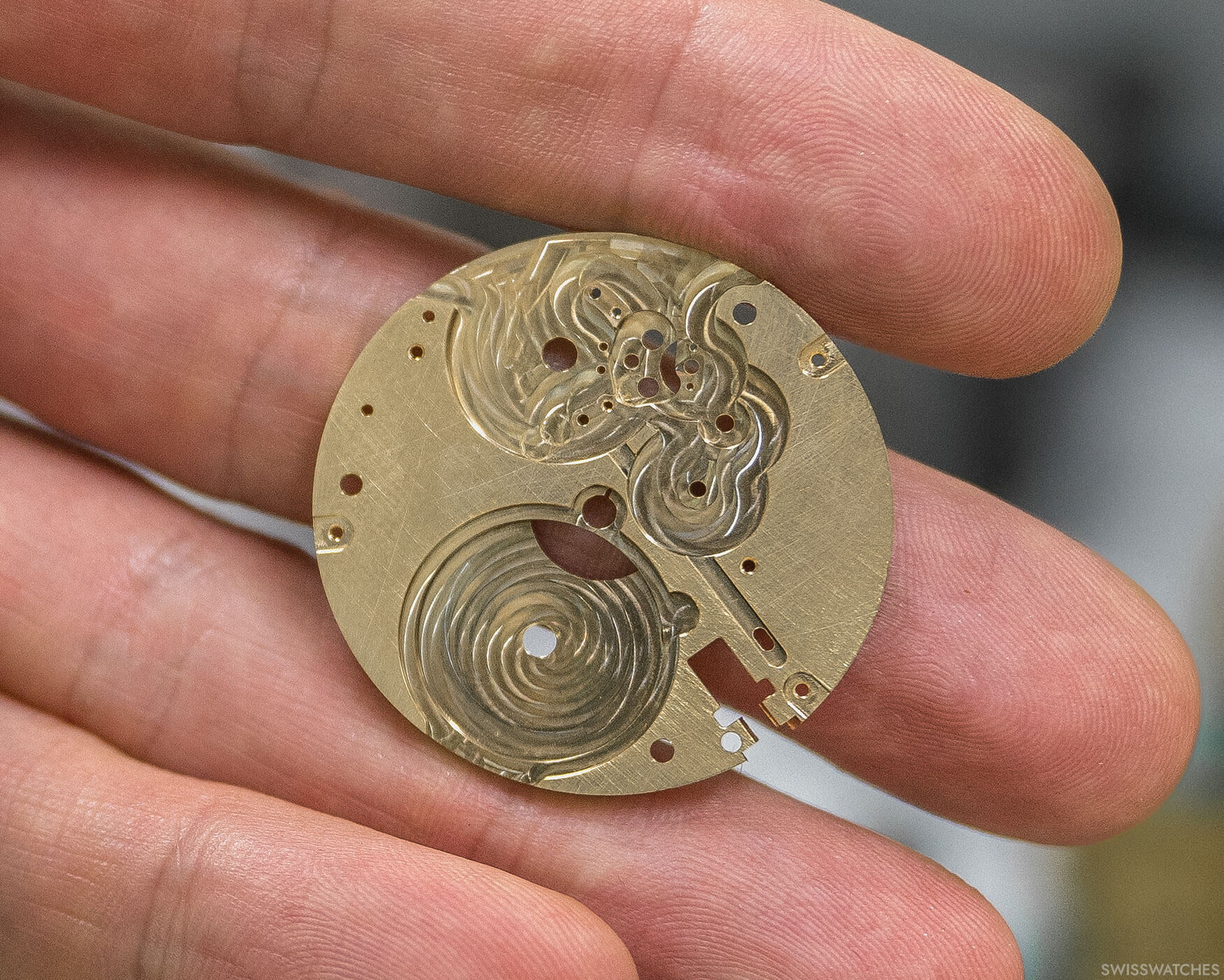
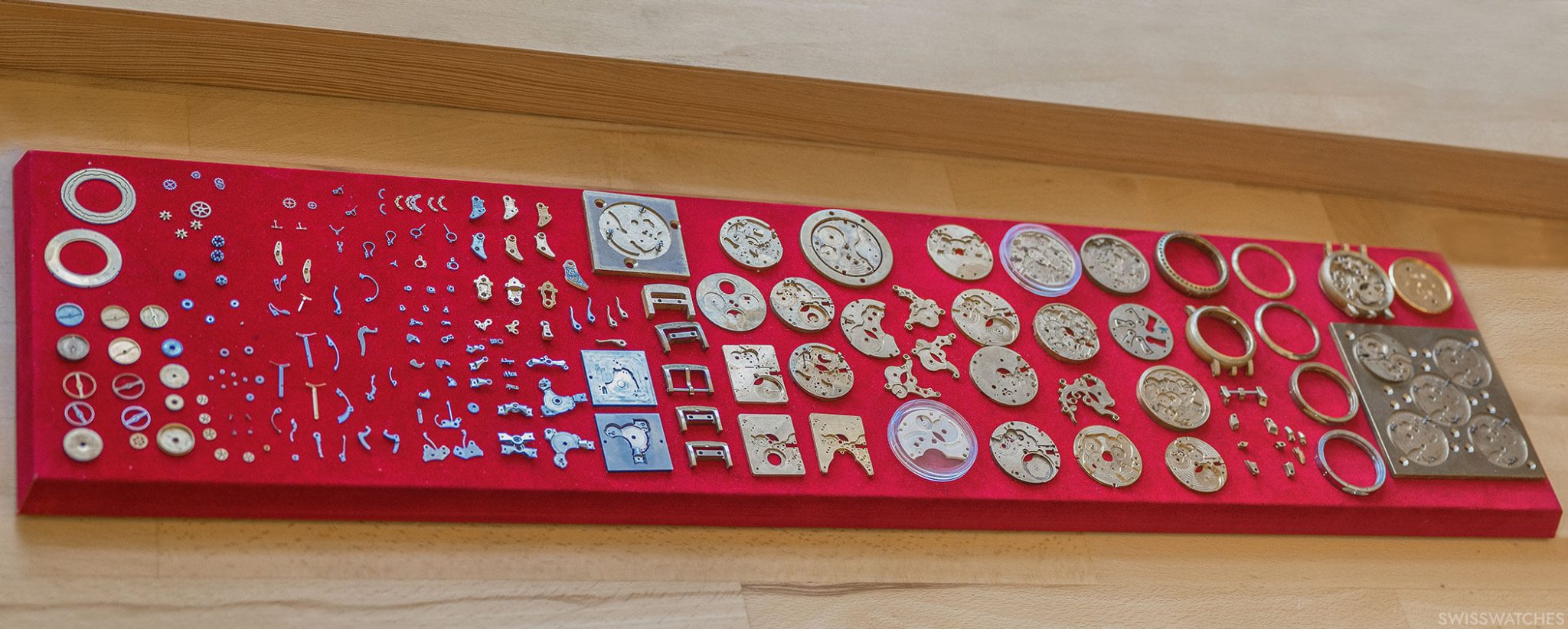
Achieving the right polish involves various polishing compounds and carriers. The materials used for the polish are crucial. The polishing compound is usually a wax-bound powder applied to a wooden or even metal carrier. For brass polishing, linden wood is suitable. For steel, cherry wood is best. For the highly intricate black polishing, where even the smallest scratches are removed to prevent light reflection, tin is the optimal polishing carrier. There is no handbook for this – everything is based on years of experience and practice to achieve the desired polish.
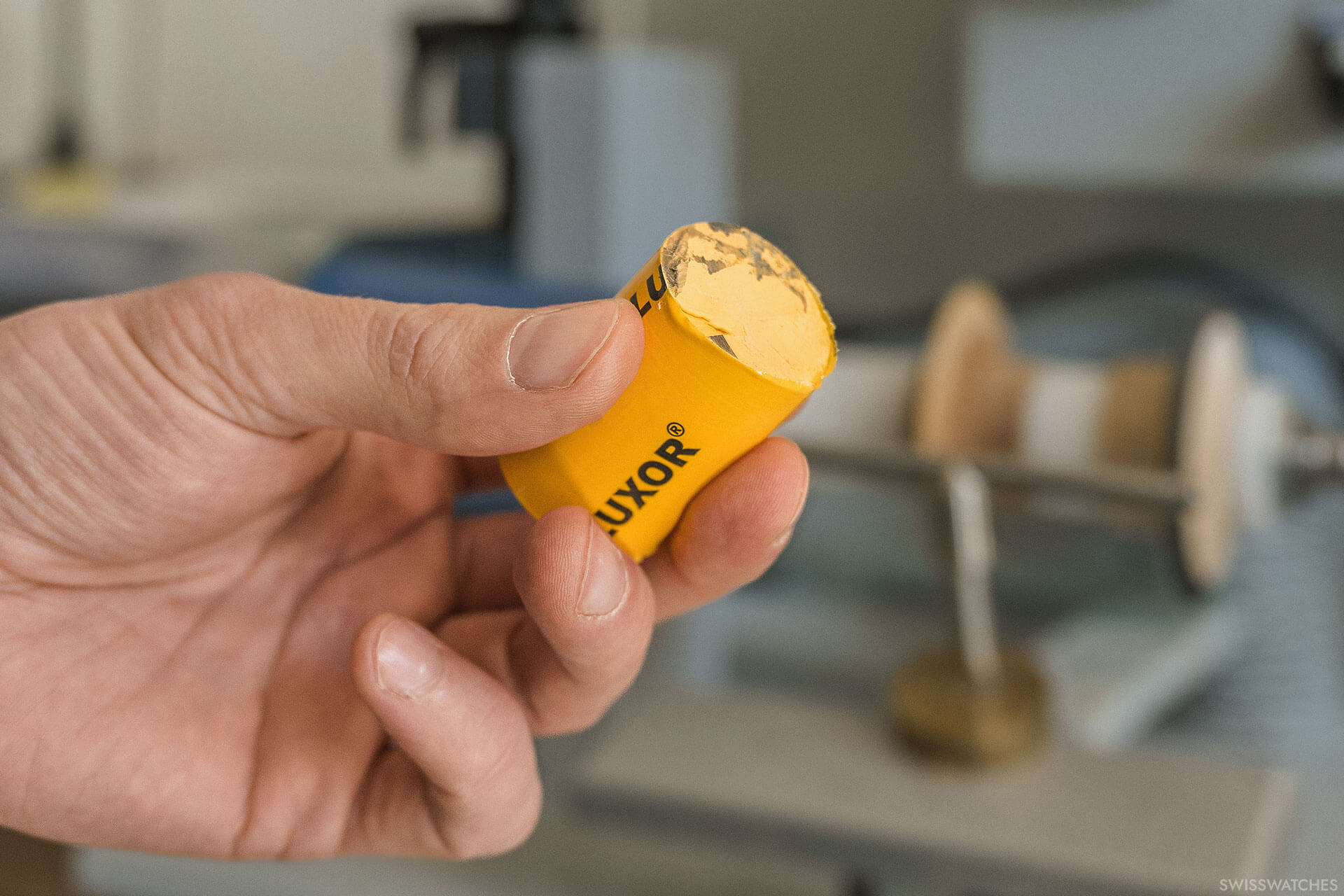
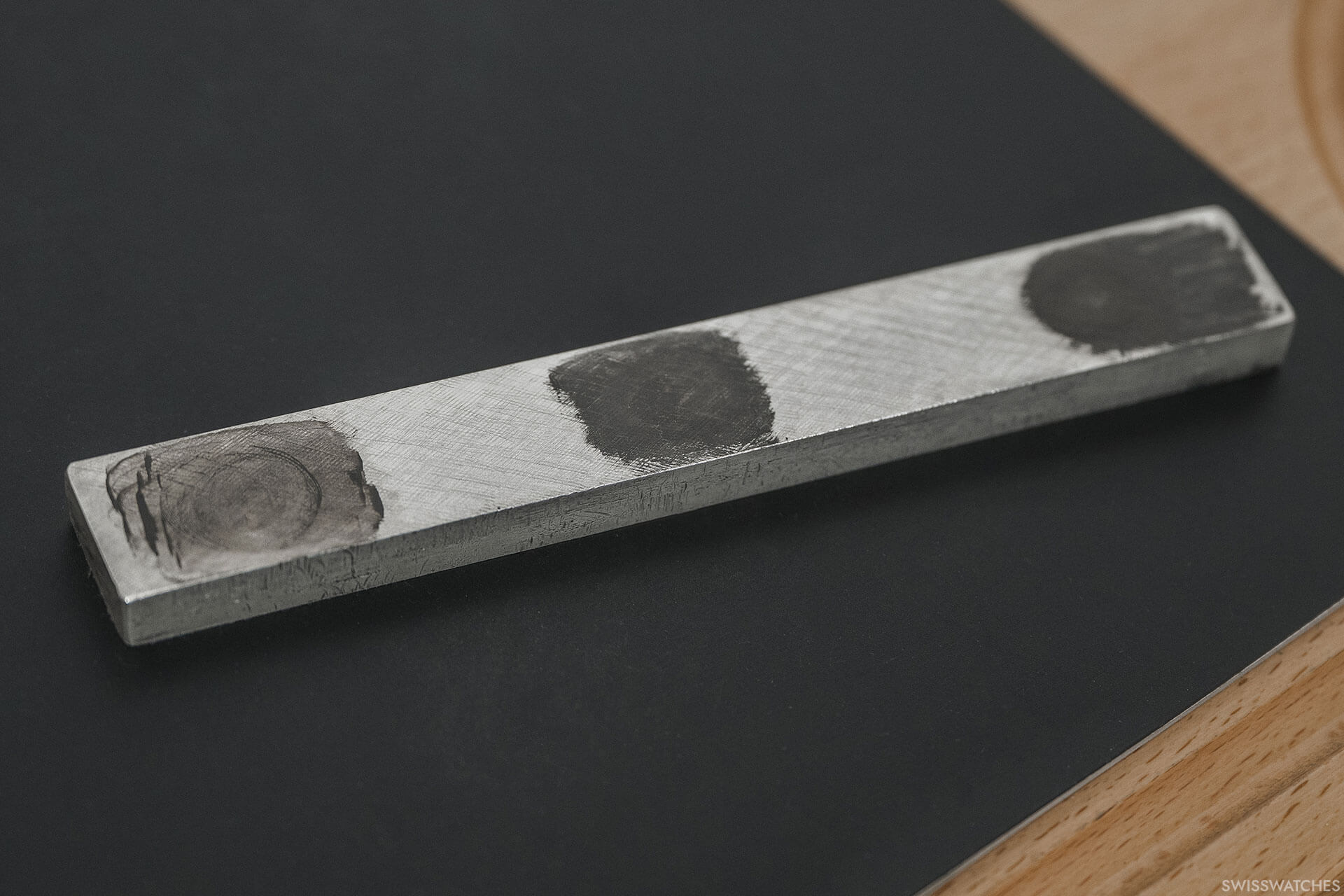
The balance spring
With such high craftsmanship, one might expect the balance spring to be made in-house, as neighbouring Lange from Glashütte has done since 2003. But, Schneider explains, given the low volume and small size of the manufacture, it wouldn’t be worthwhile to make the spring themselves – the machines and ovens needed would fill the entire manufacture, leaving no room for other machines. Additionally, the acquisition costs are too high for 150-200 watches a year.
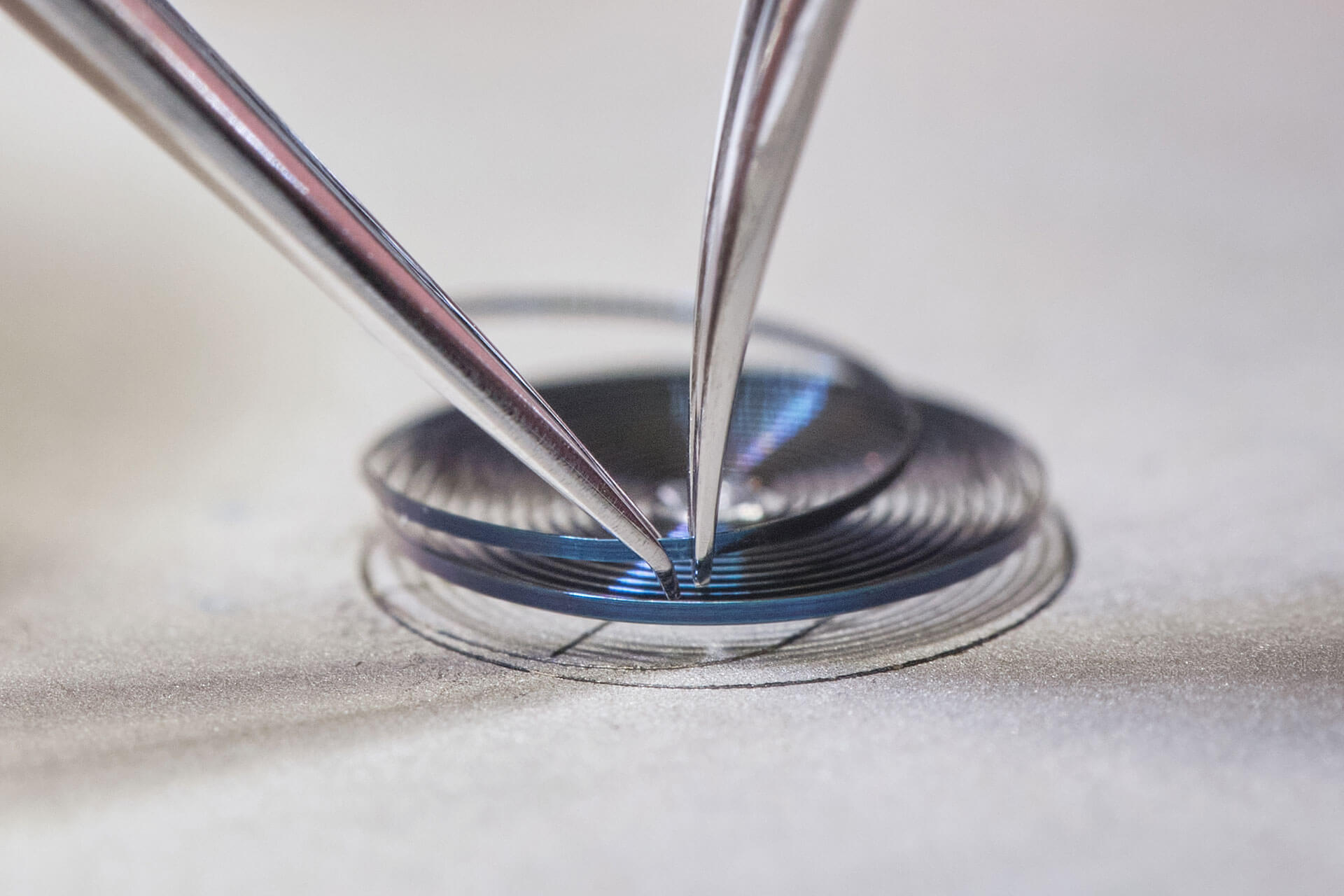
CNC milling machines
Raw parts like base plates, bridges, cocks, balances, levers, and springs are made by in-house CNC machines, ensuring independence from external suppliers and maintaining their quality standards. The challenge for a micro-manufacture like Lang & Heyne, producing about 150 watches a year, is constantly reprogramming the machines, since only 200-300 components (including rejects) are needed. The CNC machines were initially acquired because ever since 2013, they have also been producing high-quality movements for external brands with UWD-Werke (Uhren-Werke Dresden). For Lang & Heyne’s small series production, it would be impractical. Besides a classic 3-axis machine, Lang & Heyne has a state-of-the-art, 5-axis machine and a 7-axis turning/milling centre, which can also mill rotating parts like the balance. The 3-axis machine primarily mills flat parts like bridges, wheels, or cocks.
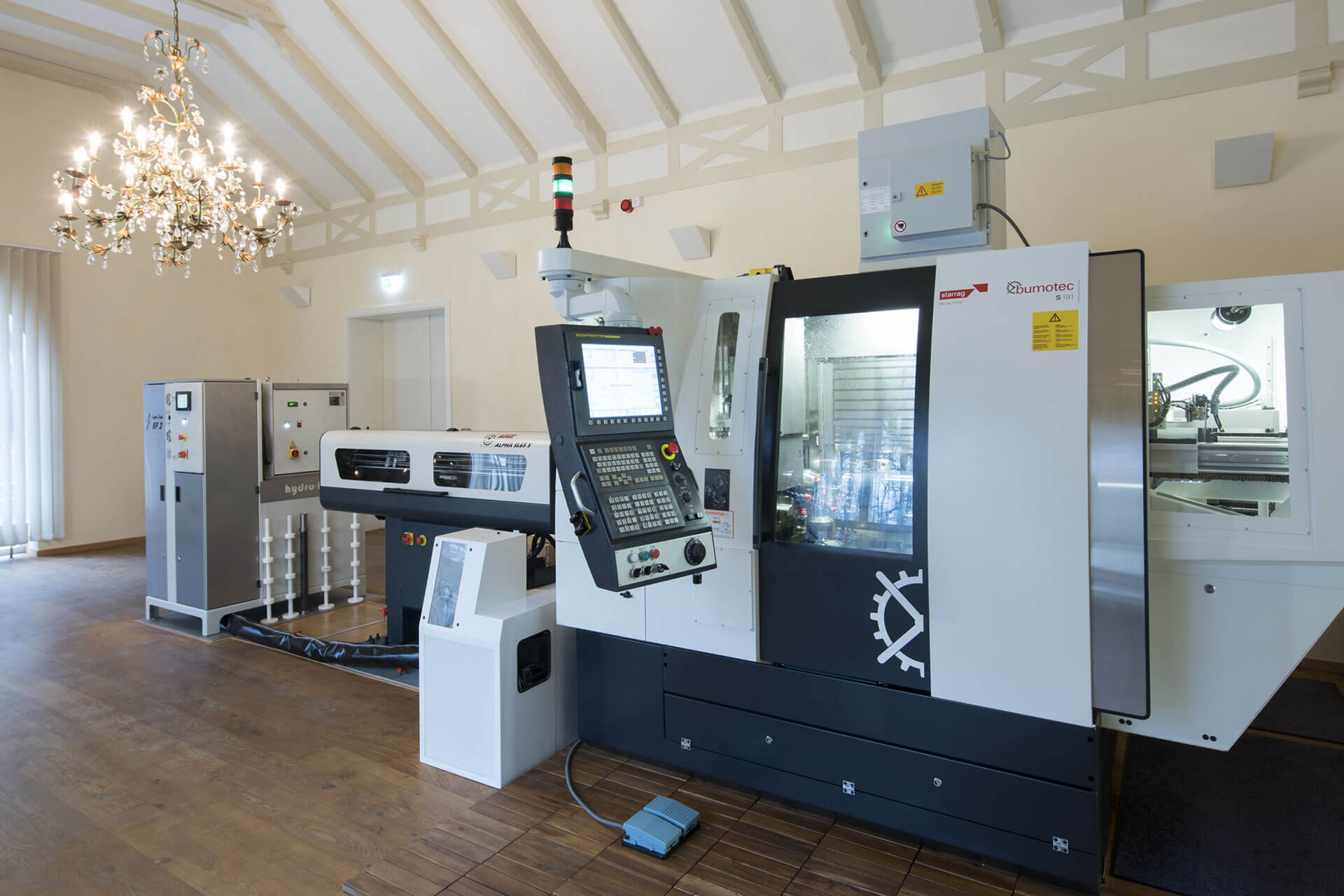
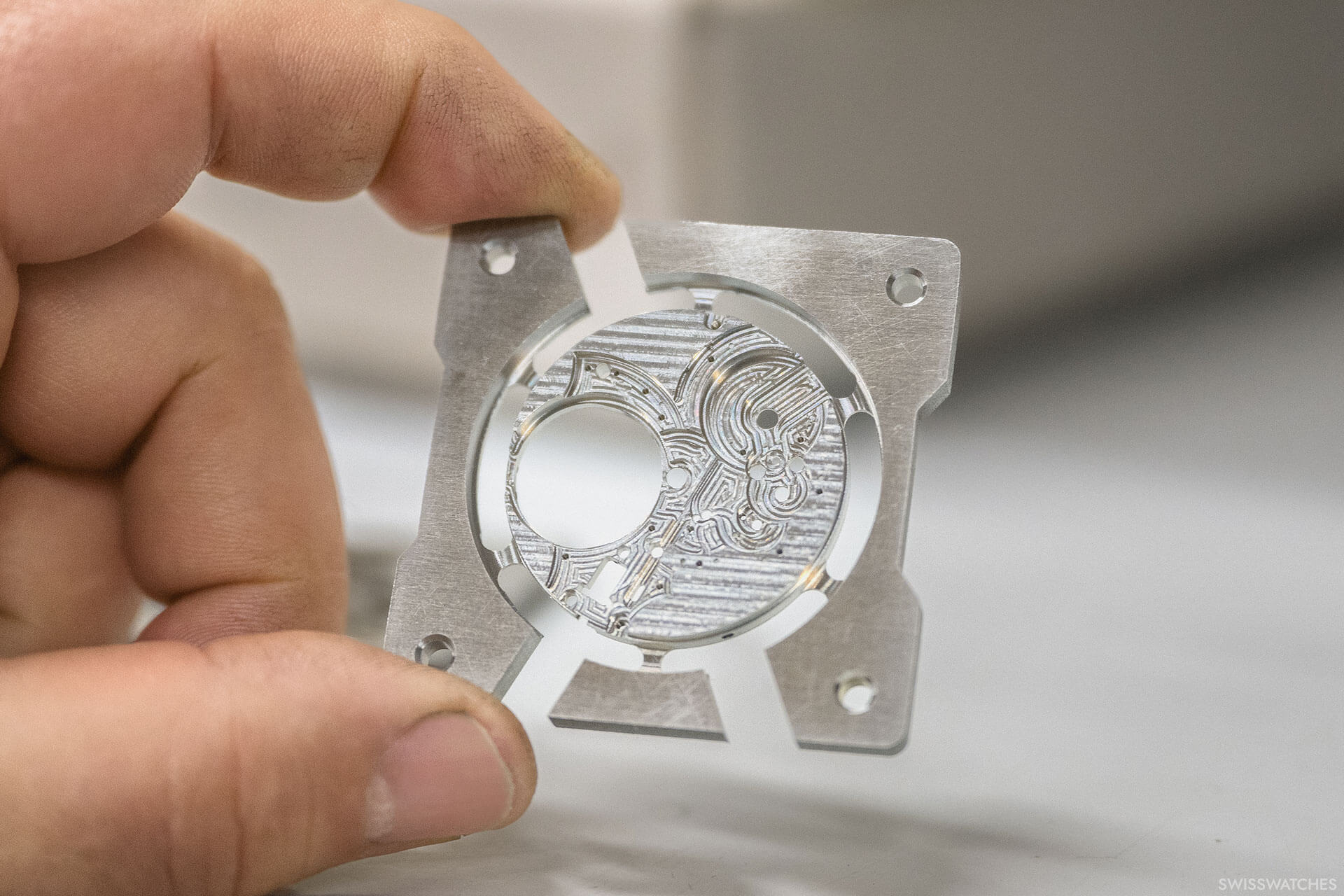
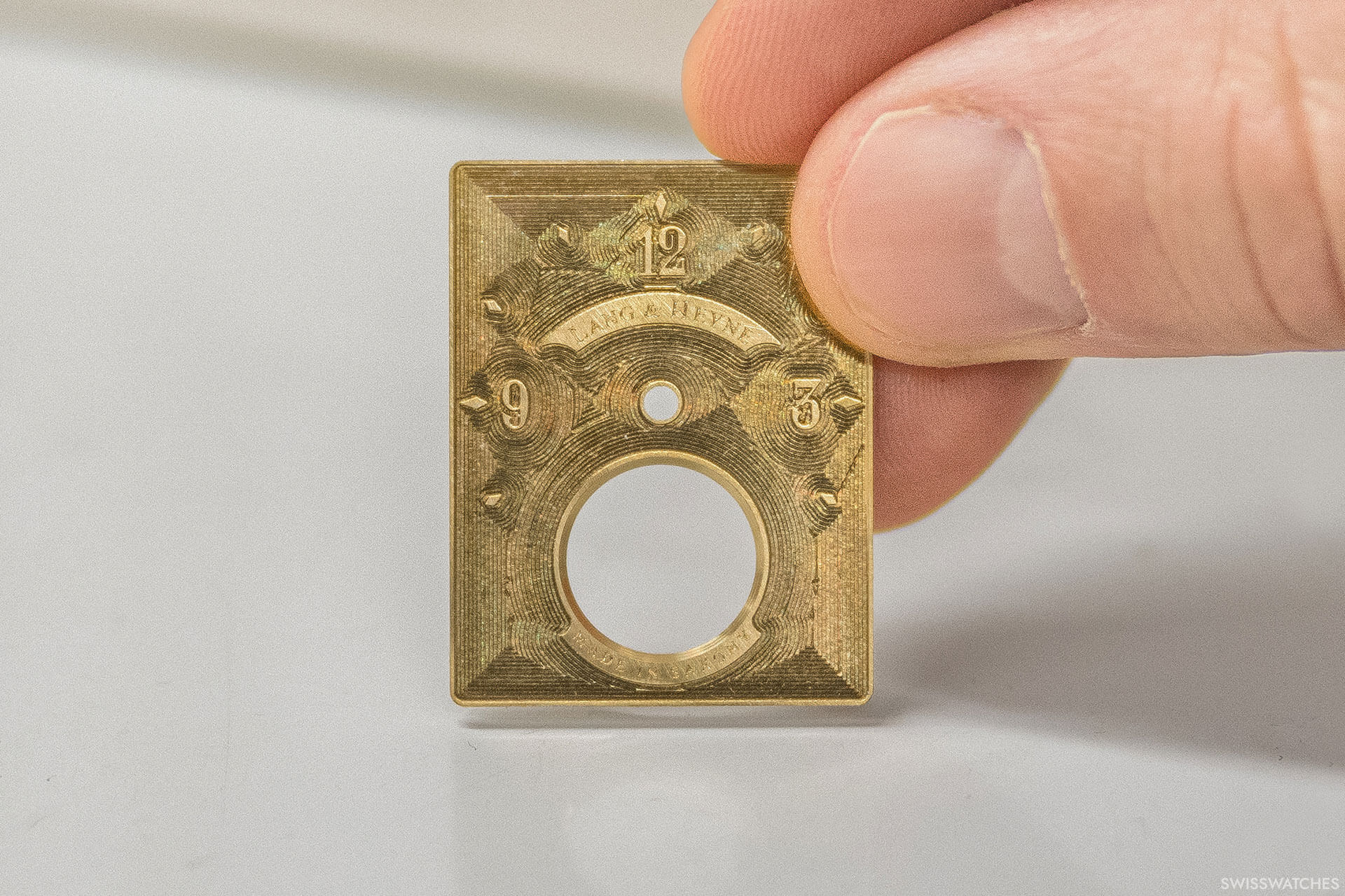
CNC lathes
In addition to CNC milling machines, Lang & Heyne has two lathes, allowing them to make even pins and screws themselves. These aren’t ordinary screws but rather miniscule ones, smaller than the shavings produced during milling. The smallest screw (from the balance rim) has a thread-like diameter of just 0.3 mm. The raw material is fed into the machine as long rods, and tiny turning tools shape the even tinier screws or pins from the raw material. Screw heads, slots, and bevels are then hand-finished and polished.
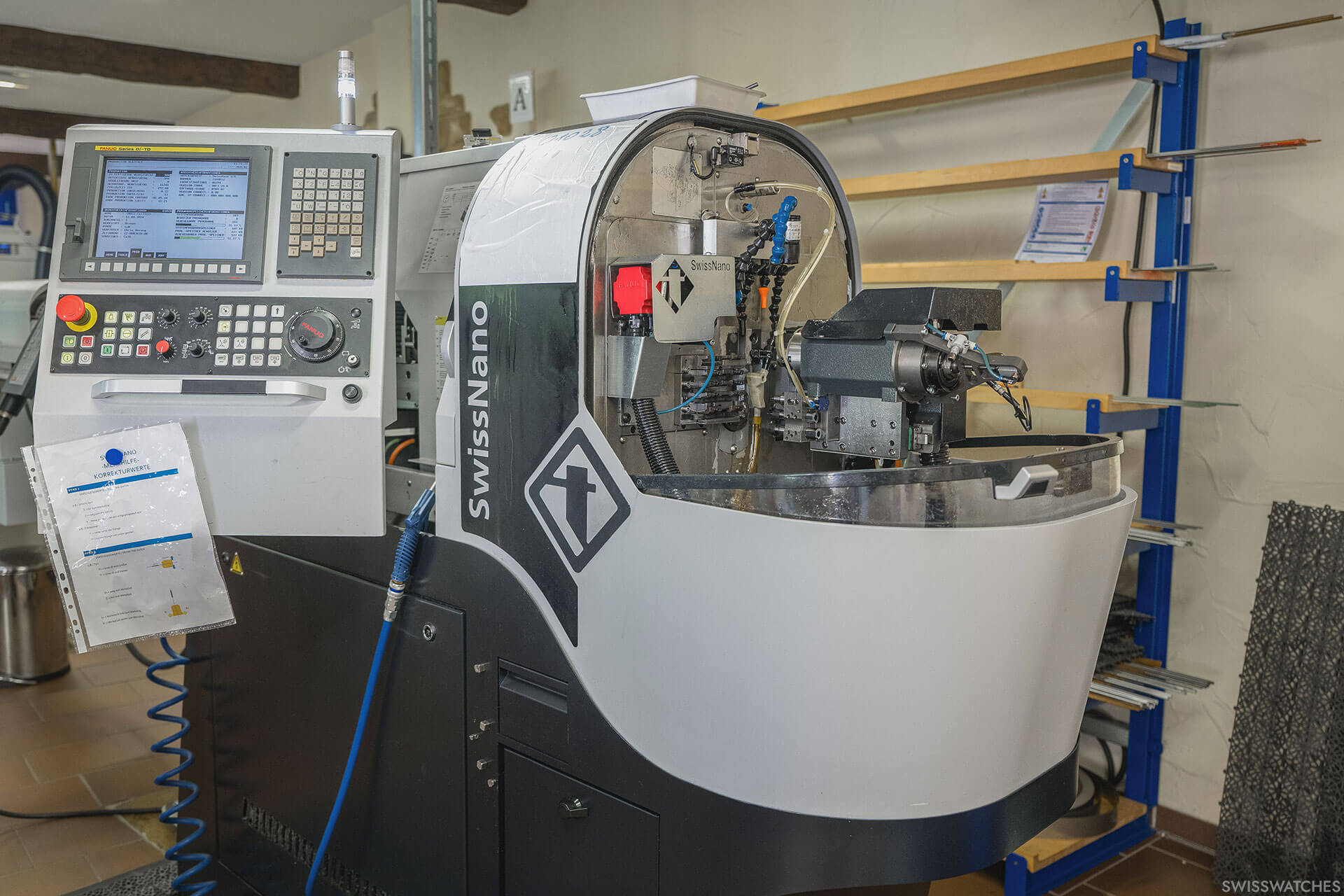
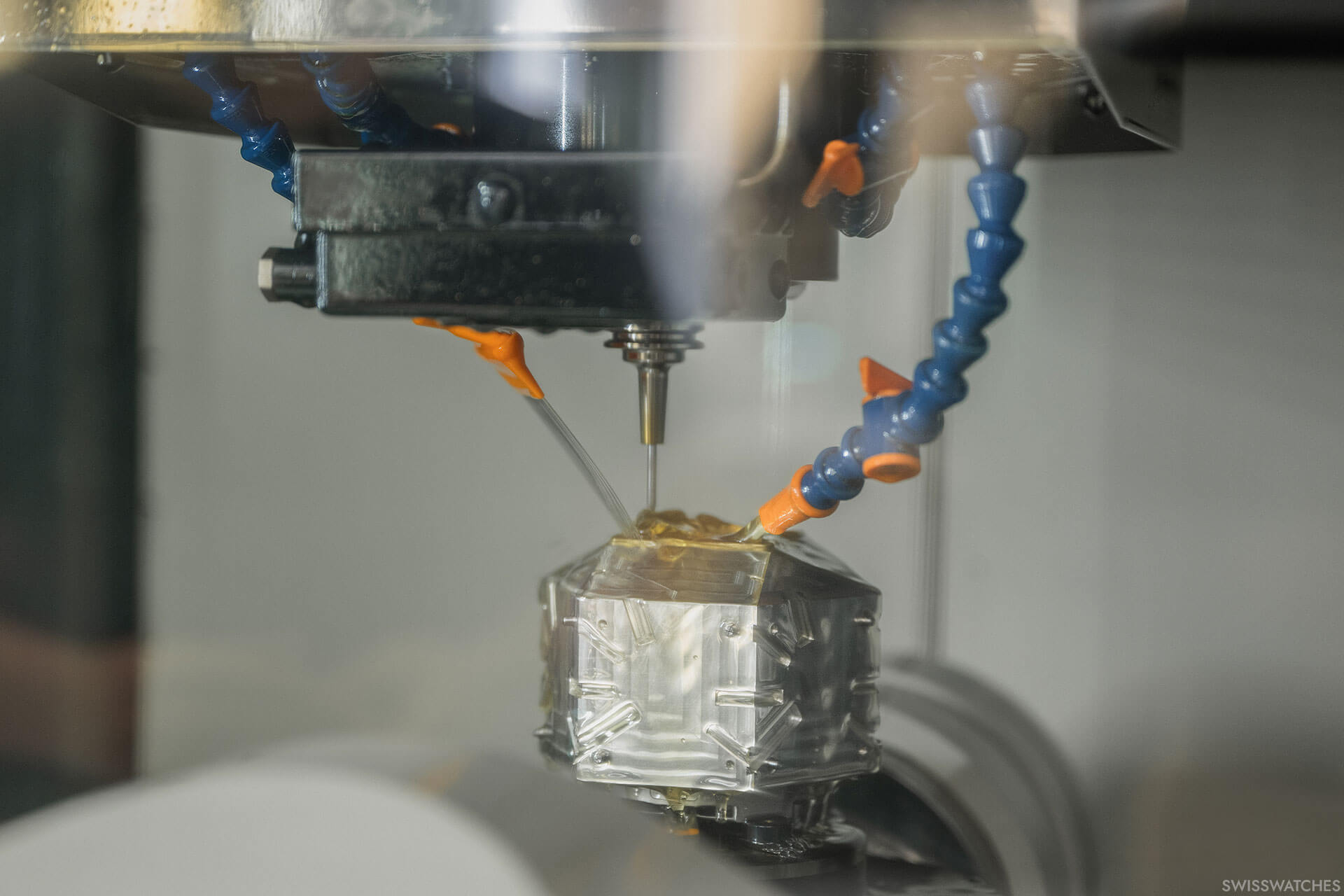
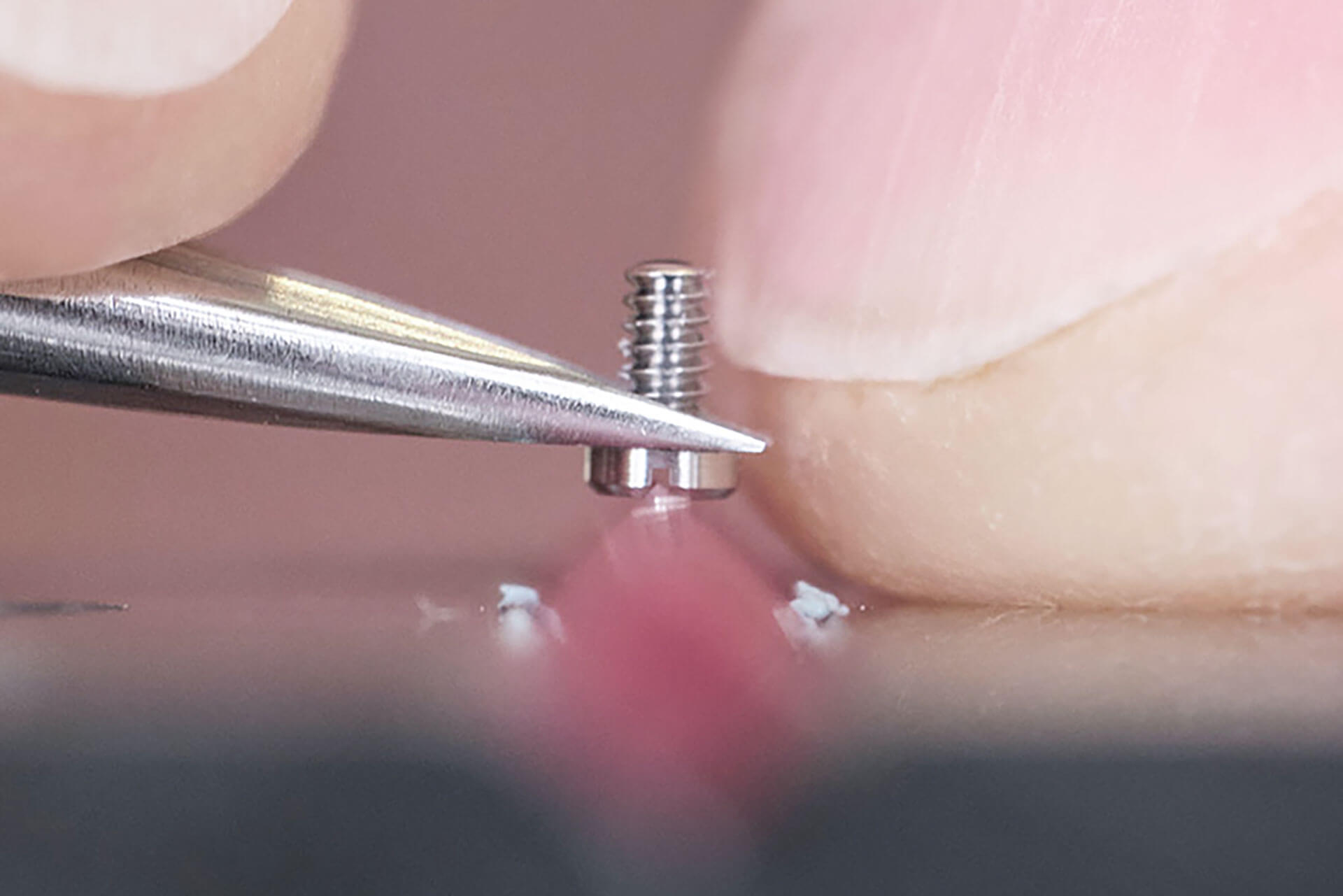
To install the massive machines in the old timber-framed house, windows had to be removed from the former dance hall. Since the machines must be vibration-free, holes were cut into the foundation to erect concrete pillars and iron supports from the cellar, allowing the machines to stand independently from the building. Just as a surgeon with shaky hands cannot successfully operate on an open heart, these massive machines delicately create the tiniest parts.
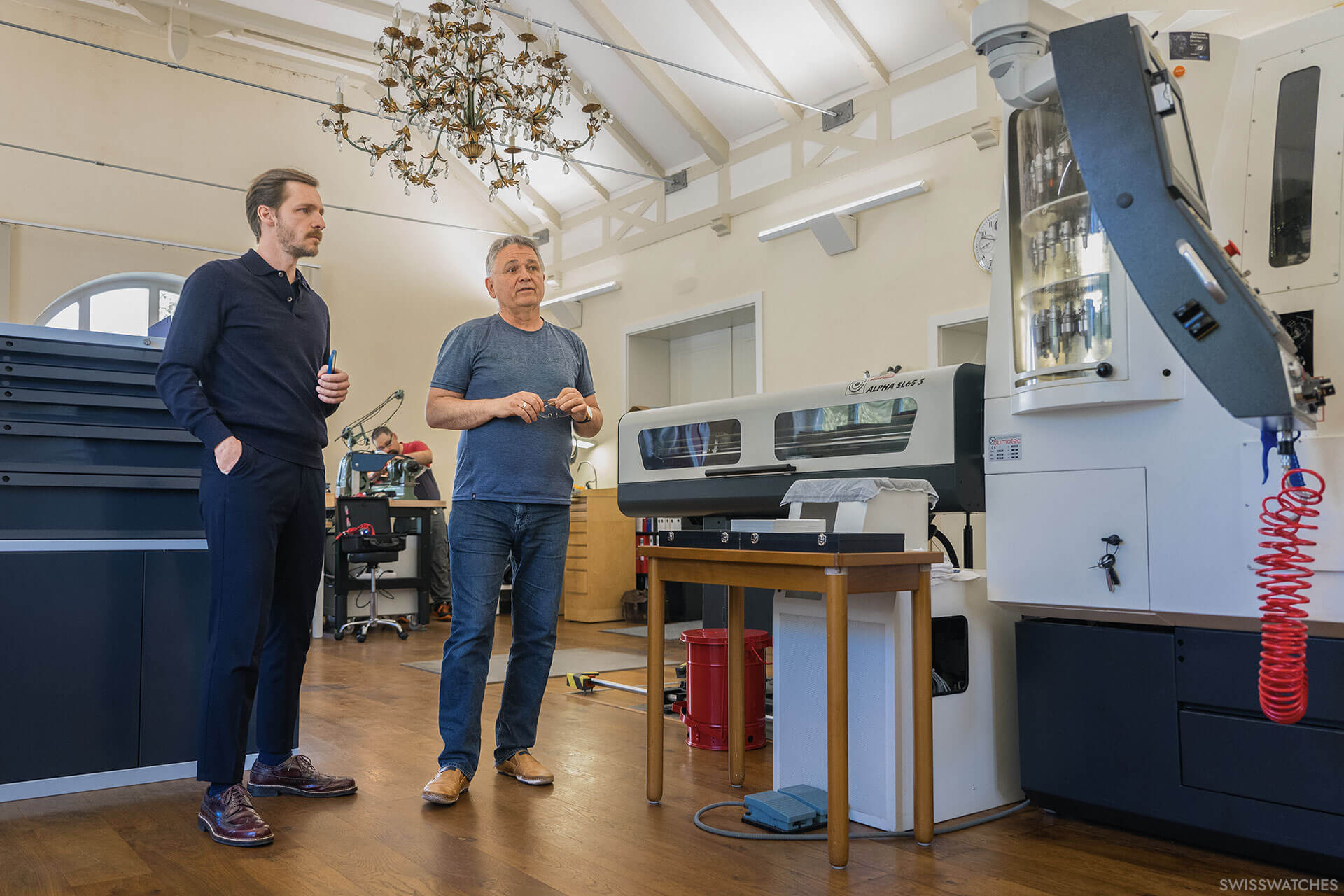
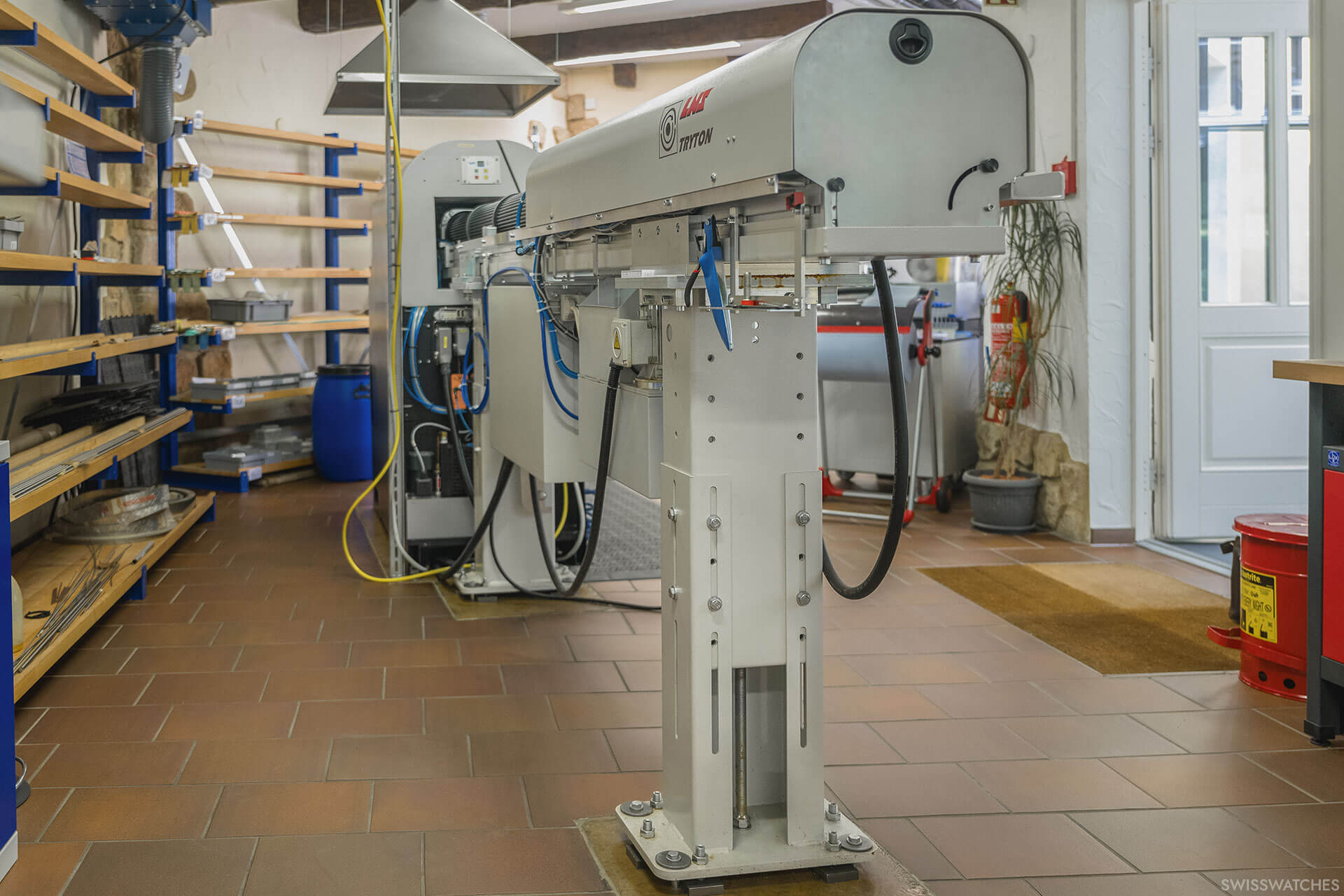
Mechanics and finishing come together
What happens in the artisans’ workshops is breath-taking. Here, even the tiniest parts of the watch are hand-finished. Miniscule screws are brushed, screw heads bevelled and tin-polished. In the tradition of Saxon watchmaking, some screws are thermally blued. The oxide layer, formed by surface treatment, changes colour with rising temperature from yellow to brown, violet, and finally the desired cornflower blue. This requires experience and perfect timing.
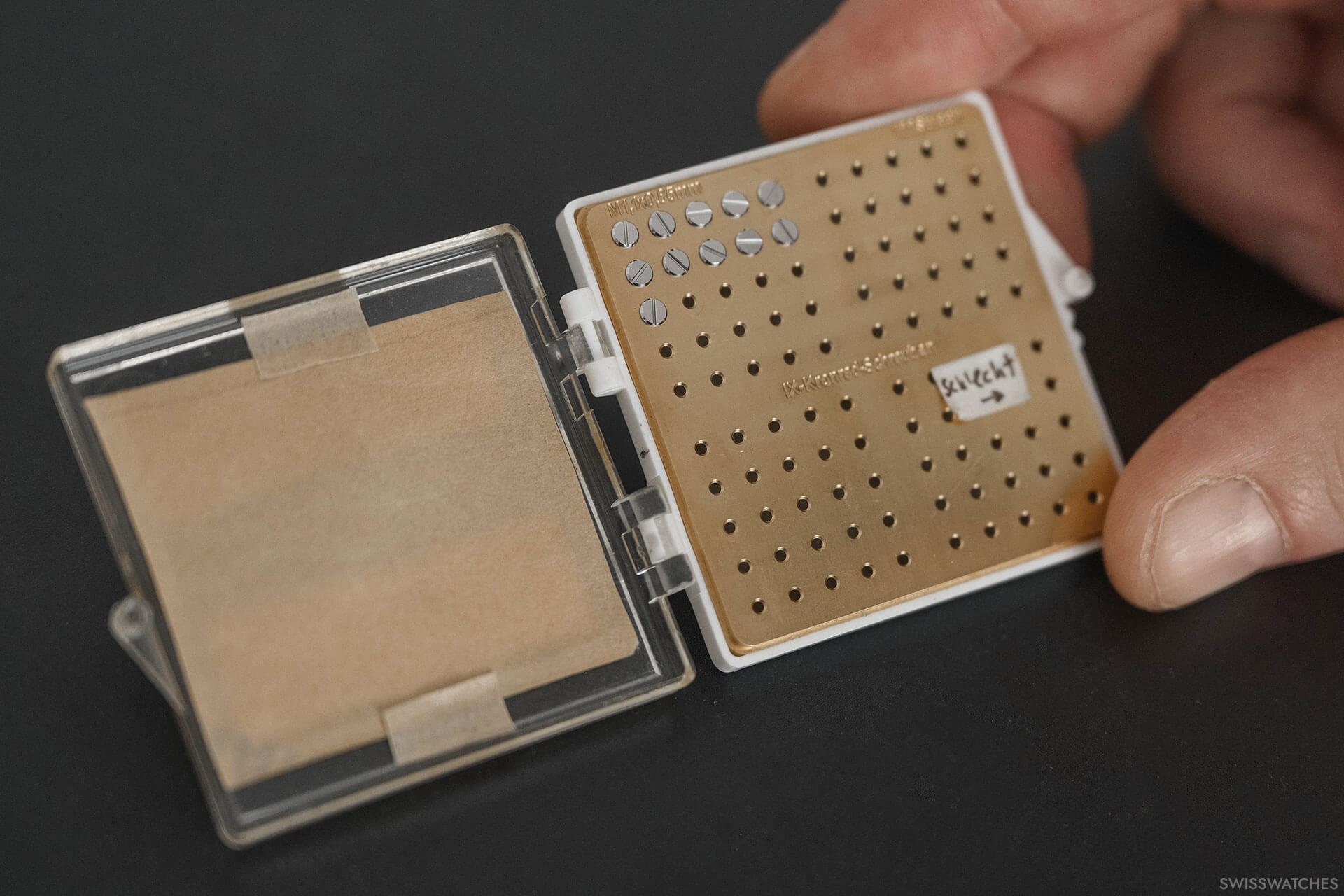
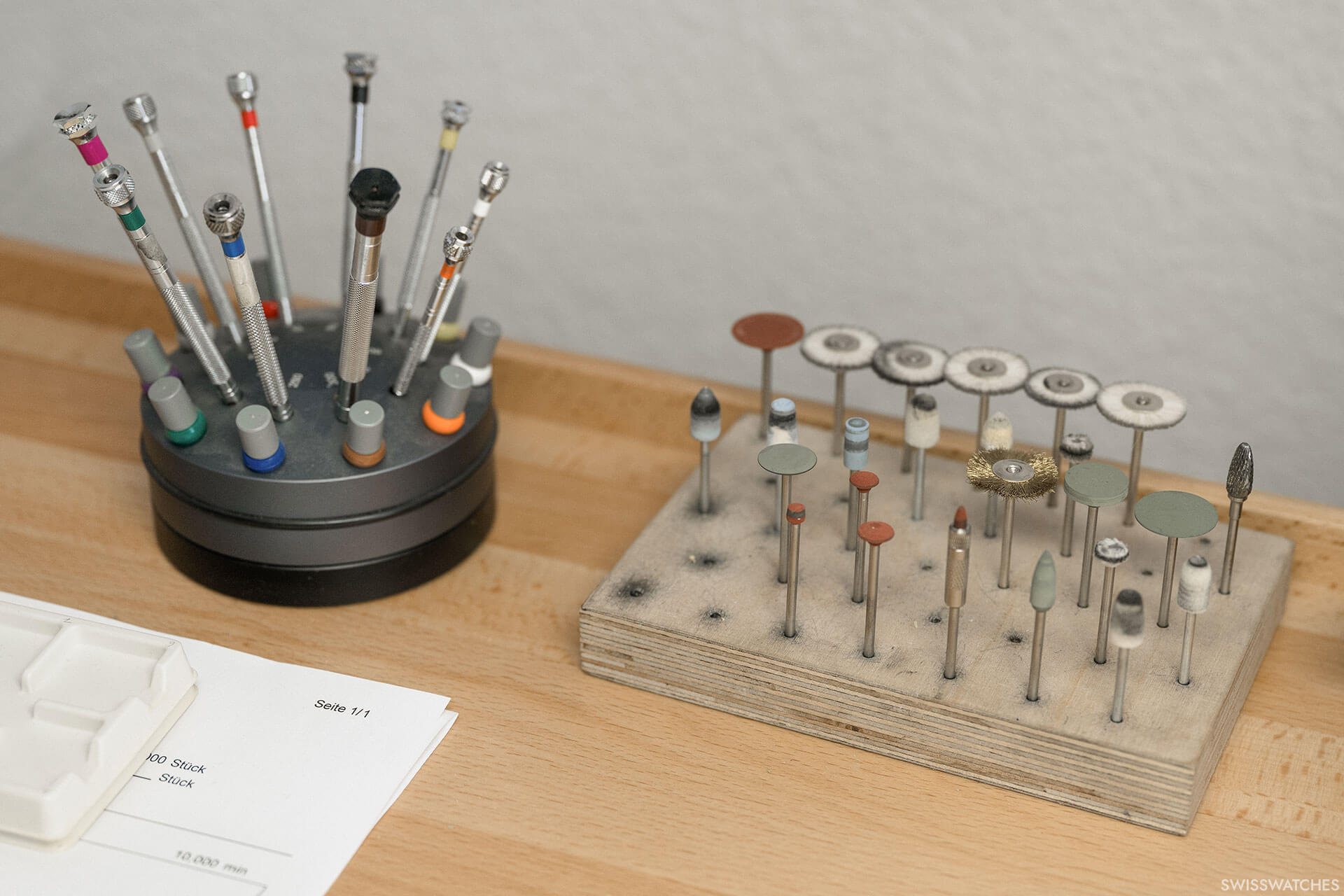
Not only screws but also hands are blued, creating a beautiful contrast to the white enamel dials. Not only are the surfaces of the gear wheels elaborately given a circular graining, but even the teeth and spaces between them are polished with a fine goat-hair brush. No surface escapes the careful hands of the finishers. One of them is currently finishing the barrel, but from the underside, which won’t be visible. “If a watchmaker ever opens this, he’ll be pleased,” he says with a smile. All parts are hand-finished, making the components not only aesthetically pleasing but also functionally advantageous by reducing friction between moving parts, thus increasing efficiency and durability of the movement.
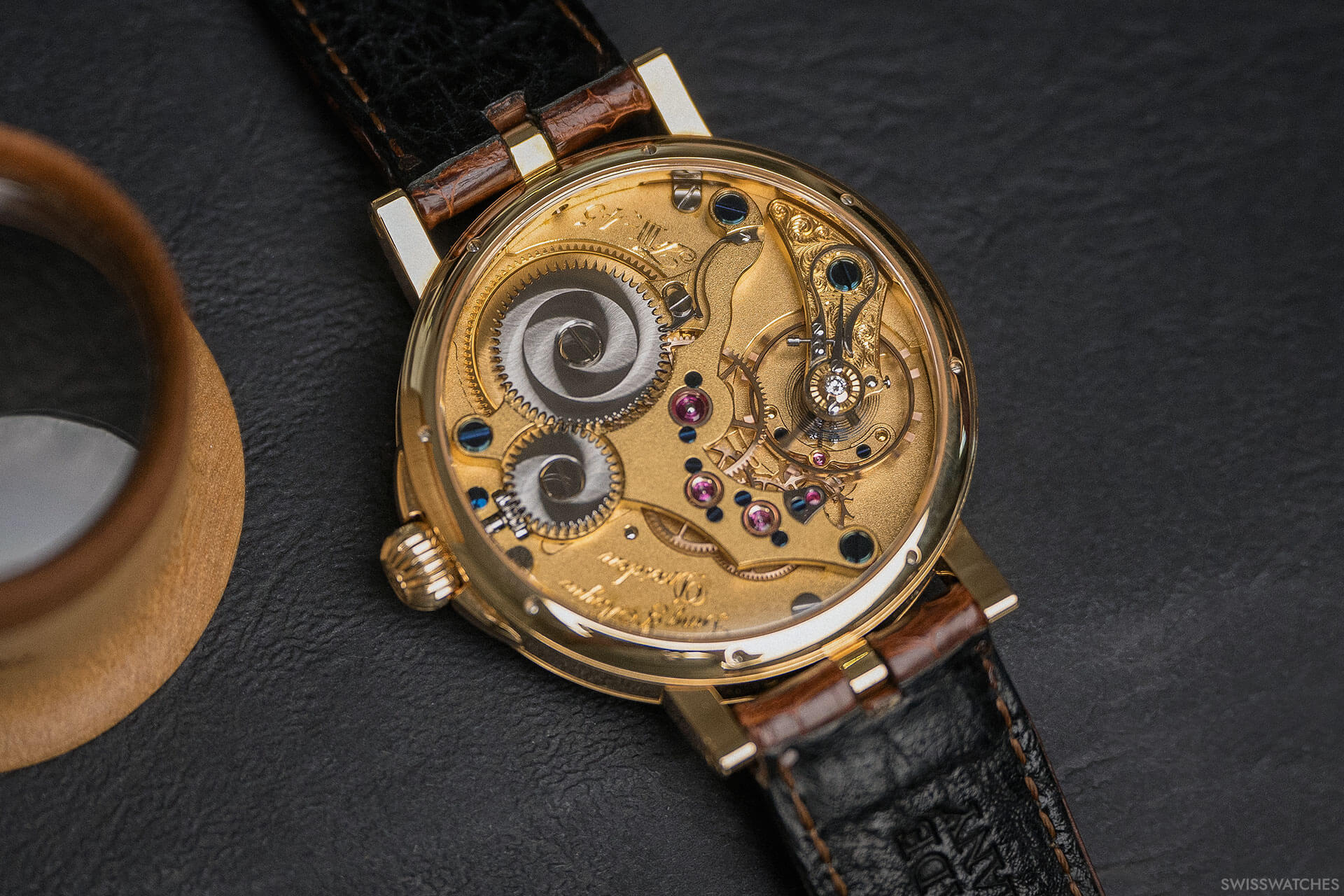
To create a nice contrast to the often-grained framework parts, flat components are sanded and polished. Various finishing techniques such as circular graining, sunray finish, straight graining, or tin polishing are used. A single cock may take the finisher four hours. The result can be admired in the unique design of the movement cocks, characteristic of Lang & Heyne.
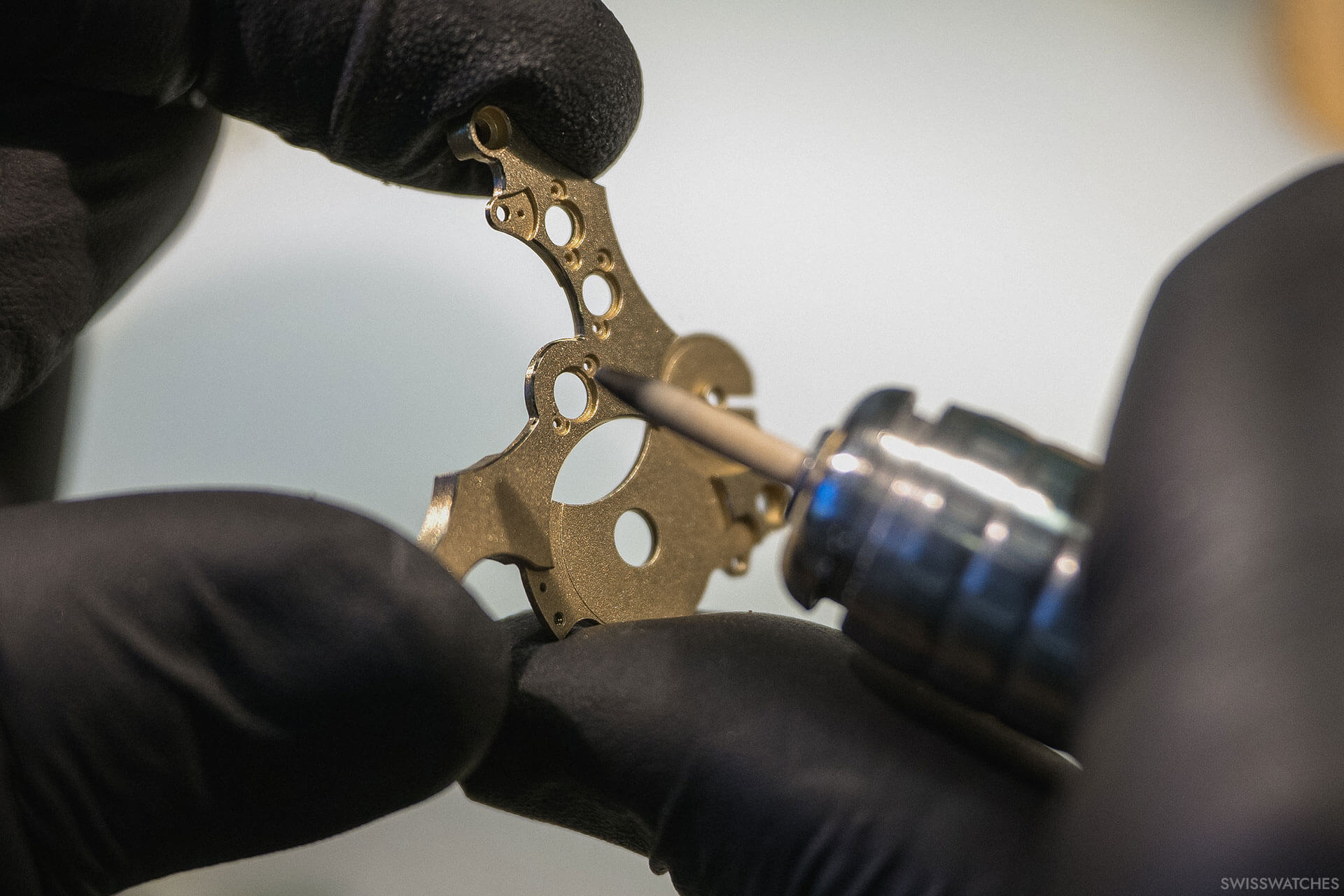
Despite the attention to detail, watchmakers must always keep the mechanical side in mind. Over-polishing can negatively affect the component’s geometry. Mechanics and finishing must always be in harmony.

Hands and dials
Another hallmark of Lang & Heyne watches is the in-house production of hands and dials. Various styles of hands, such as lancet, cathedral, pear, pike, and even intricately hand-engraved Louis XV hands, are made for different collections. To handle the hands without breaking them, they are first lacquered onto a carrier and then ground until they are three-dimensional. The hands achieve their shine through polishing with a ‘swab’ and polishing paste.
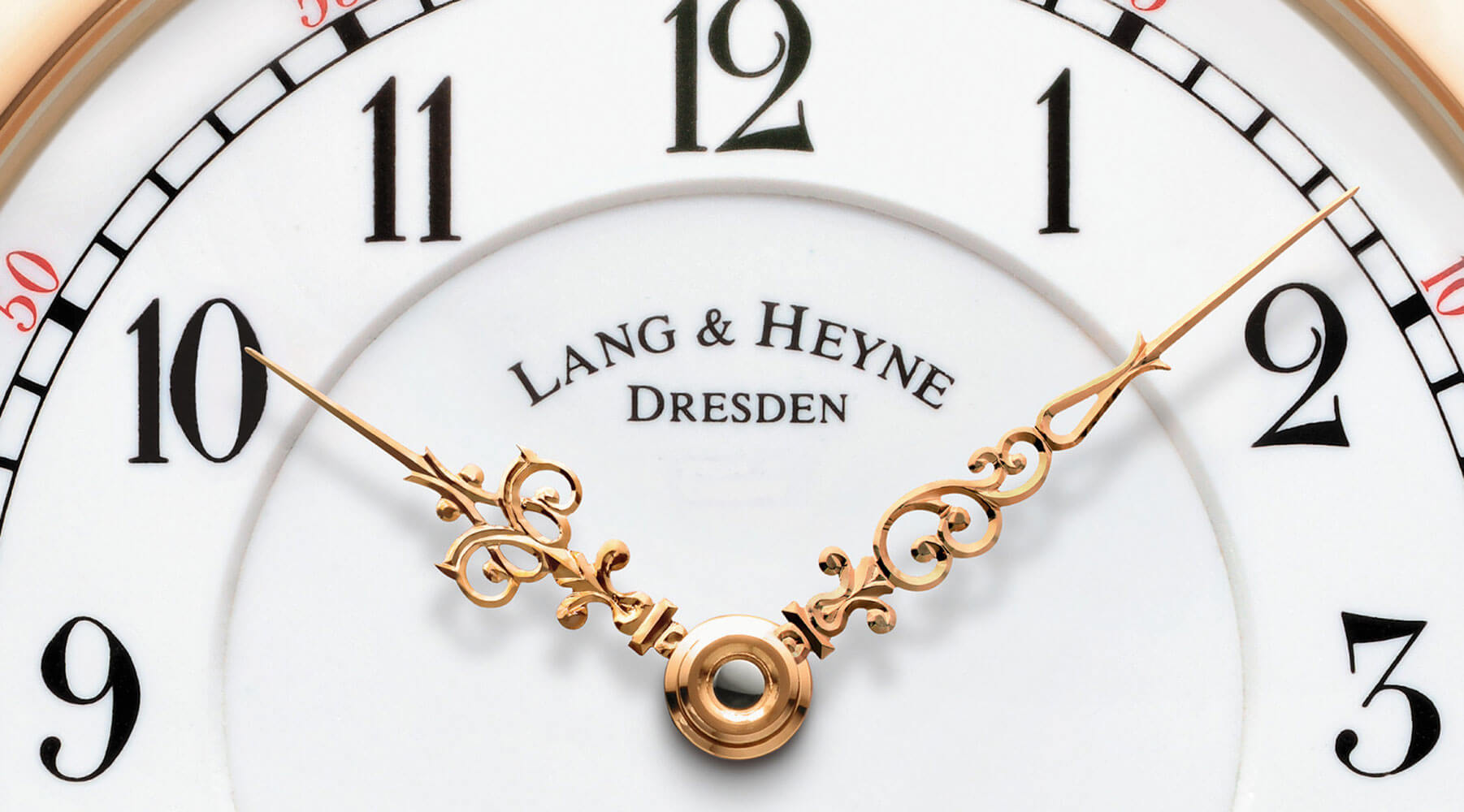
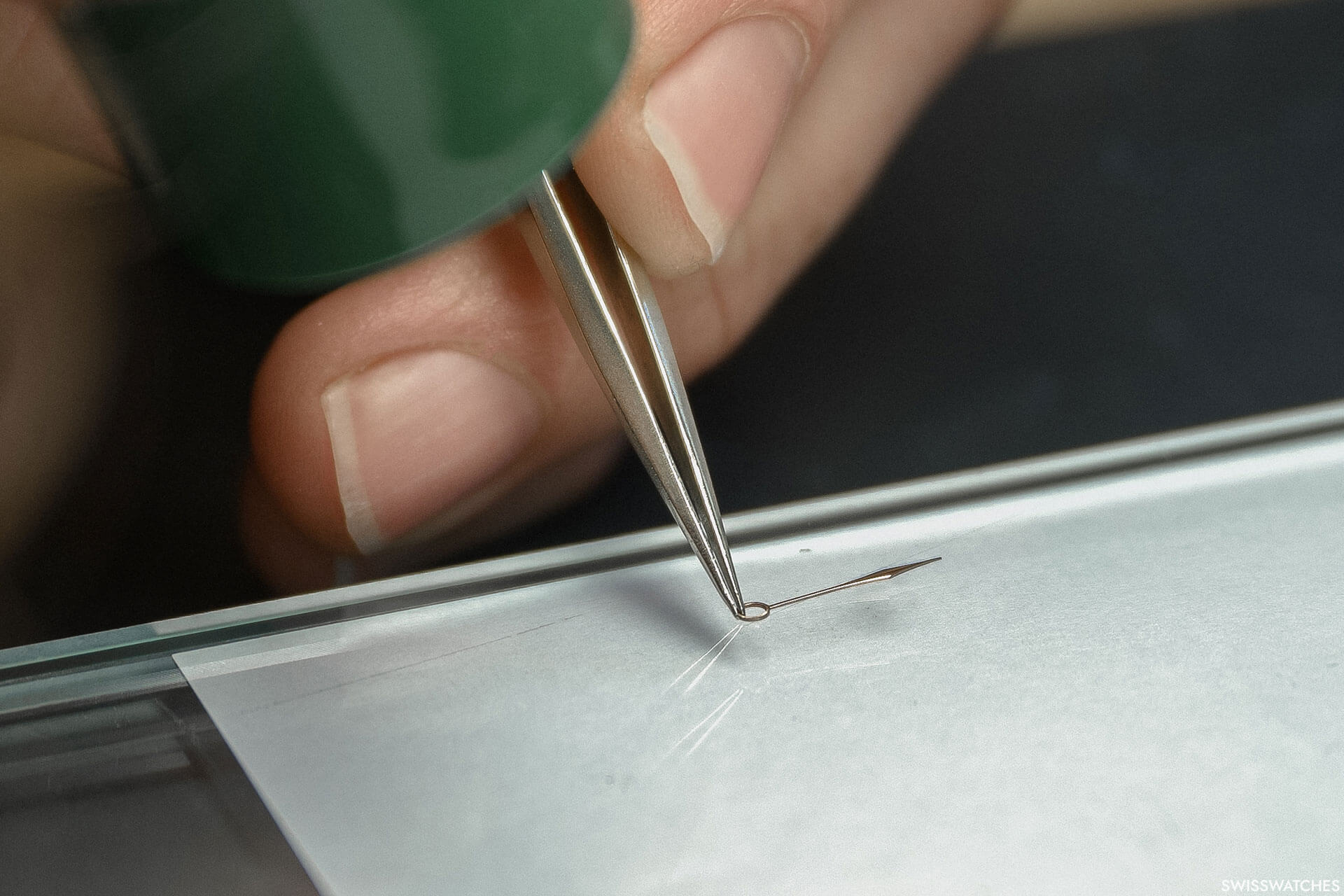
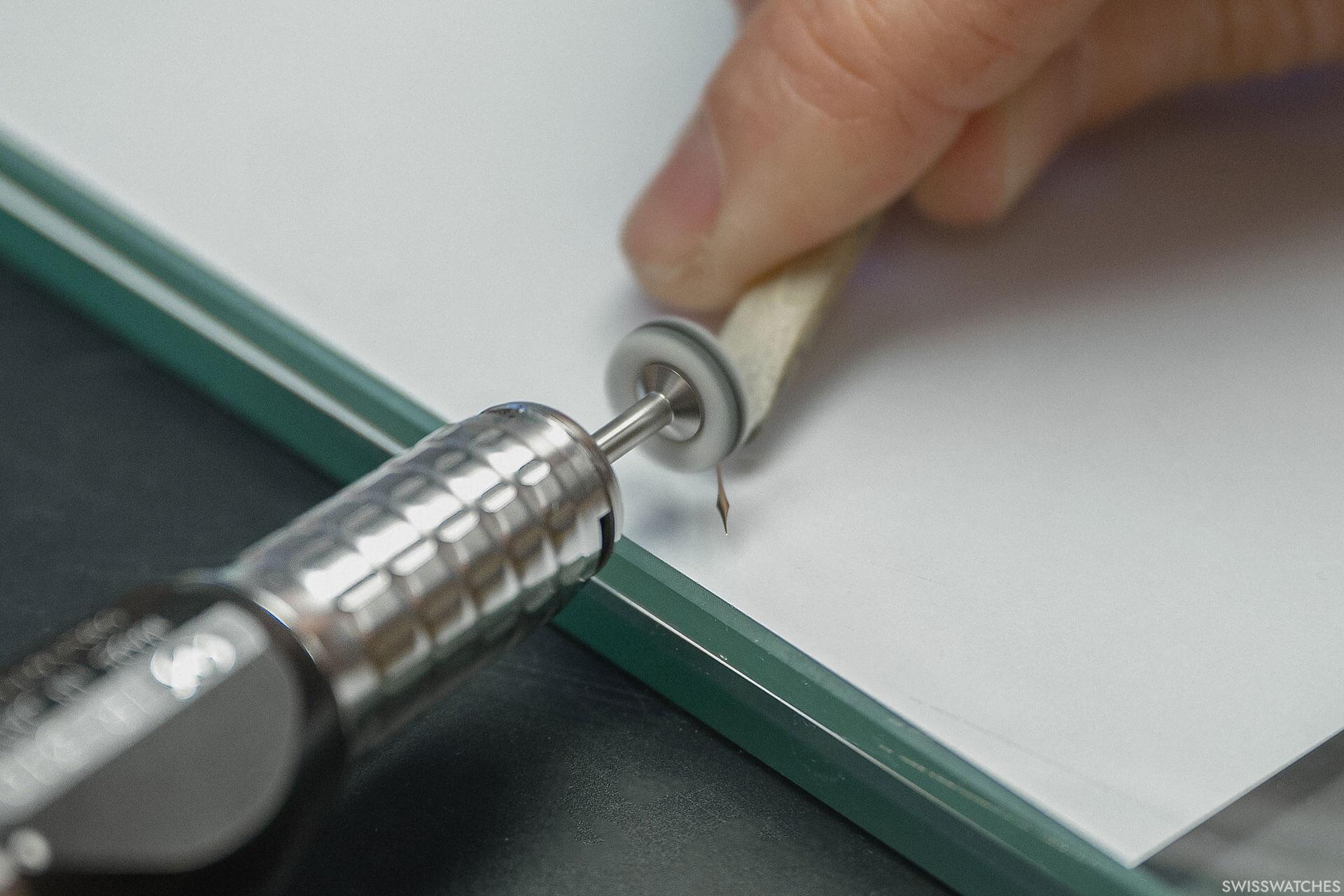
One finisher is currently working on a lancet hand for a custom order. To ensure the hand fits the overall look of the watch, it must be shortened, meaning the finisher must grind and polish the hand’s rounded back, maintaining the proportions. There’s no handbook for this; improvisation and years of experience are required. It takes up to a year for a trained watchmaker to attempt hands on their own. This challenge attracts Lang & Heyne’s creative and skilled finishers, who perfect their craft every day. To me, Lang & Heyne is one of the few watchmaking companies that showcase how creative and fulfilling a finisher’s job can be. It reminds me of Moritz Grossmann, another Saxon manufacture renowned for its elaborate handcrafting.
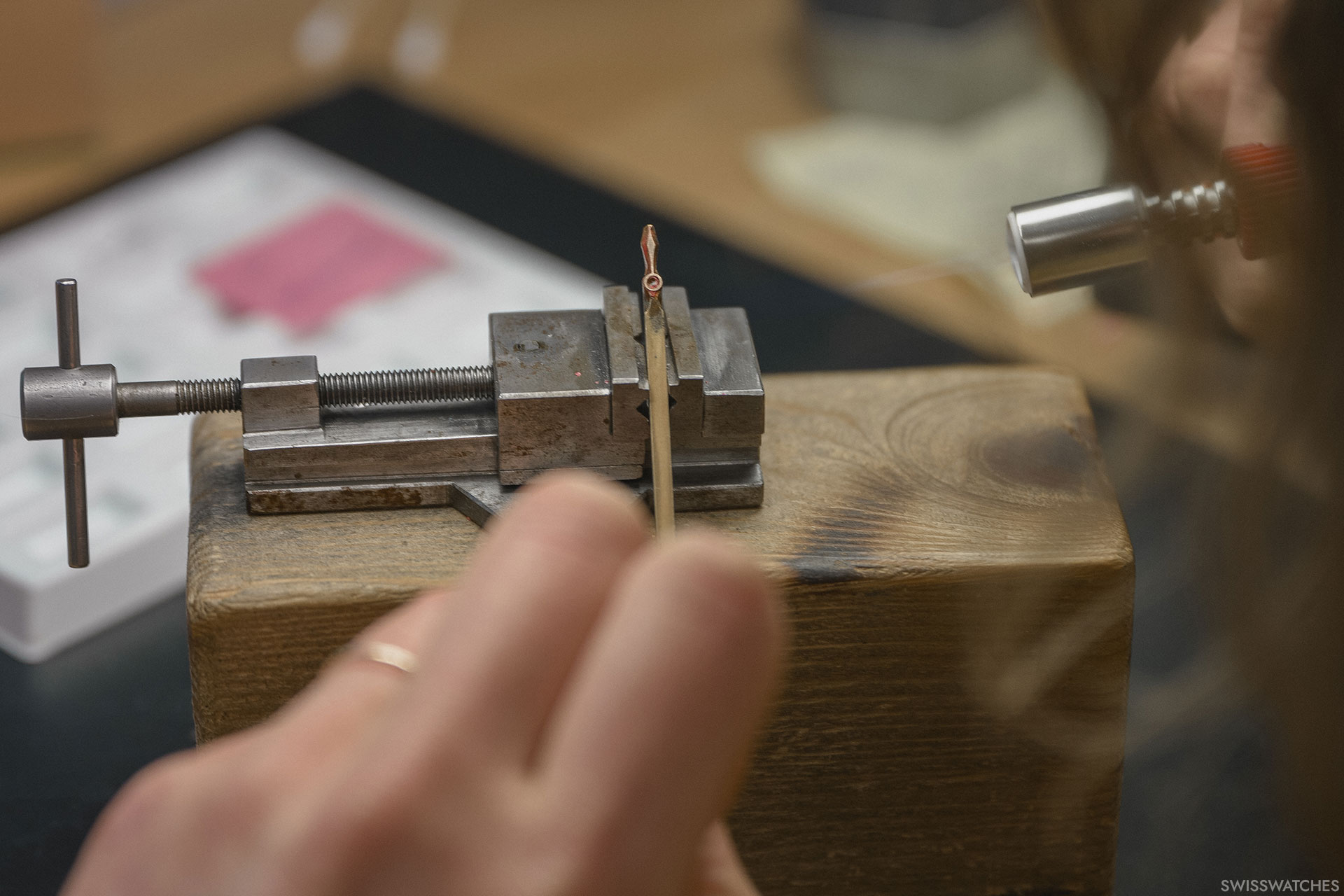
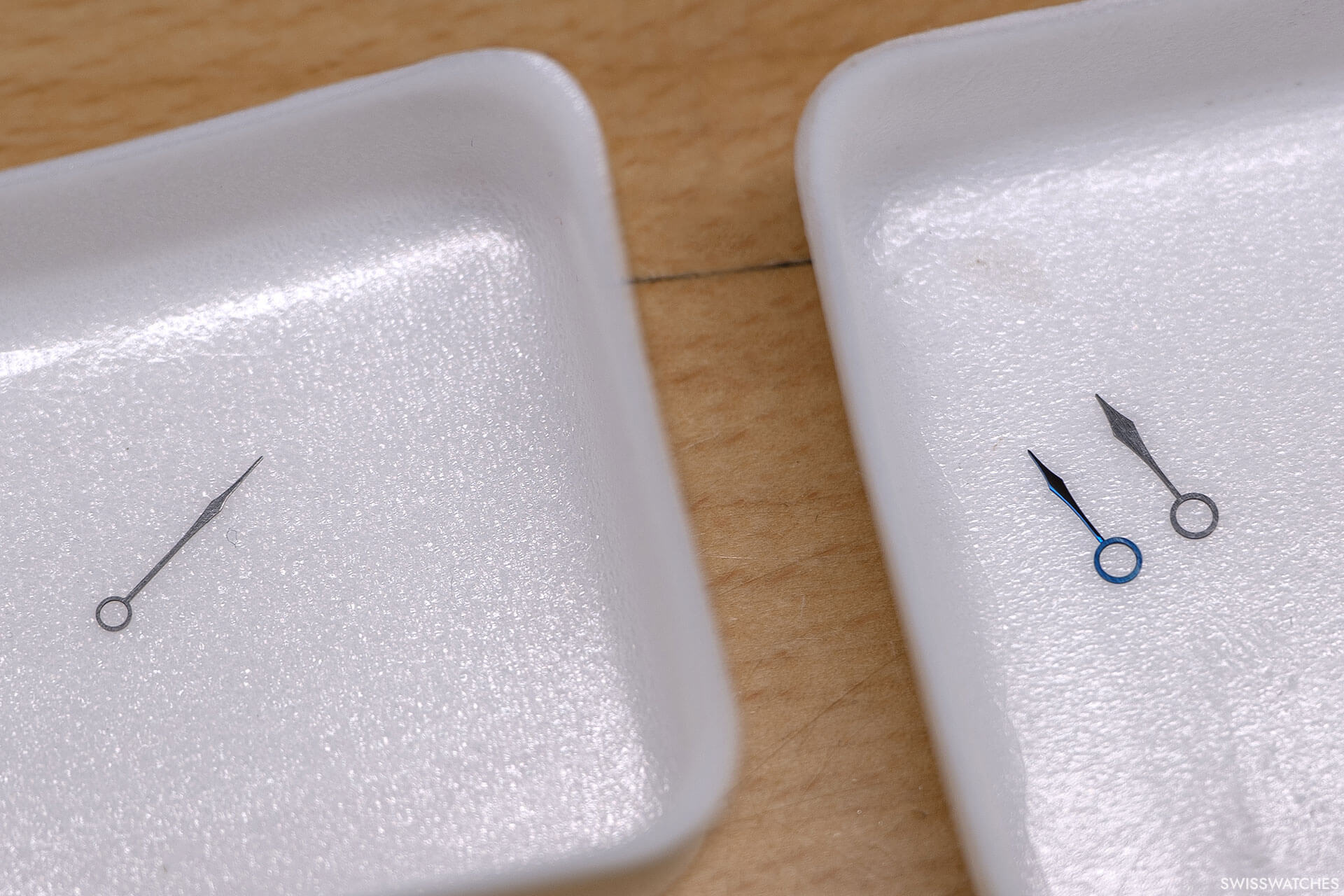
An in-house enamel workshop at Lang & Heyne gives the watches an unmistakable aesthetic. The dials are inspired by the Saxon court watchmakers of the 18th century and are ‘double-baked’. The first layer is melted onto a pure silver plate at about 800 degrees Celsius. When it cools, the plate is checked for inclusions or bubbles and polished to a smooth finish. After printing and baking the indexes, Roman numerals, and minute track at about 700 degrees Celsius, the edges are cut out by hand with a compass and file, then polished. This gives the dials a characteristic, slightly domed shape, achieving a brilliant deep white that sets a beautiful contrast to the blued hands.
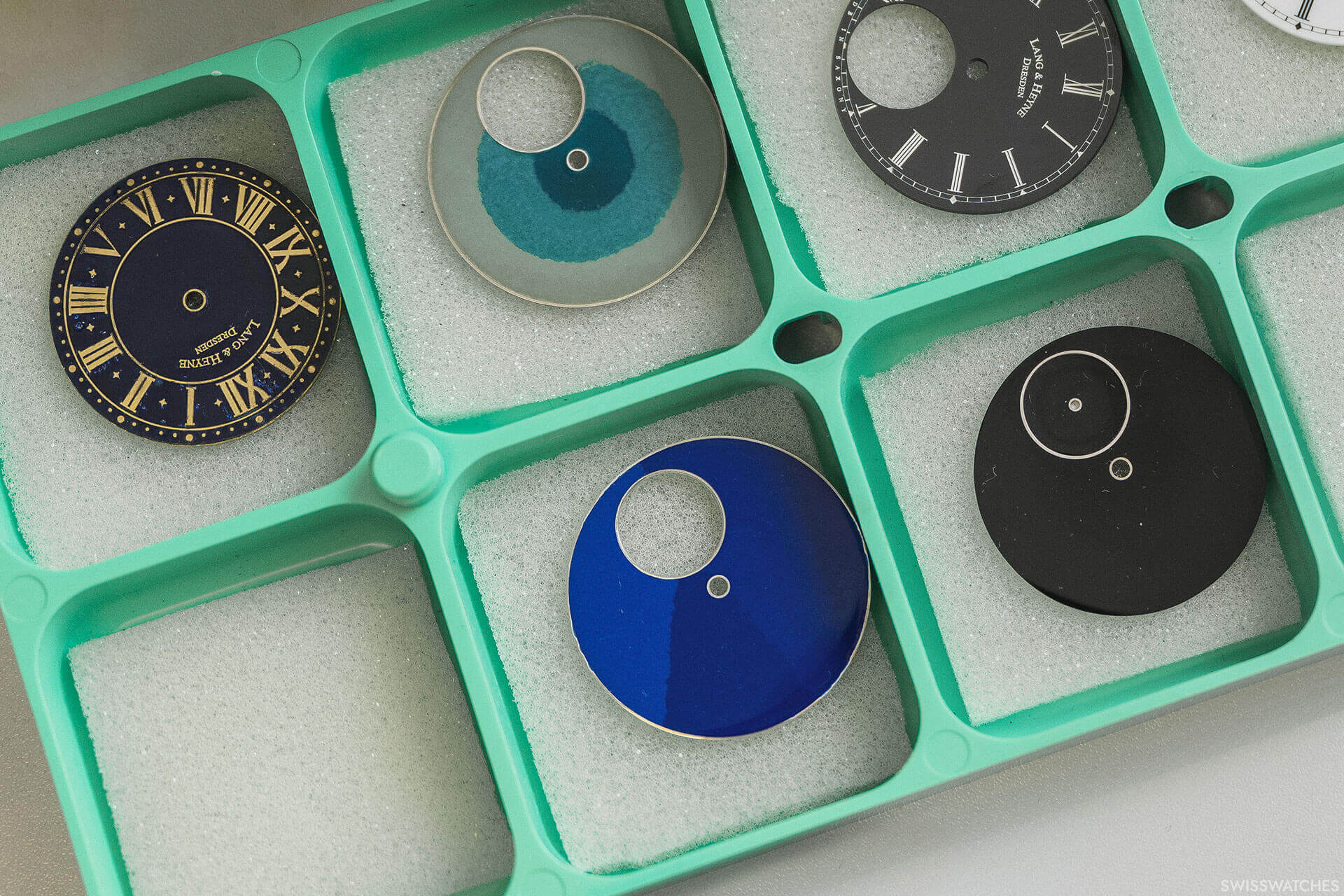
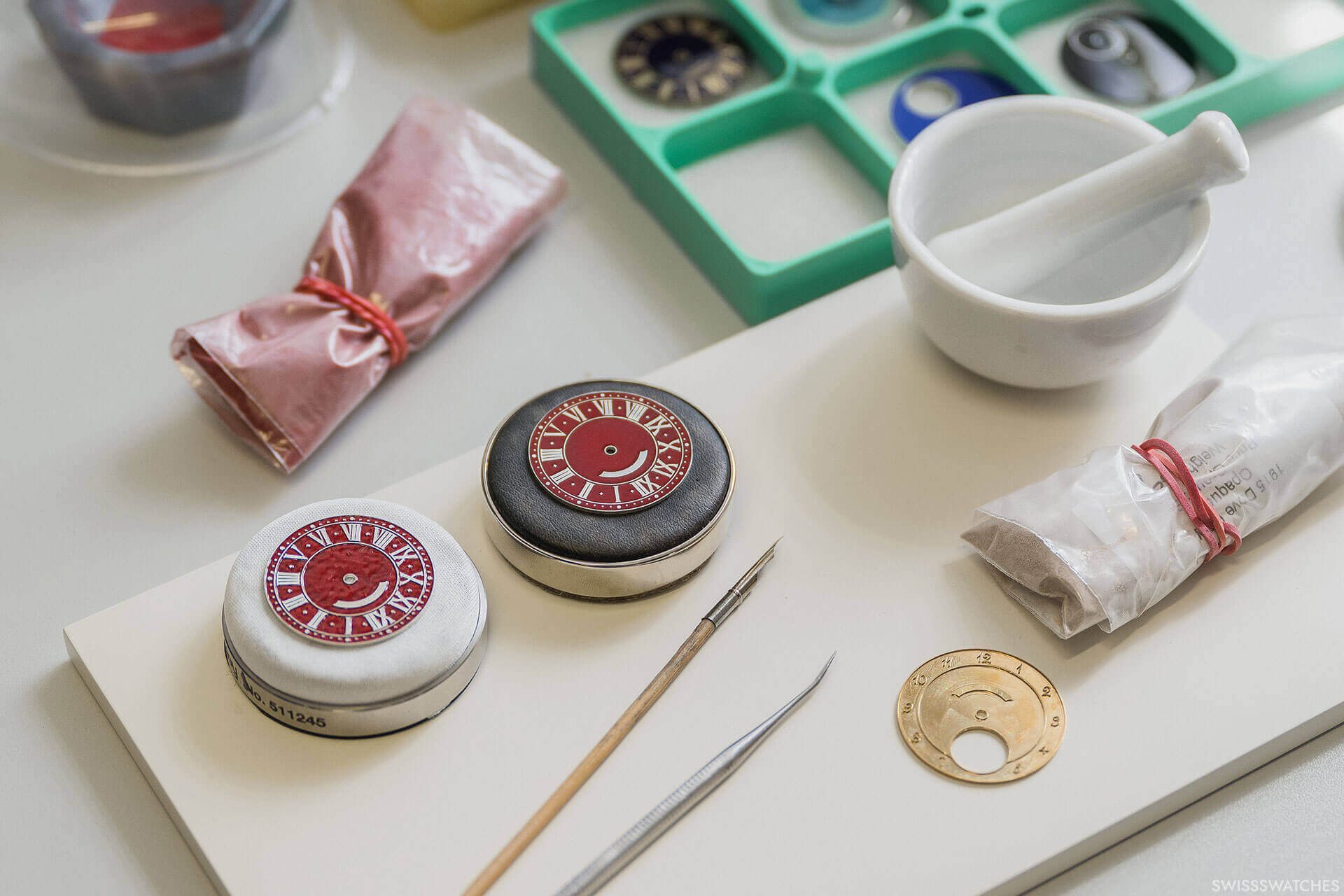
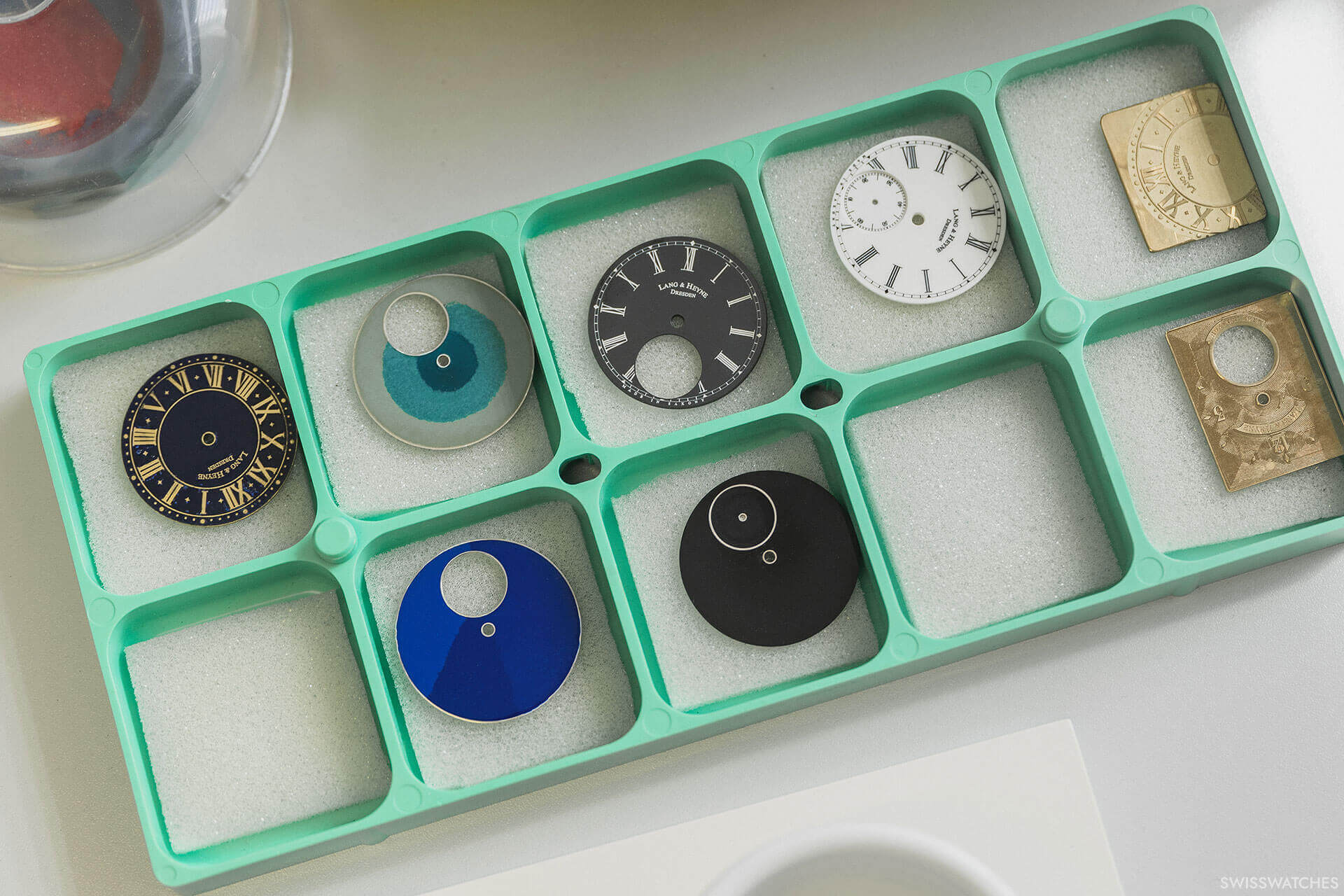
Assembly
The pre-assembly and final assembly of a Lang & Heyne watch is a time-consuming and complex process. The components cannot simply be connected and screwed together, because each component has a certain tolerance, and when they interact, they influence each other, which can trigger the so-called addition effect. This means that the tolerances add up and end up exceeding the permissible dimensions.
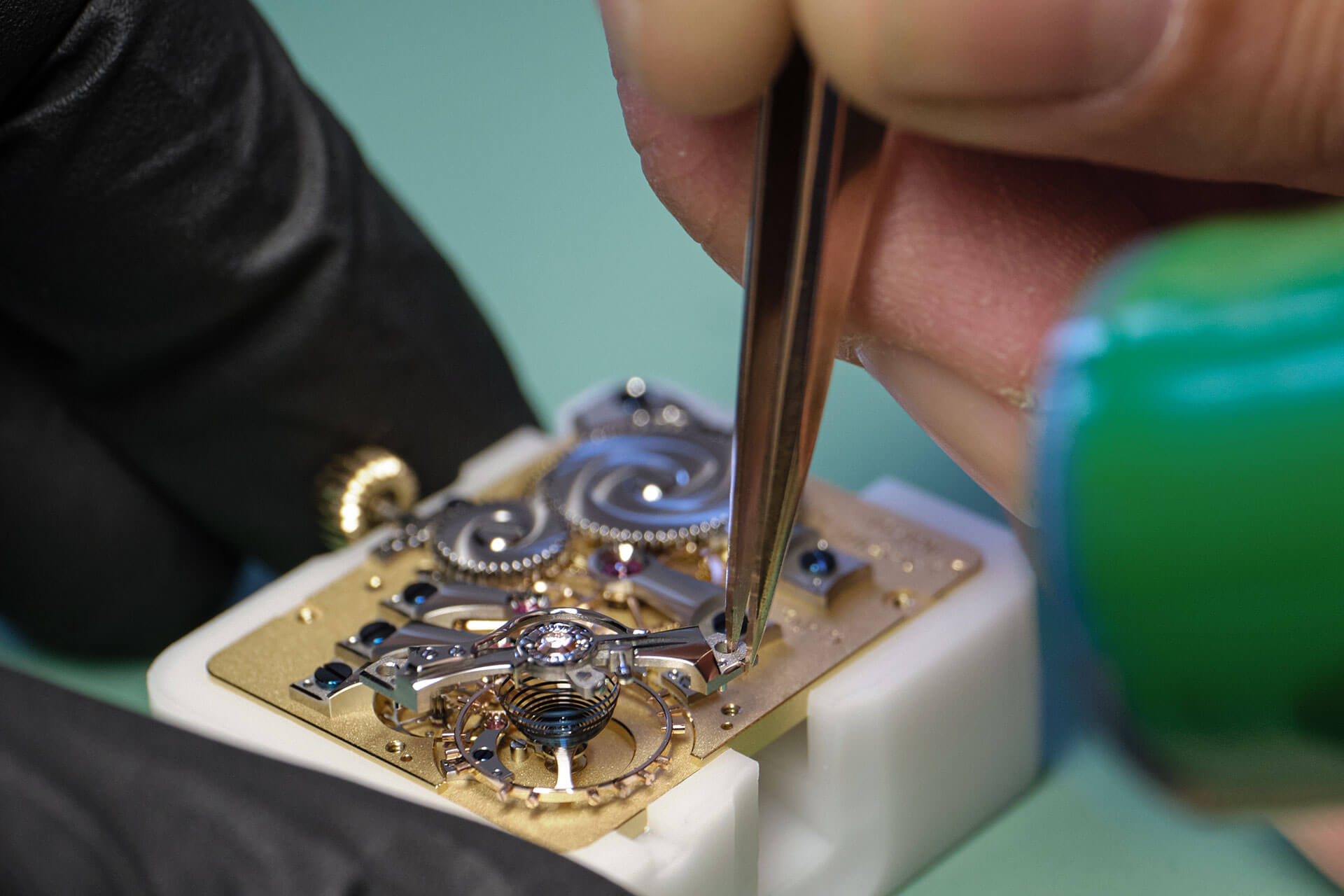
Firstly, the winding components and the movement wheels mounted in rubies are inserted. The watchmaker adjusts the gap dimensions with the utmost precision to ensure smooth running. In order to achieve an exact rate, the lever with its ruby pallets, which connects the balance wheel to the gear train, is adjusted so that it engages with the escape wheel securely and with little friction. The balance and hairspring are adjusted so that the watch runs precisely in every position.

Just to comprehend the dimensions involved in assembling the watch: the pre-assembly of the Anton calibre 9 takes around a week, and the final assembly another day. The balance is fitted and pre-adjusted beforehand, and takes another four hours.
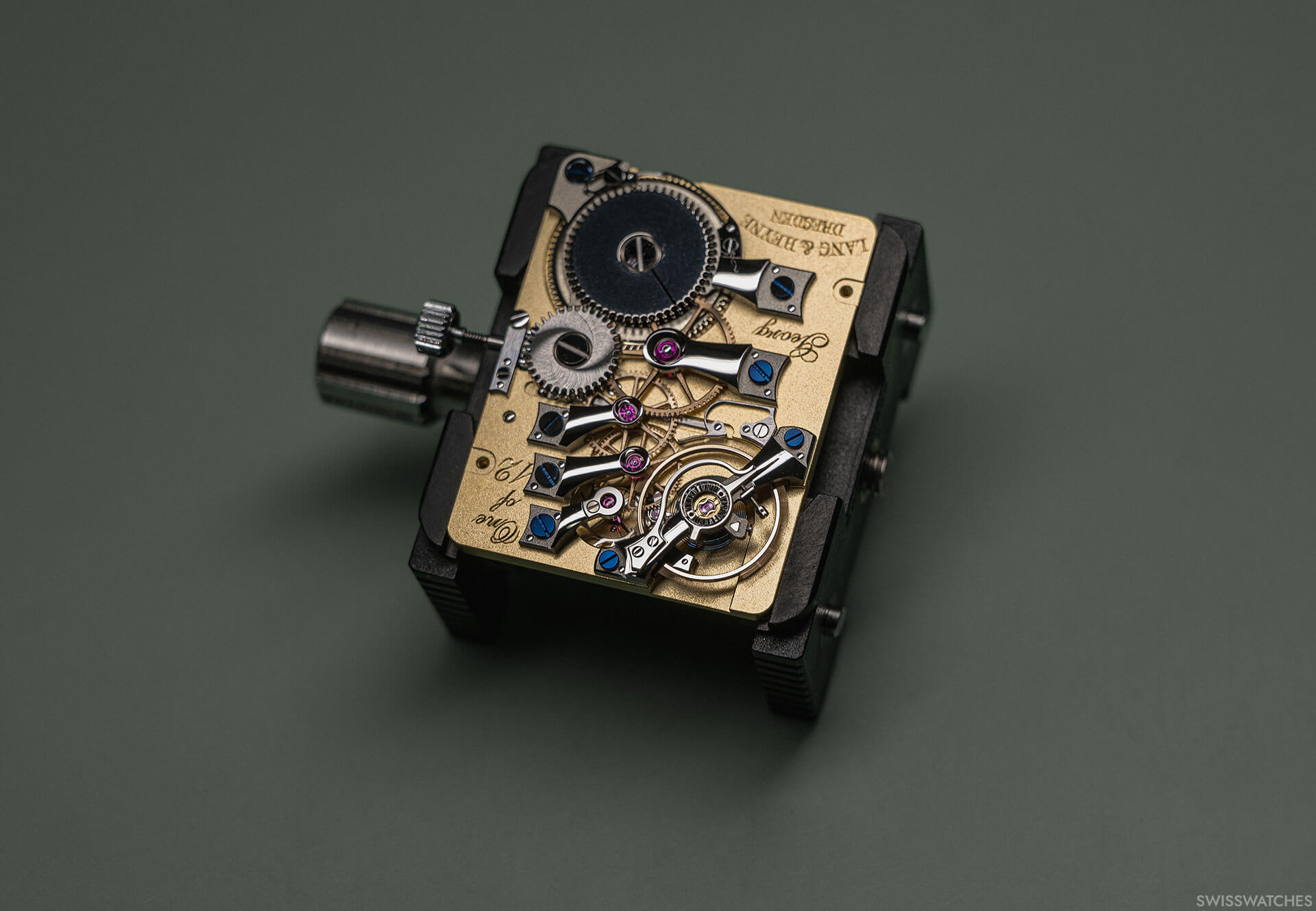
During assembly, the watch is taken apart several times, which smears the oils and can lead to contamination. If all components mesh smoothly during pre-assembly, the movement is taken apart again, thoroughly cleaned and oiled, and reassembled and fine-tuned under sterile conditions. Finally, a 14-day test cycle is carried out.

The Royal collection
If you follow the cultural trails of Dresden, you will find a mural over 100 metres long at the back of the Stallhof, which is part of the Dresden Residential Palace, on which the Saxon electors and kings of the House of Wettin can be seen in 23,000 tiles made of Meissen porcelain. To celebrate this Saxon history and craftsmanship, the watch models at Lang & Heyne are named after kings from the 800-year Saxon history of the House of Wettin.
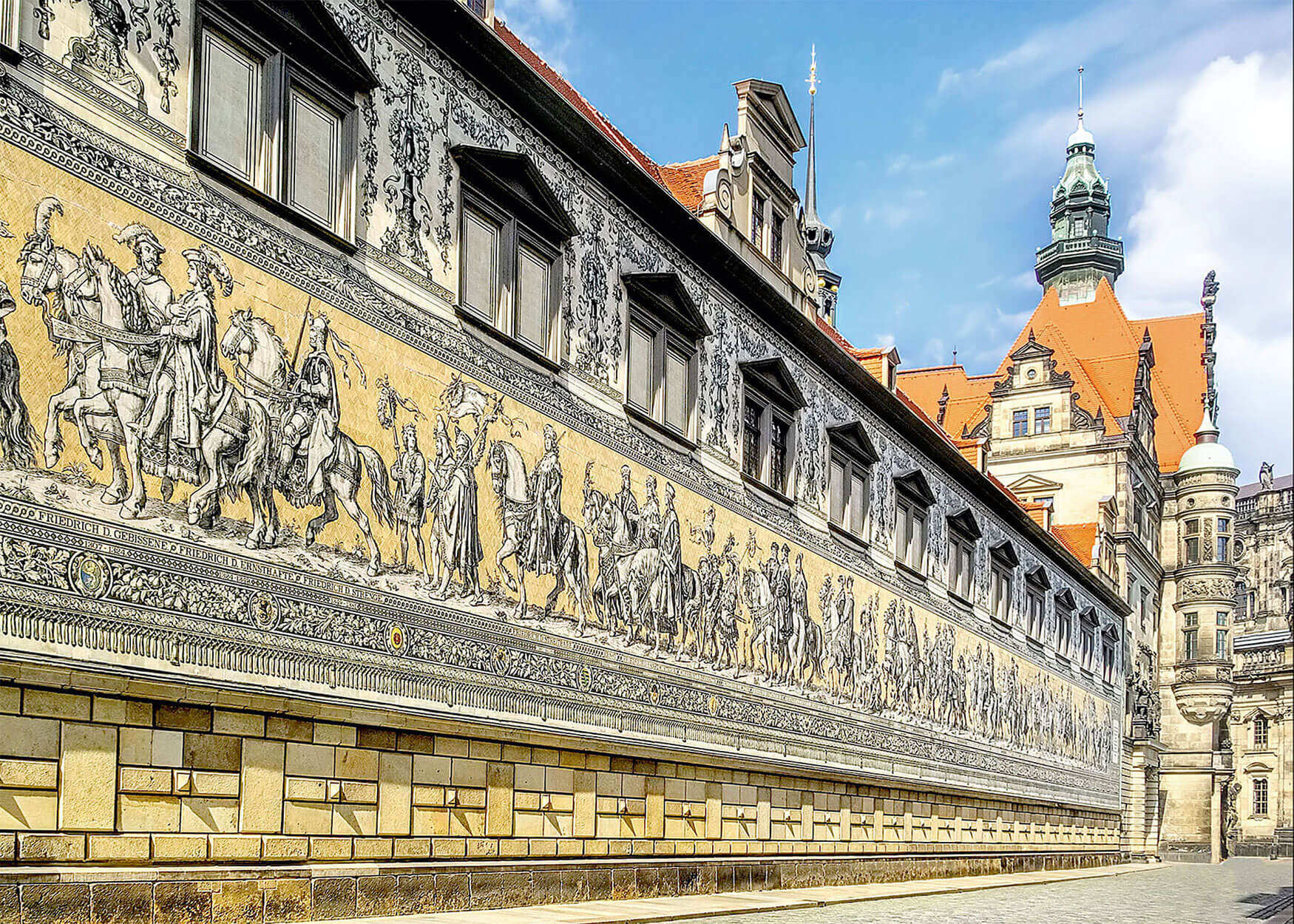
The current collections have therefore been given names such as Georg, Anton, Friedrich II, Friedrich III, Friedrich August I and Johann. This background also makes it clear why the watches are labelled “Made in Saxony” and not “Made in Germany” or “Made in Glashütte”, as is the case with other German watchmakers.
Modell Anton (left), Modell Friedrich II (right)
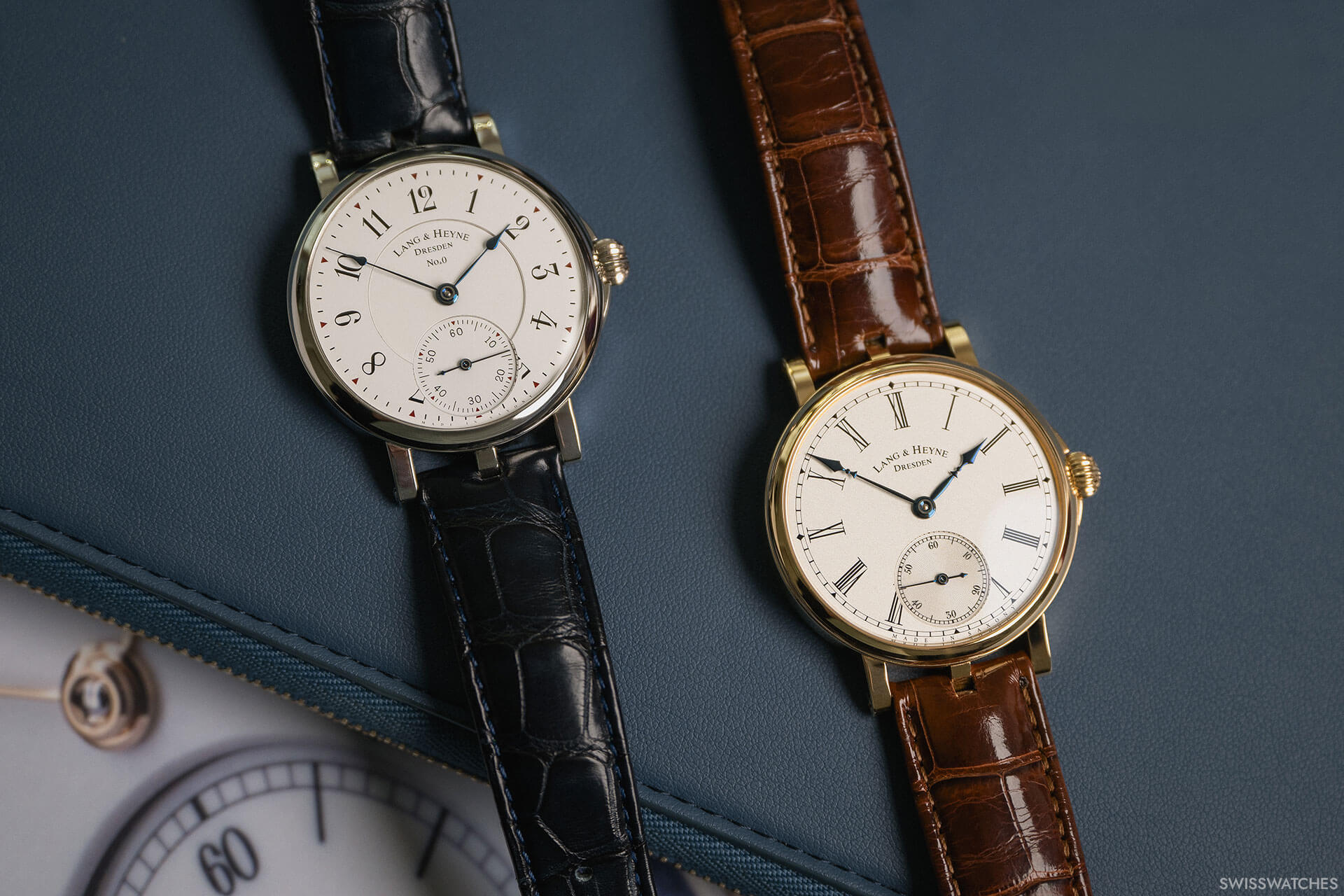
Modell Friedrich II (left), Modell Friedrich III (right)
The still relatively young manufacture has now developed and produced nine of its own calibres, of which the movements (Calibre VIII & Calibre IX) in the Georg and Anton are angular. In addition to hours, minutes and seconds, the functionalities include a full calendar with moonphase and equation display, single-pusher chronographs, a seconds remontoir and a flying tourbillon. A movement with a repeater or perpetual calendar is still missing from the portfolio – but what is not yet, there may yet be.
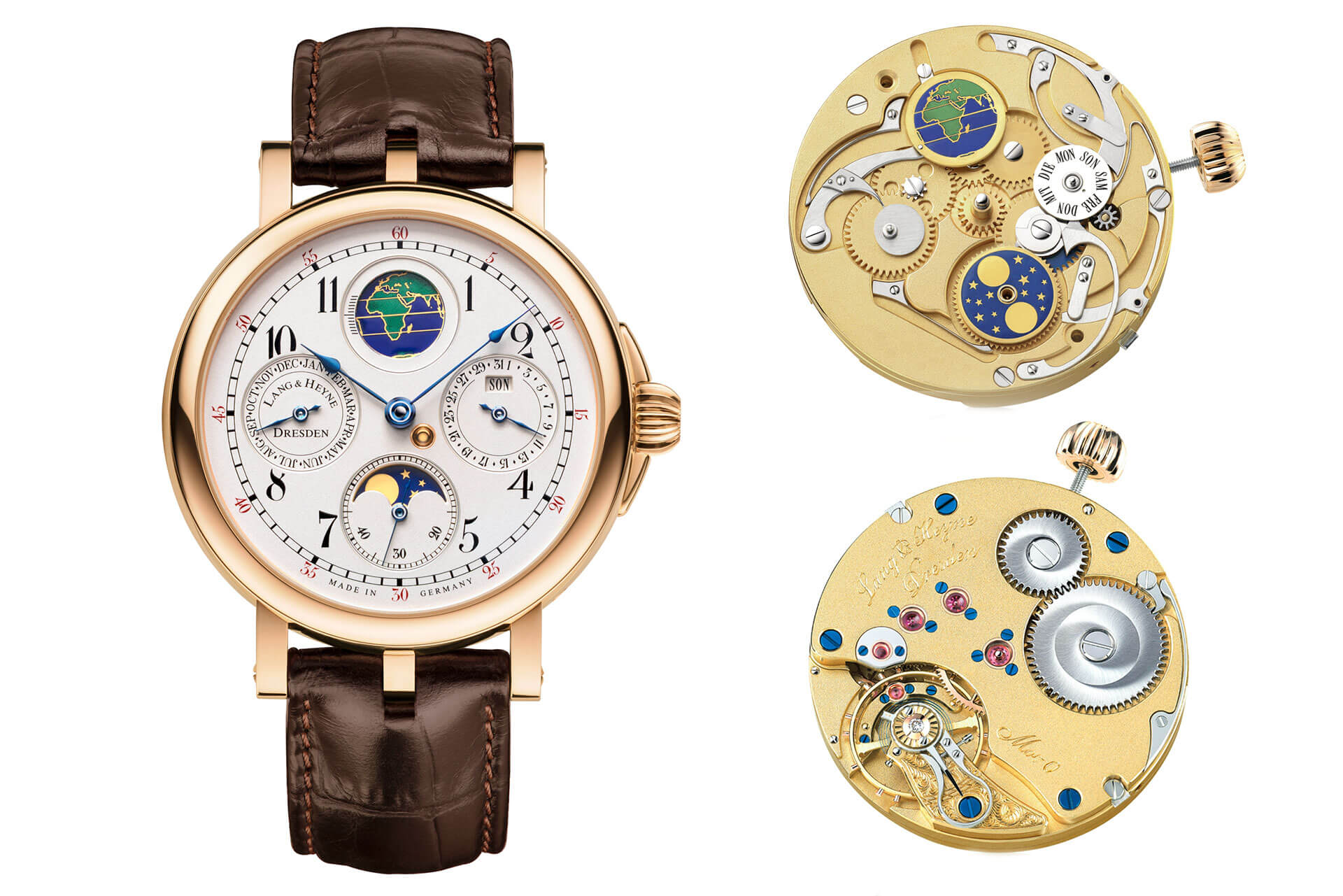
Modell Moritz with its Caliber III
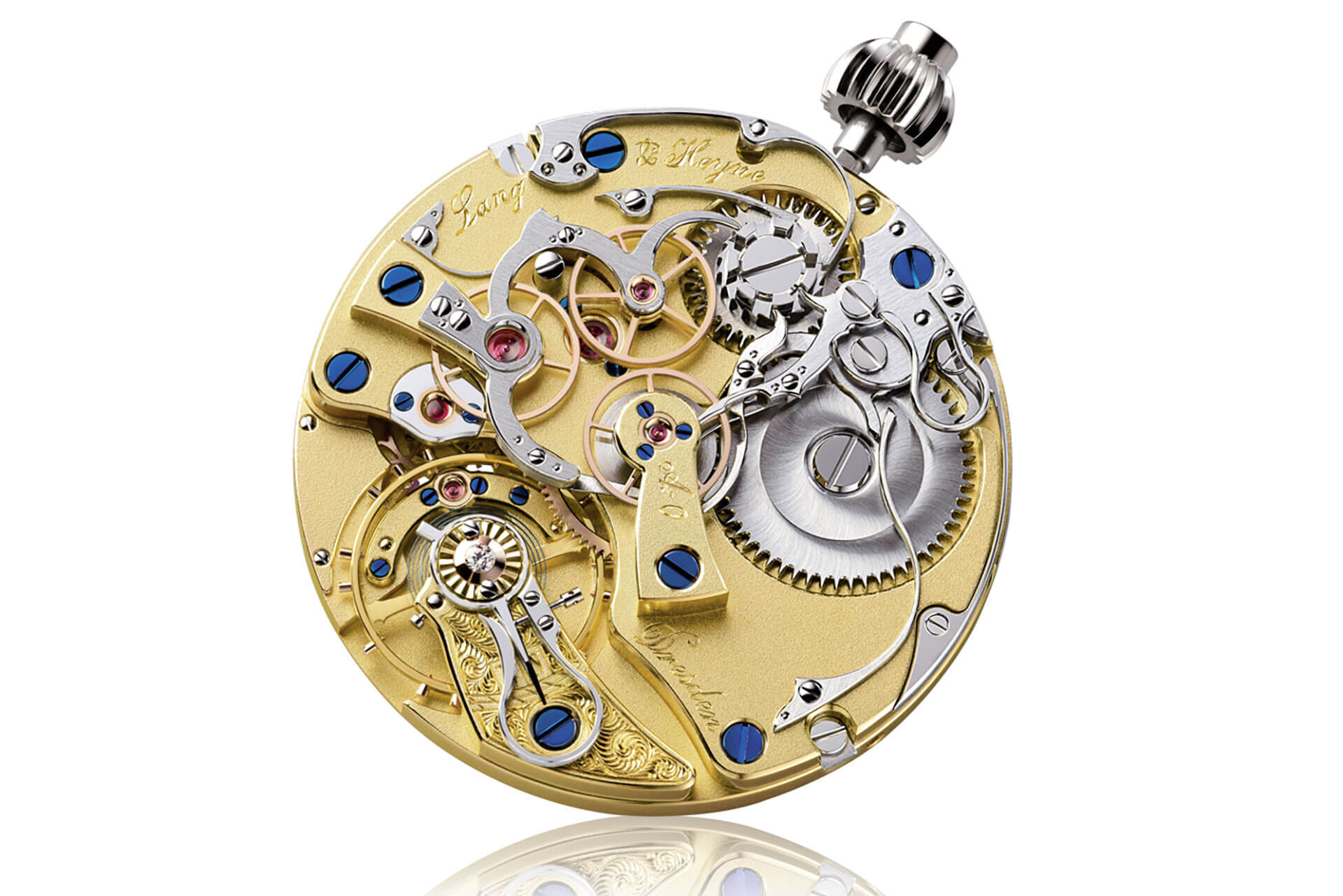
Caliber IV
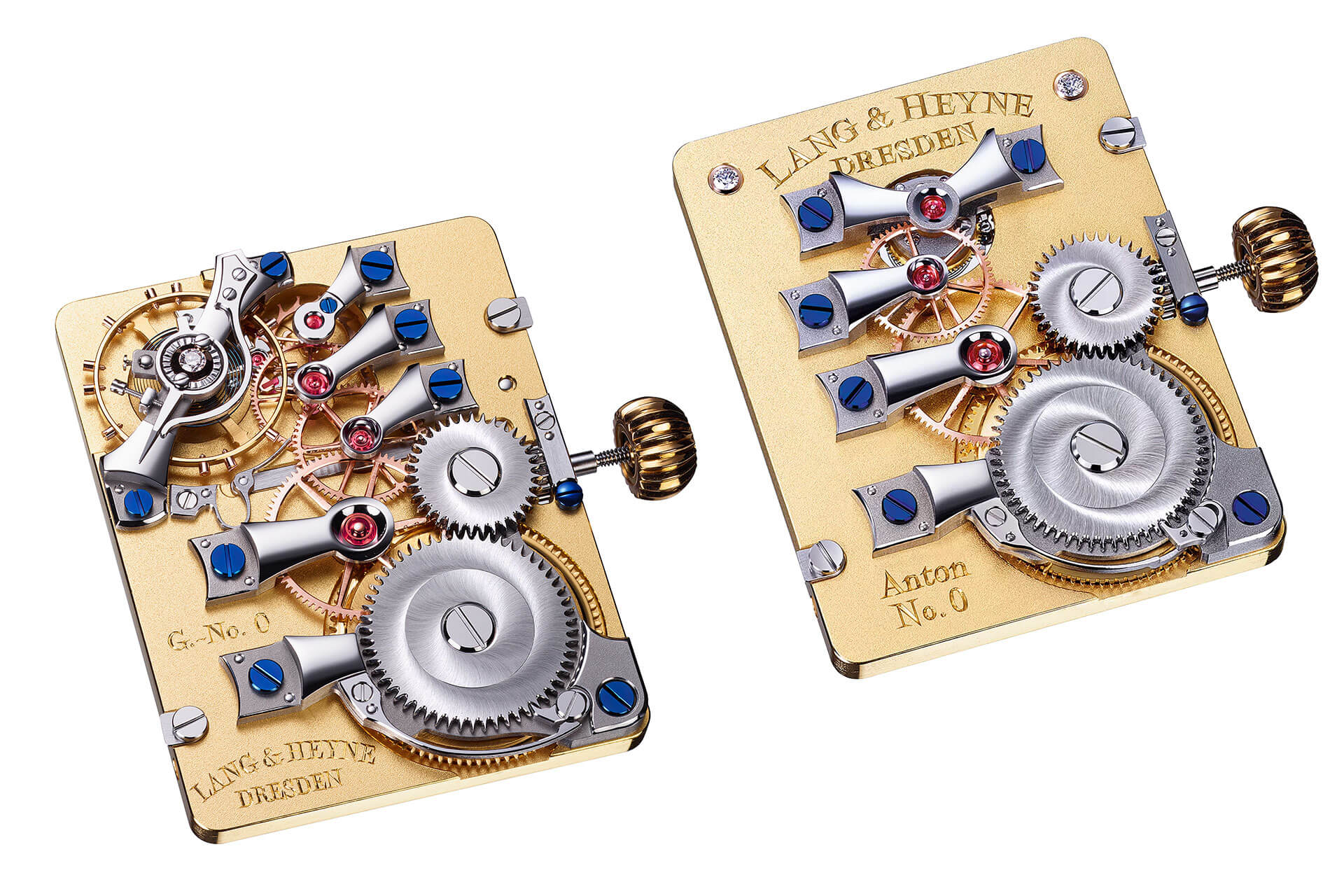
Caliber VIII and Caliber IX
In 2021, Lang & Heyne dared to try its hand at a sporty watch made of stainless steel for the first time with the Hektor. The frame parts and movement wheels are even made of the anti-magnetic high-tech material Arcap. It was available in three dial variants and limited to 99 pieces, which have long been sold out. Even a clientele for predominantly classic watches usually wants a sporty watch in its collection, so it was a logical and smart step for the brand to bring the Hektor to life. A new edition of the Hektor is already being planned for the end of 2024.
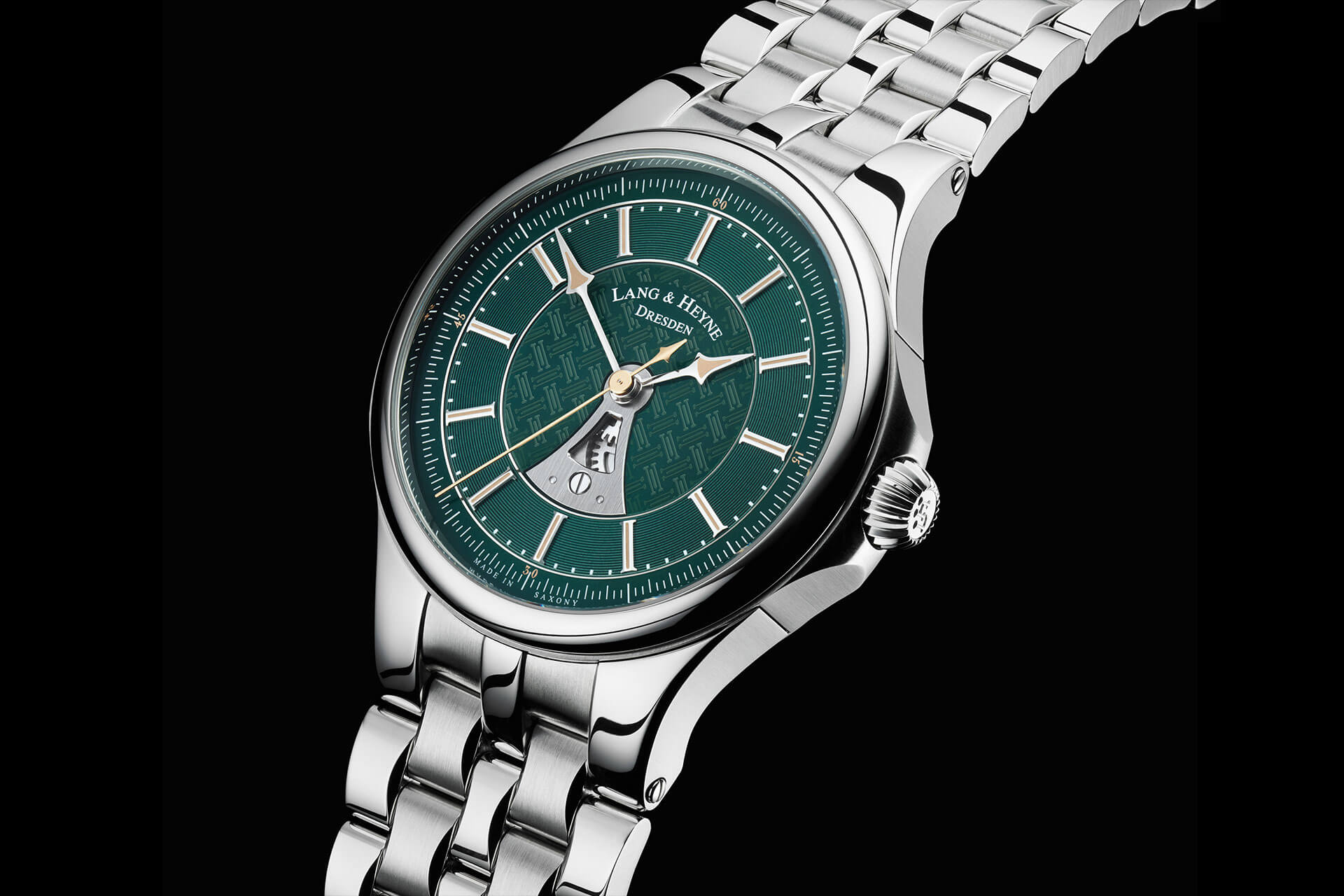
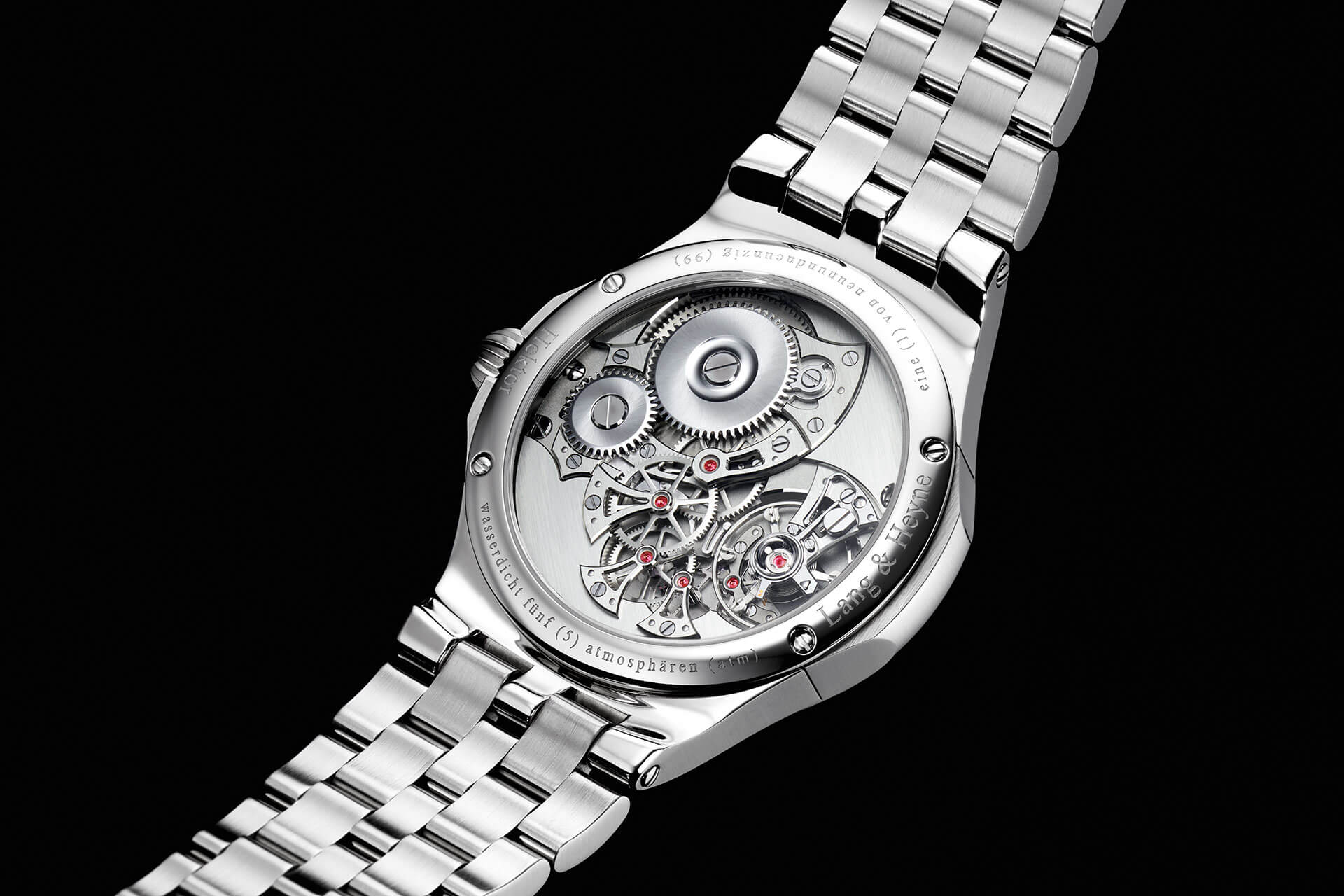
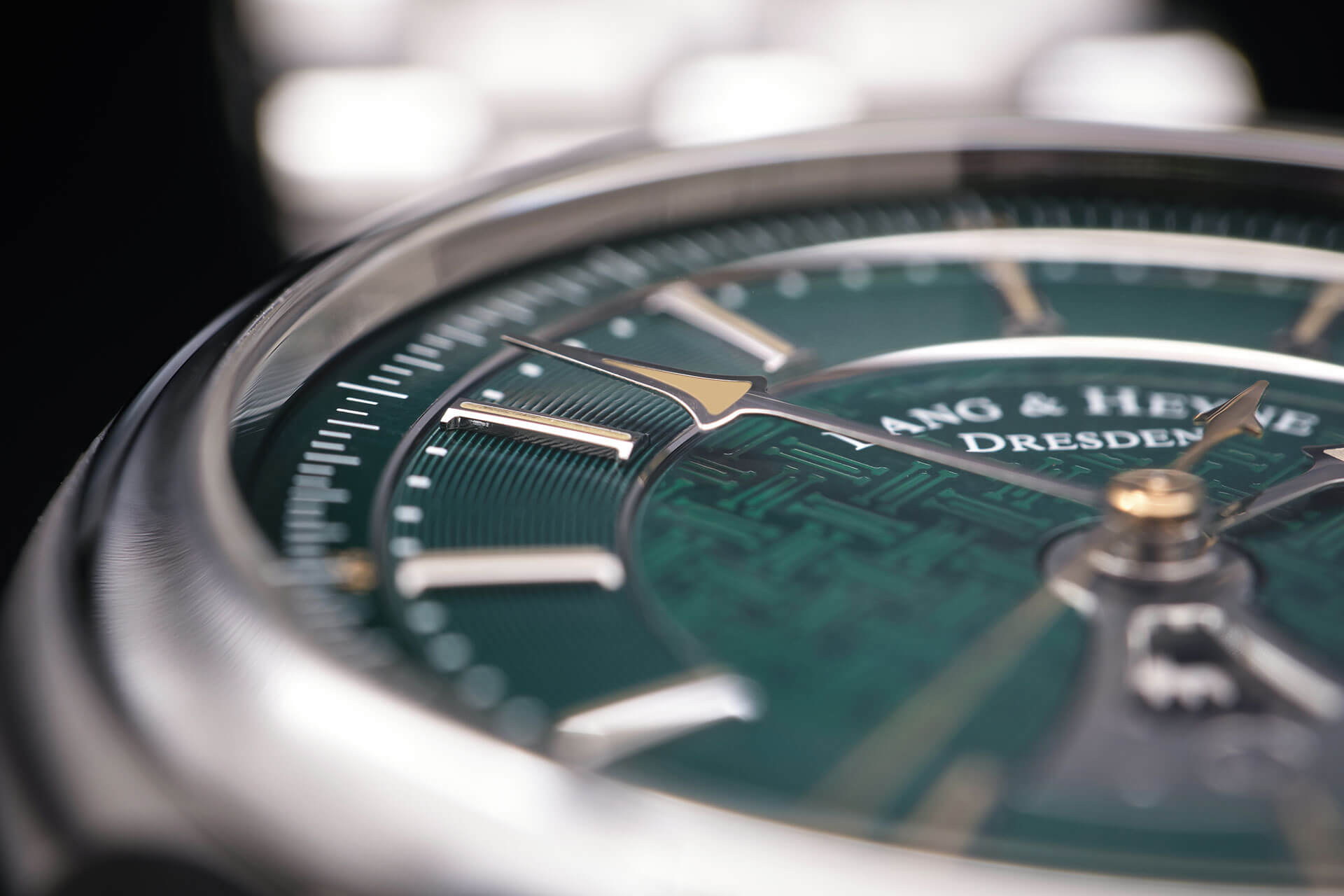
Lang & Heyne Hektor
In addition to stainless steel, precious metals such as rose gold or platinum are used for all other cases. Since 2016, every Lang & Heyne watch has even been fitted with a rose-gold gear train. The combination of gold (wheel) and steel (pinion) shows better friction ratios than other material pairings. The Calibre VI of the Friedrich II and III was presented in titanium in 2022. The movement, with its unusual materiality, also features a remontoir with a jumping small second at 6 o’clock.
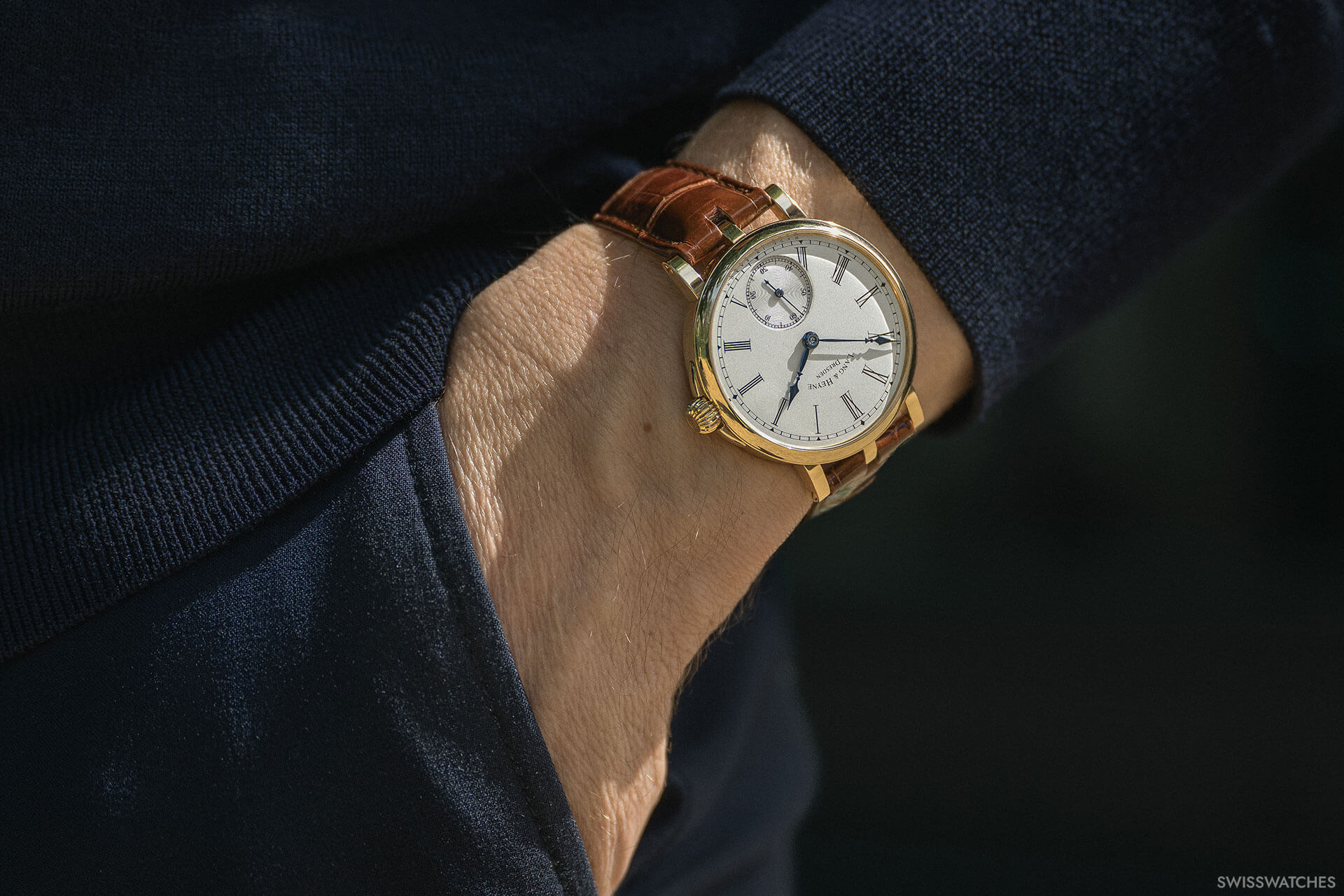
Lang & Heyne Friedrich III
Anyone in Germany or internationally who is interested in a Lang & Heyne timepiece has the opportunity to introduce themselves to very selective authorised partners. They can also write directly to Lang & Heyne to enquire about their desired model and configuration. However, as quantities are so limited anyway, according to the company, only a few watches are likely to be in circulation worldwide. Waiting times are therefore to be expected.
One-off and customised watches
While other manufactures reserve customised and unique pieces for very special occasions and customers, the supreme discipline of watchmaking is an essential part of Lang & Heyne’s work. A large proportion of the watches that leave the manufacture are unique pieces that are created at the customer’s behest. Nevertheless, the customer’s wishes must always fit in with Lang & Heyne’s ideas and respect the brand’s DNA. The usual design options include engravings in the movement, caseback covers with engravings, stone setting in the crown, as well as different hand and dial variants.
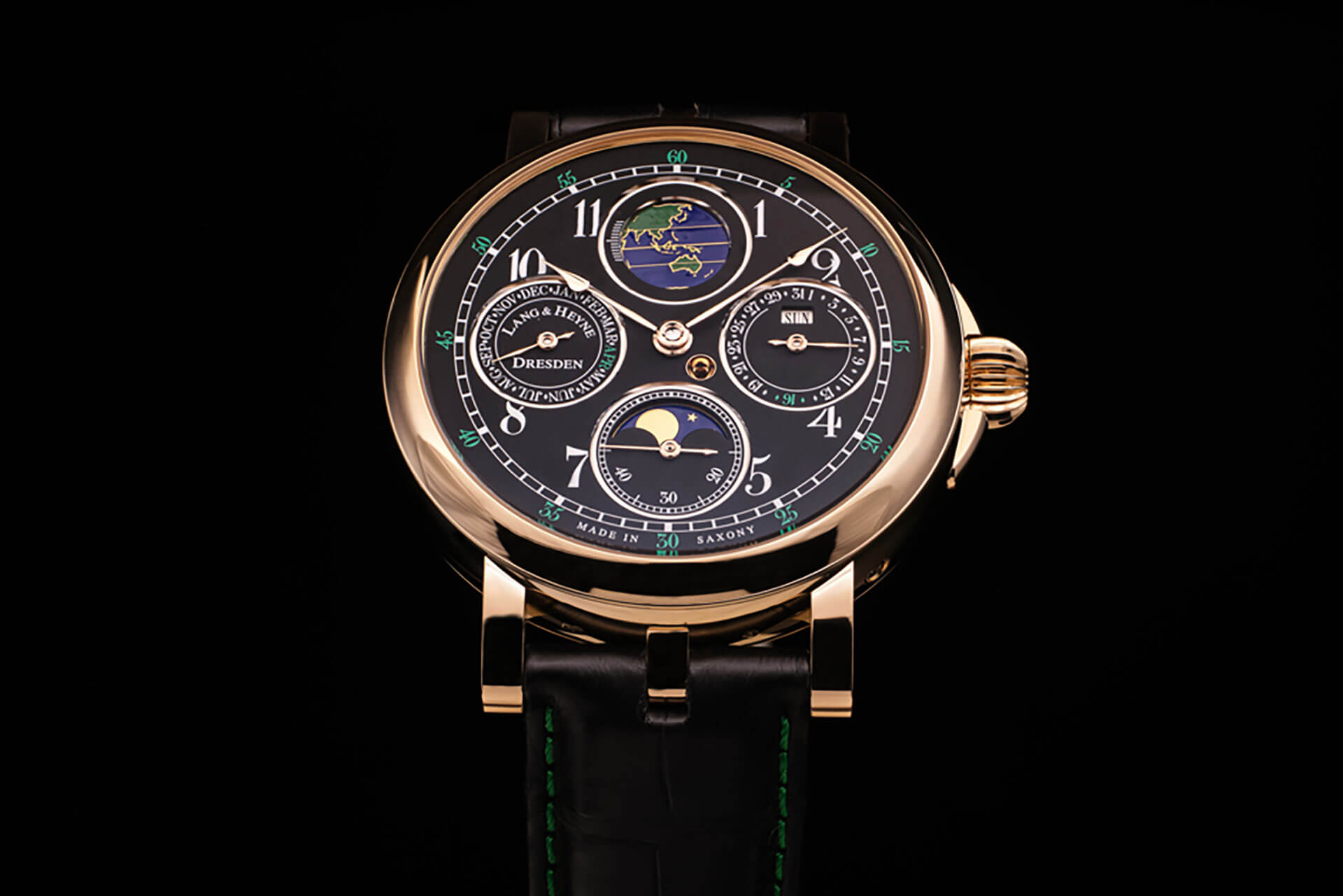
Special Edition of a Moritz
The manufacture recently delivered a unique piece from the Friedrich III collection for a customer, which the new owner christened “Terra”. The champlevé enamel dial was produced in three shades of jade green. A matching green jade stone is set into the crown, and the synthetic ruby jewels are also green. The case and the hand-finished cathedral hands are made of rose gold. Another special feature of this unique piece are the black polished screws, which have not been blued as is usually the case. The movement is engraved with “pièce unique” and “Terra”.
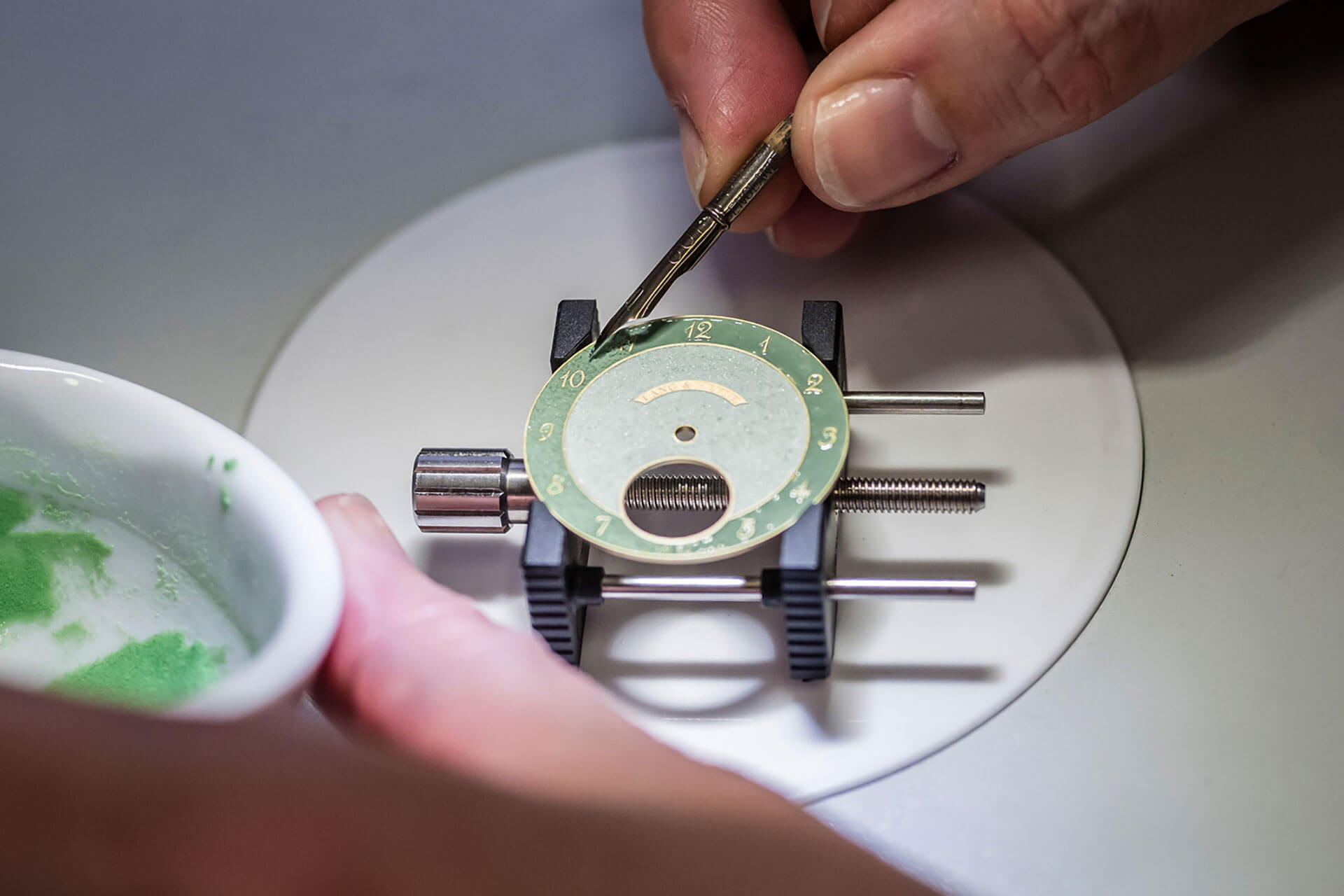
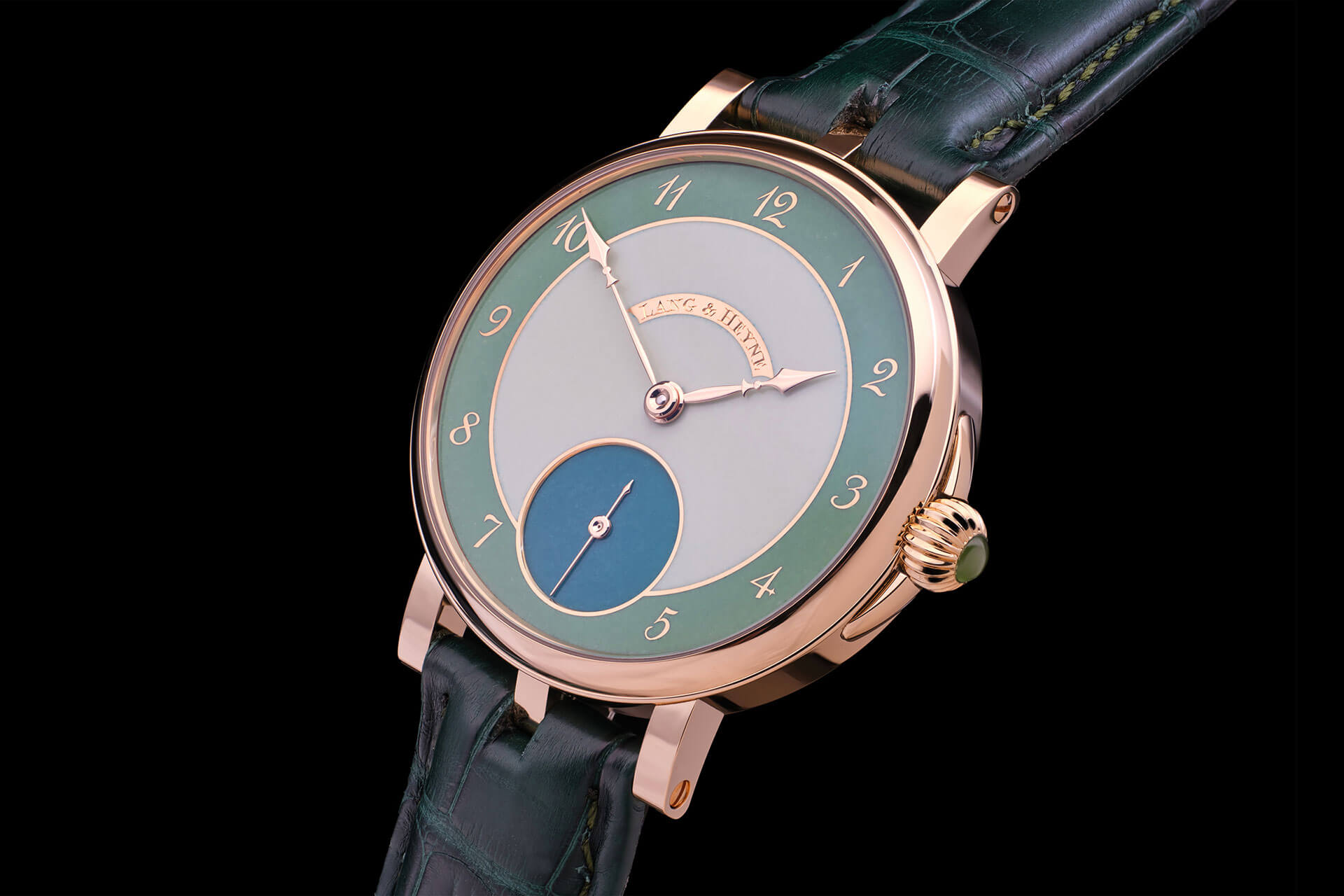
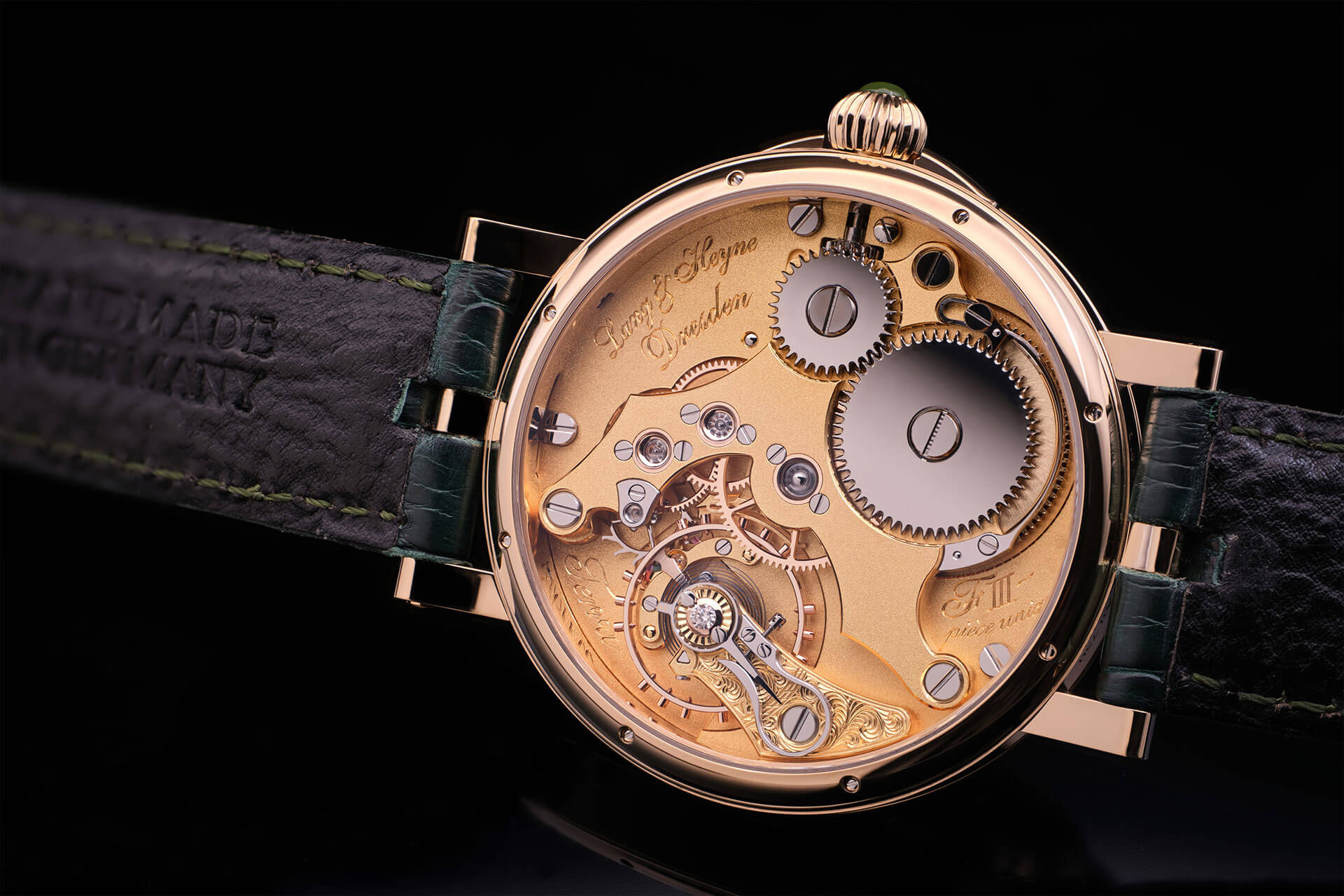
Special Edition Friedrich III Terra
Lang & Heyne presented another watchmaking highlight in 2014 with the Augustus, a custom-made watch whose specially designed Calibre VII mechanically reminds its wearer of special events. To this end, the movement was programmed together with the customer to the anniversaries of twelve special people or events/anniversaries, which are then displayed on the corresponding date with the corresponding name or event.
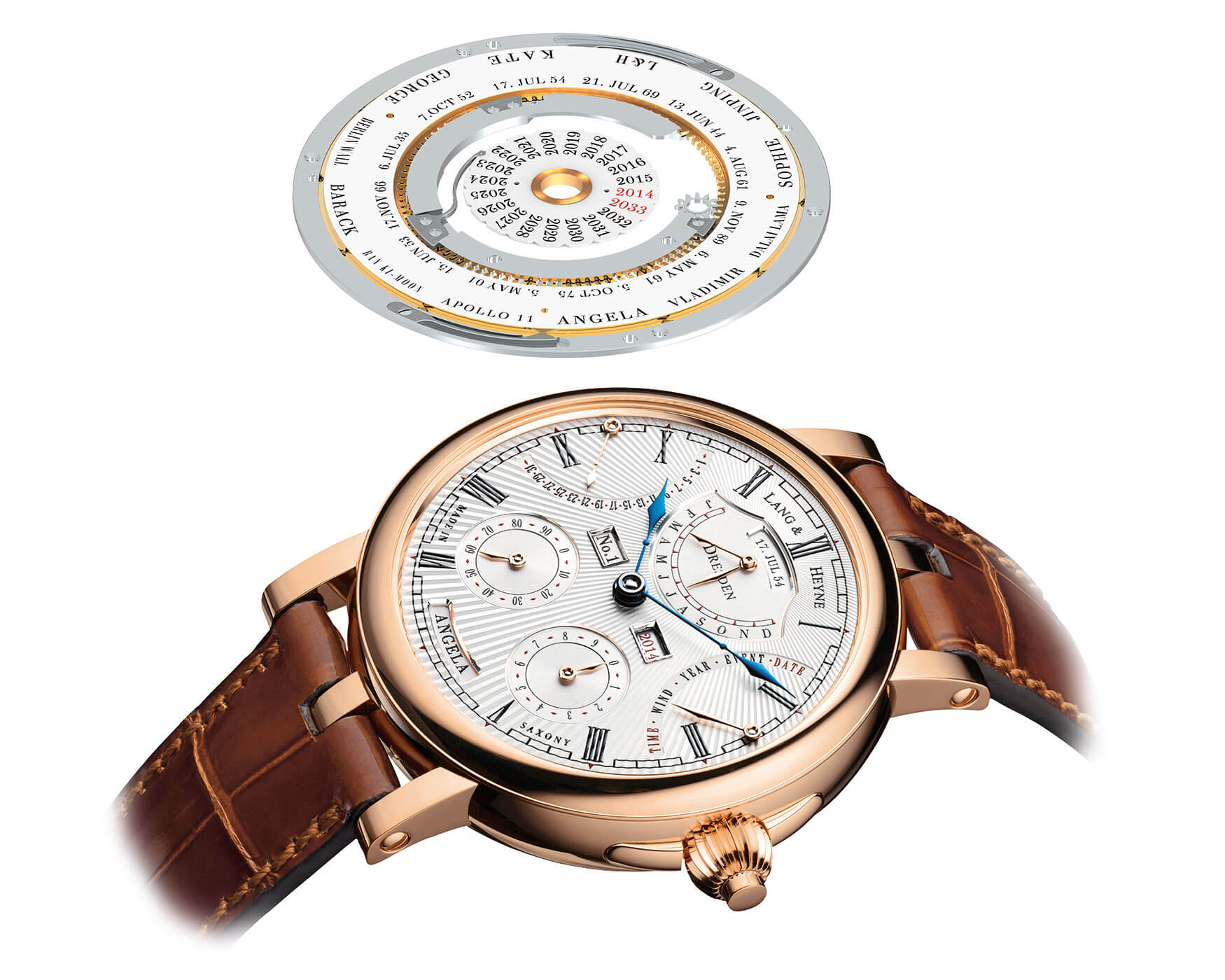
Special Edition Augustus
The Anton Manufacture Edition was presented last year as another exciting special edition, which was not created at the customer’s individual request, but rather appeared in a limited edition of five timepieces. The dial is made of black ceramic on a dark grey, givre-finished base plate with pike hands. The special feature of this watch is undoubtedly the open design of the base plate, which gives the flying tourbillon a new angle and emphasises it even more. Lang & Heyne recently received the Inhorgenta Award 2024 in the “Luxury Watch of the Year” category for this work of art.
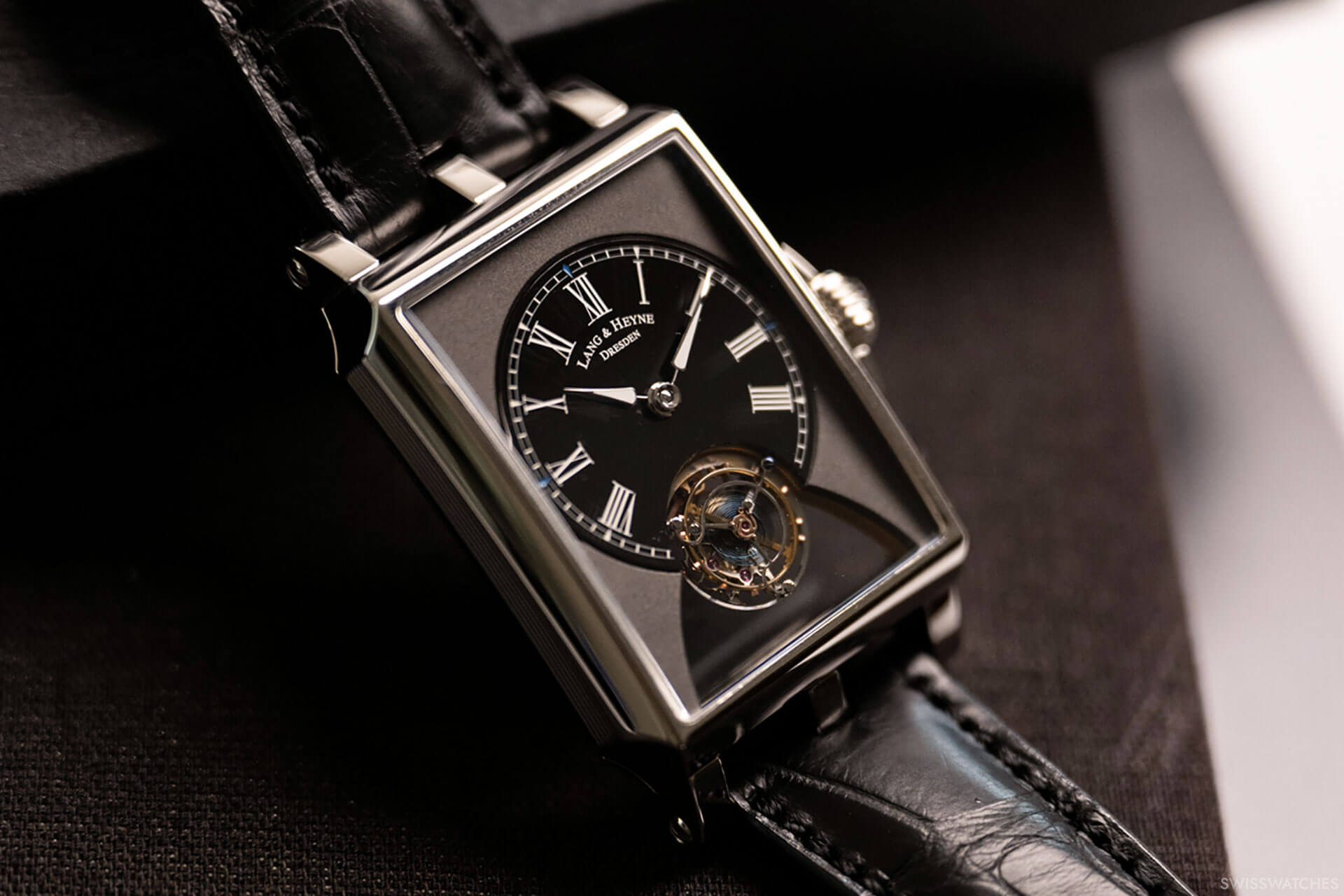
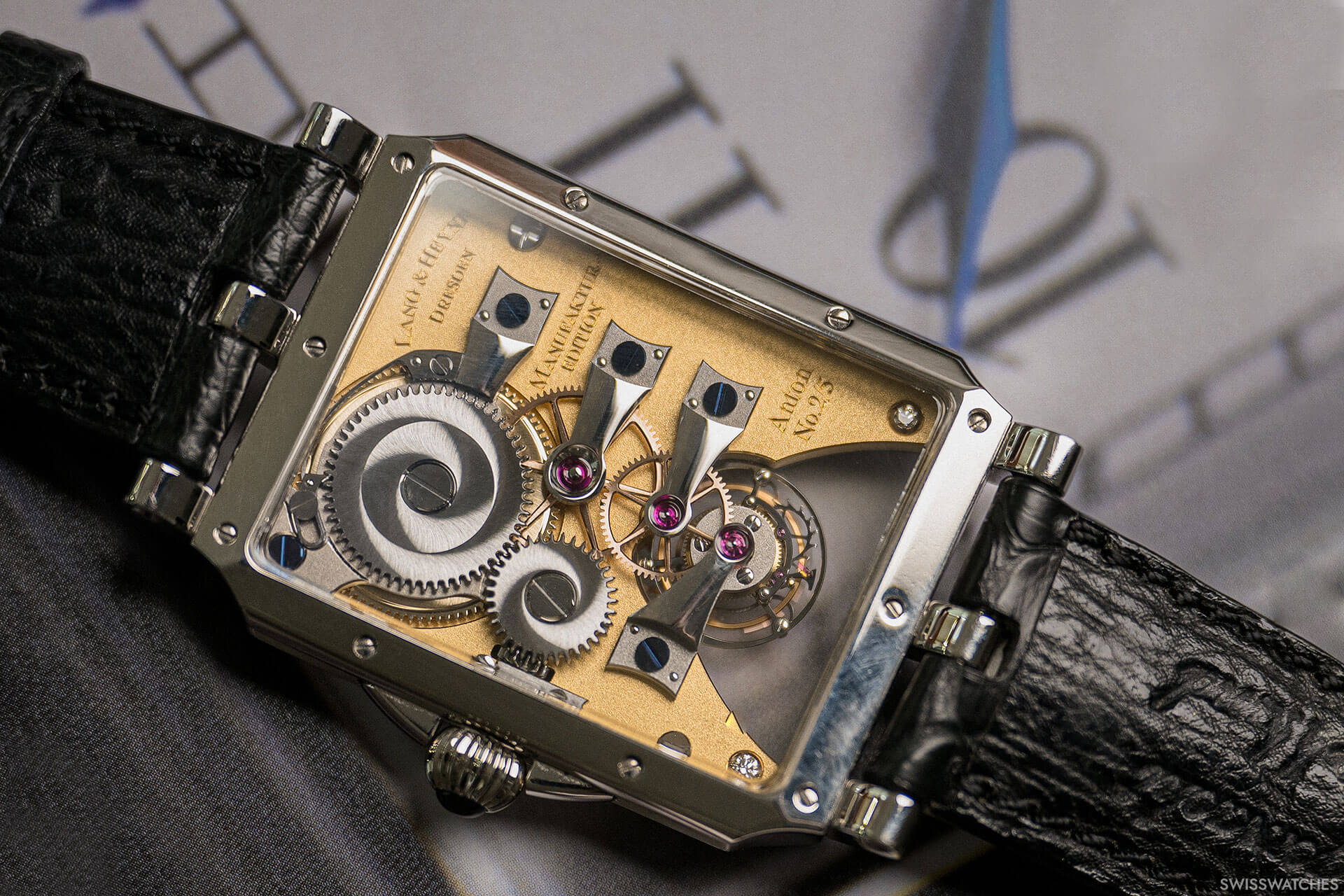
Lang & Heyne Anton Manufaktur Edition, limited to 5 pieces
If you order a custom-made watch from Lang & Heyne, you can collect your watch from the manufacture yourself – including a tour of the manufacture – and see for yourself that “Born in Saxony” is not an ungainly slogan, but a genuine pledge. You will probably feel the same way afterwards, likely looking at fine watchmaking with different eyes. A watch is at its most valuable when it is not just a piece of jewellery, but also a storyteller.
